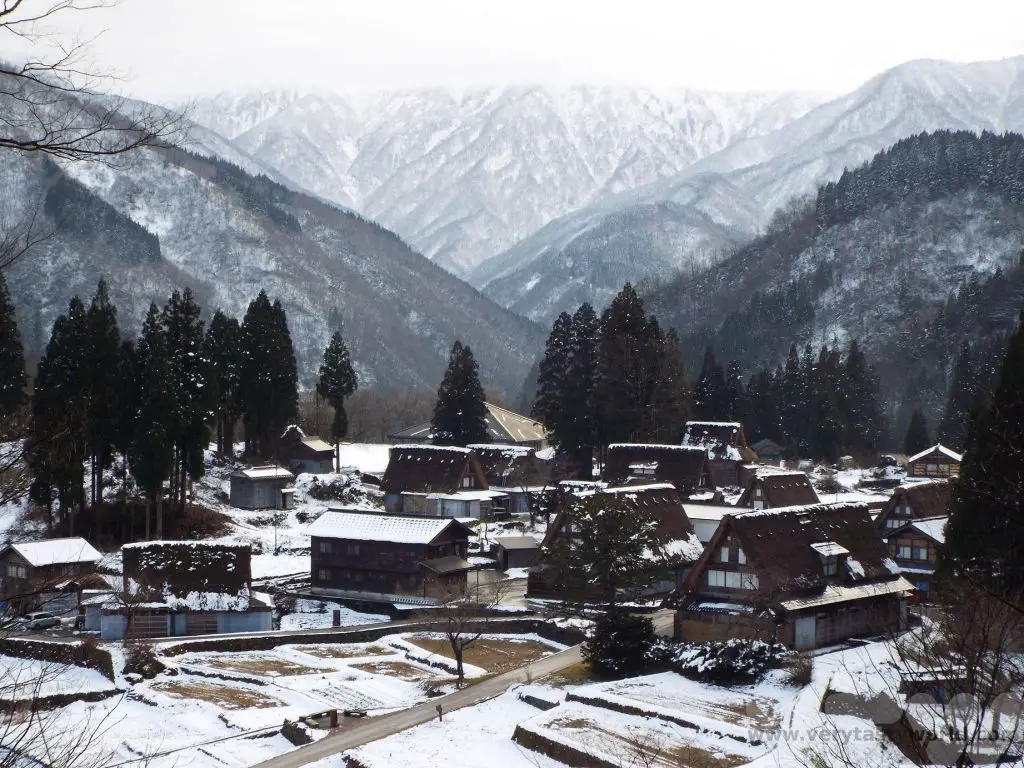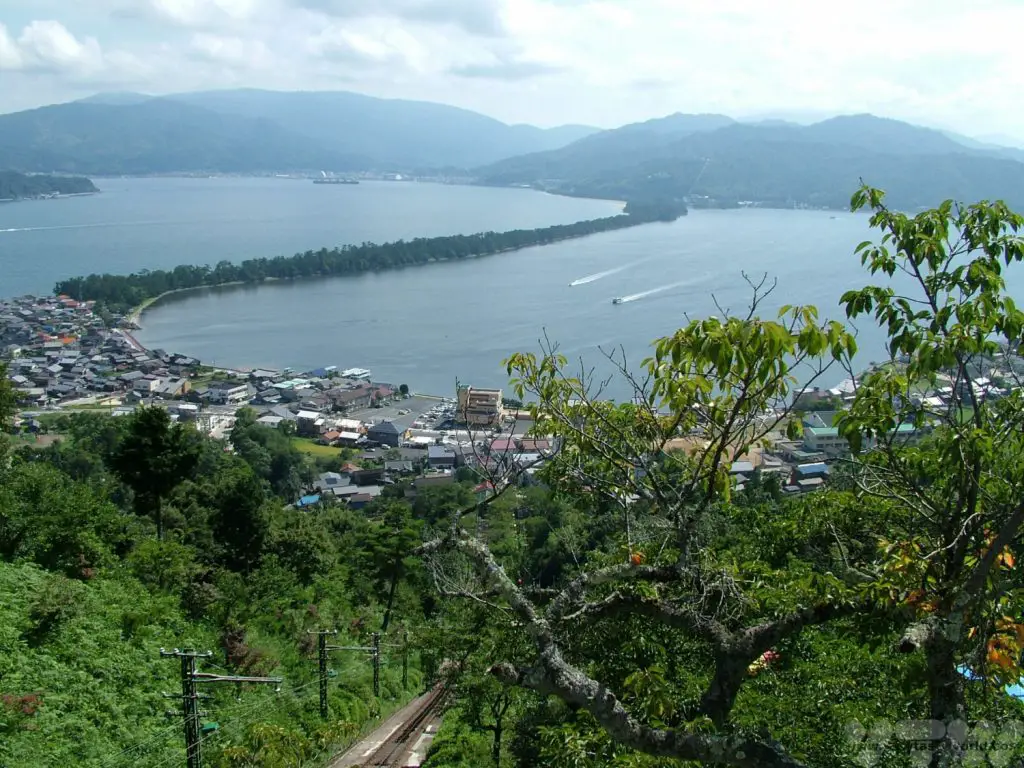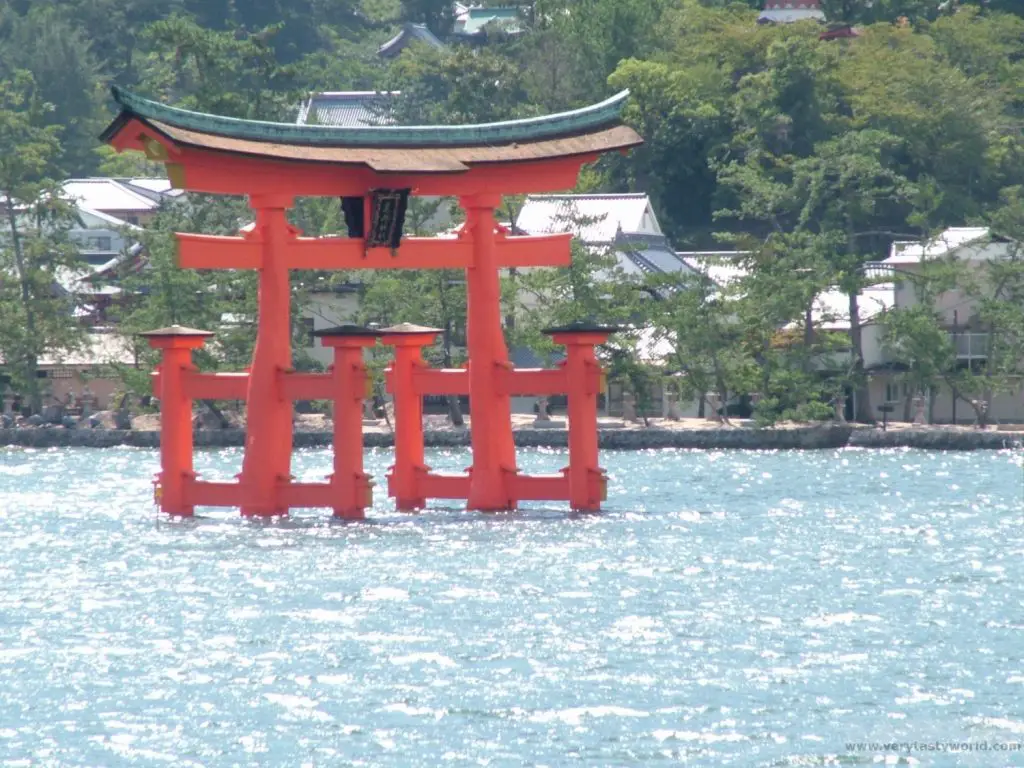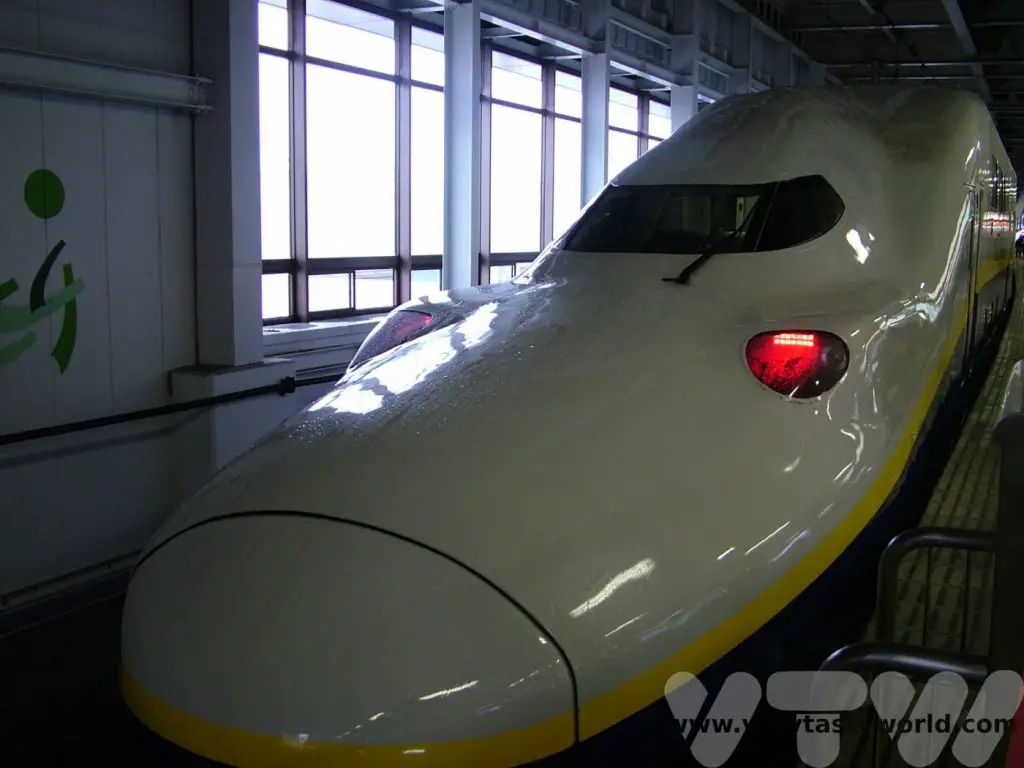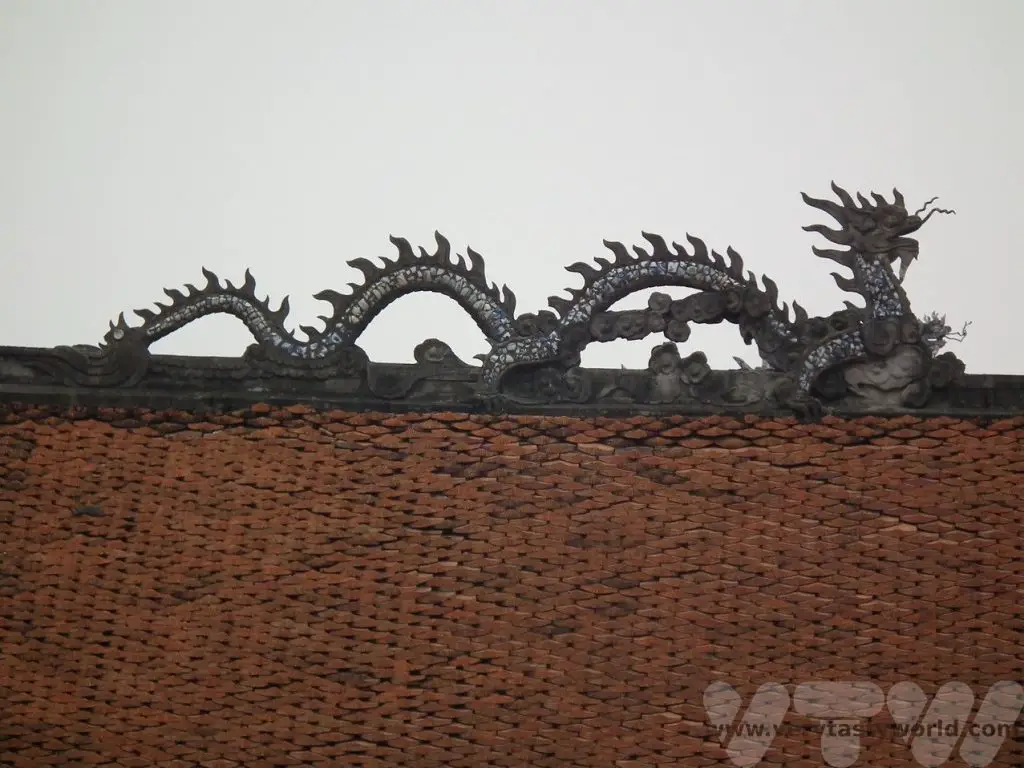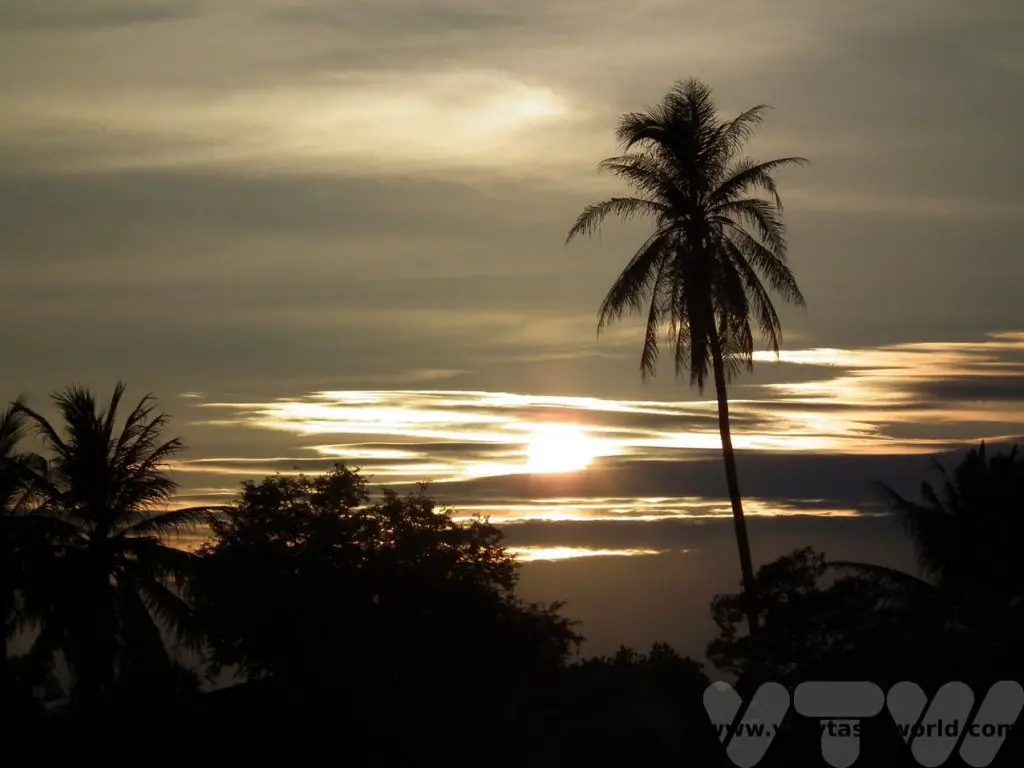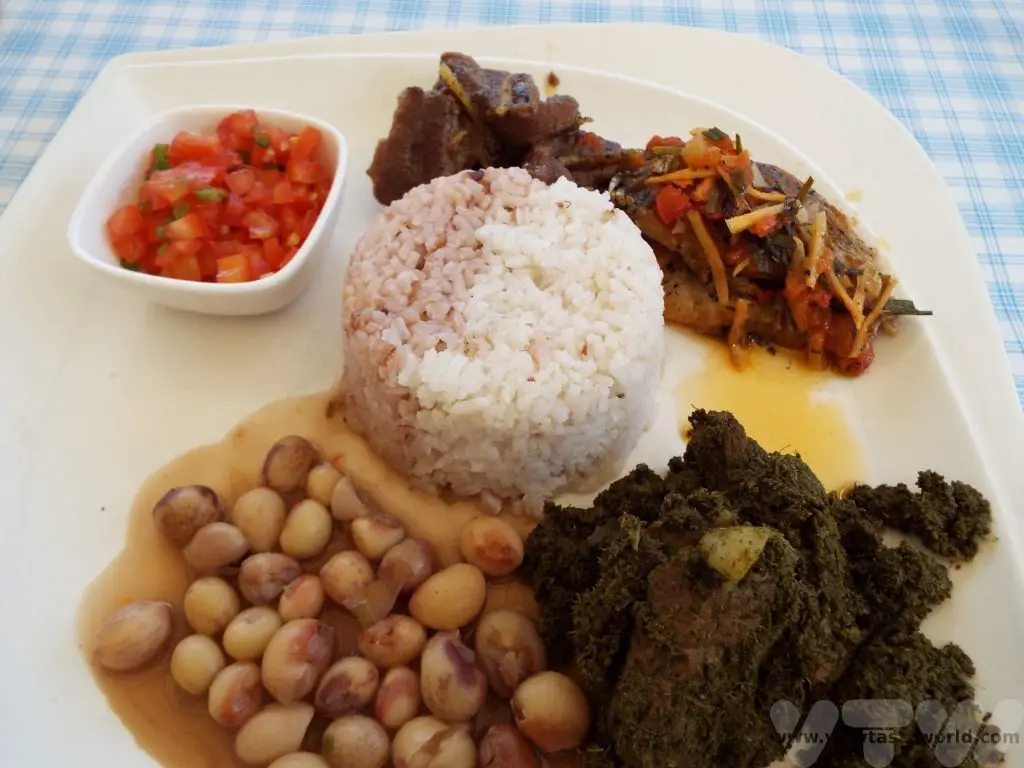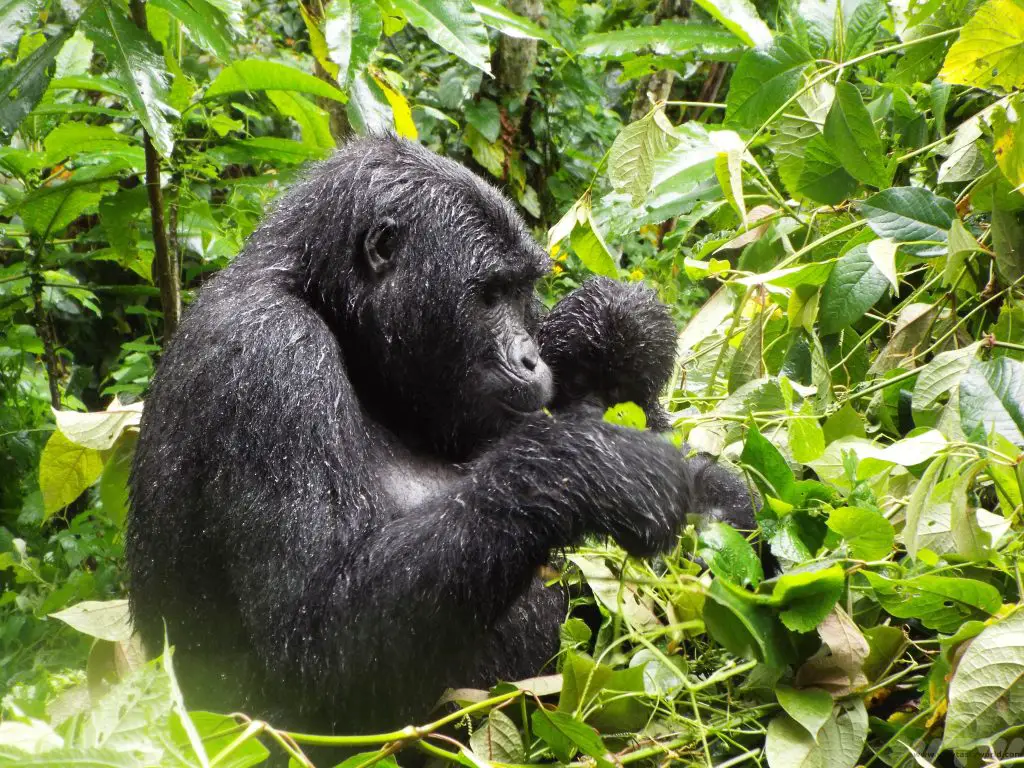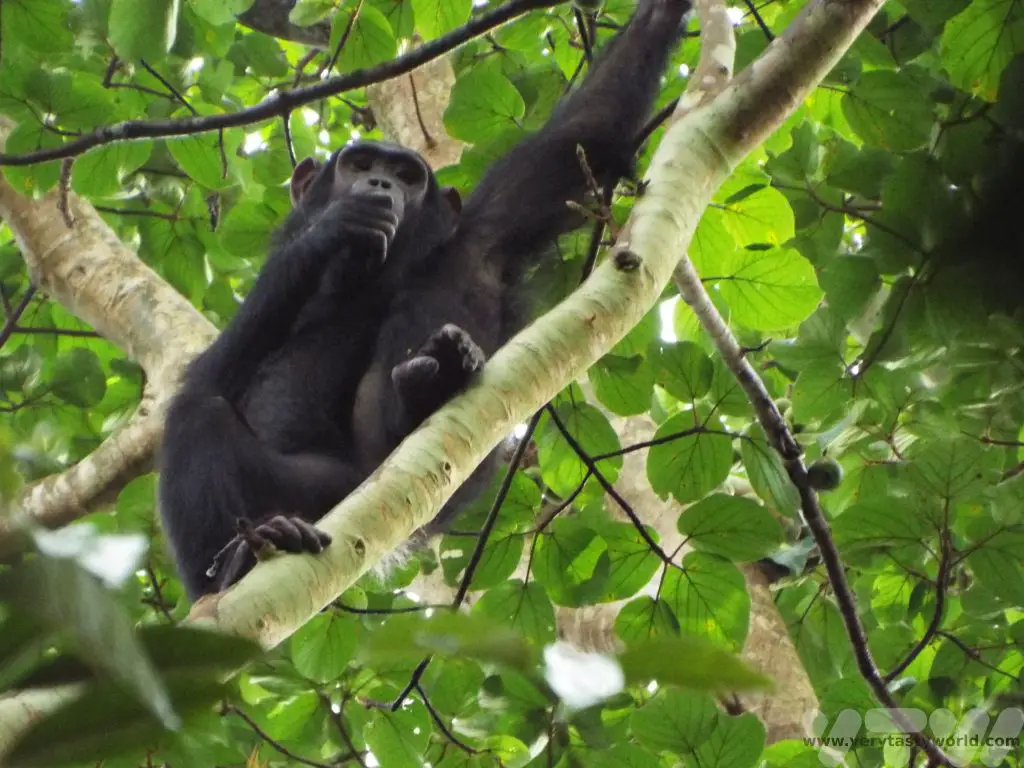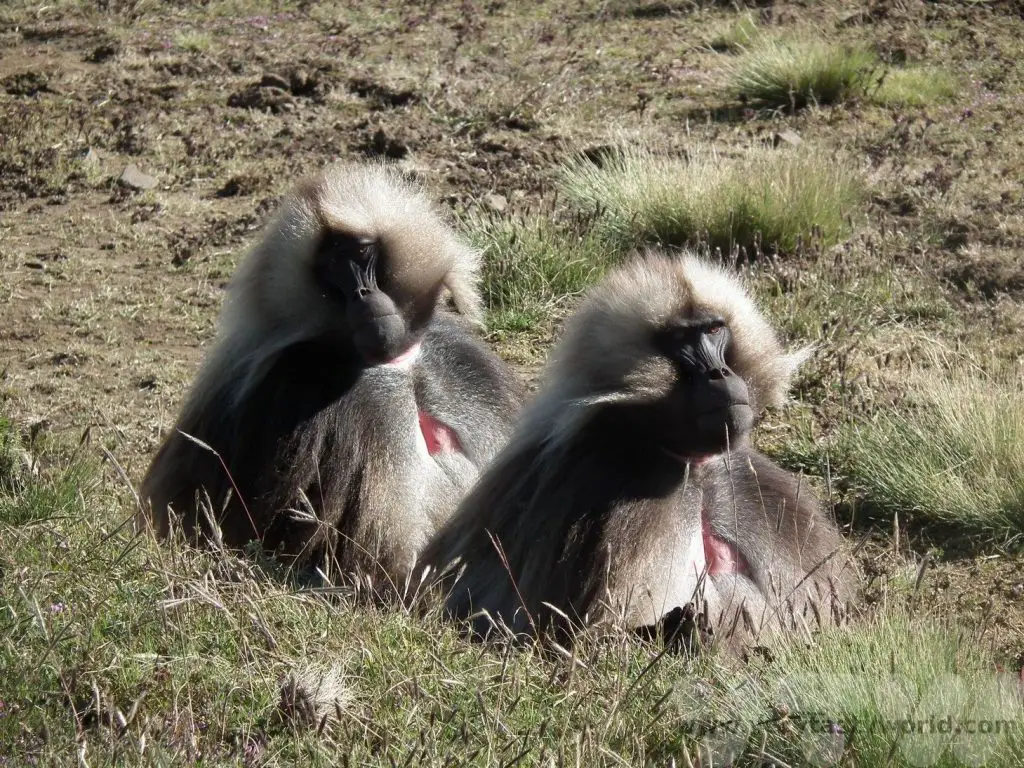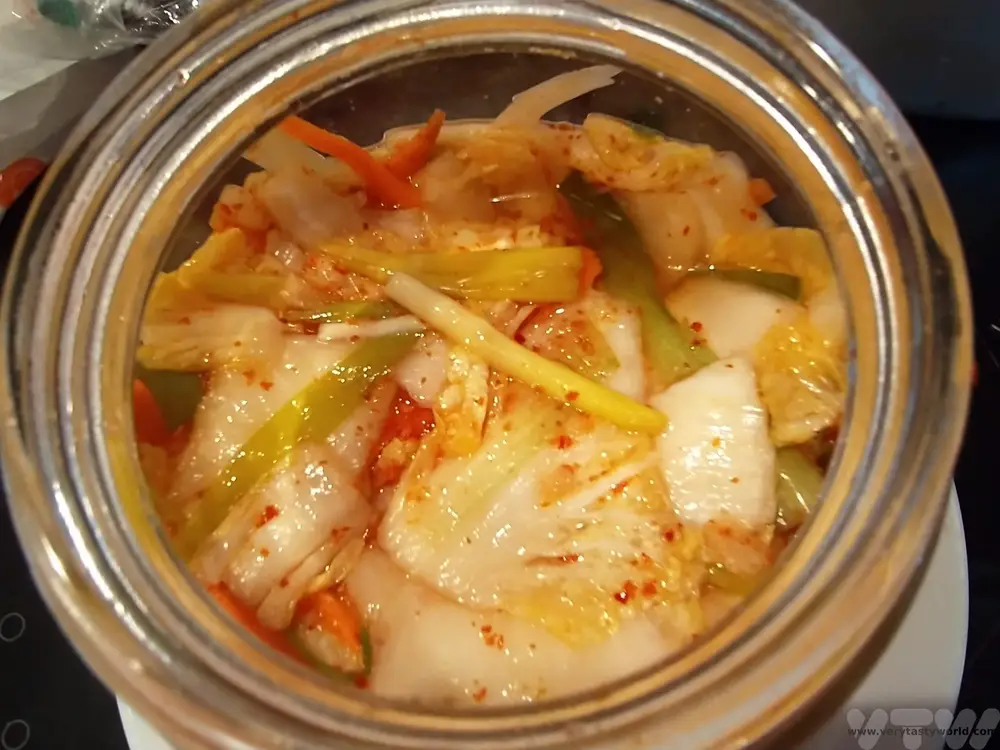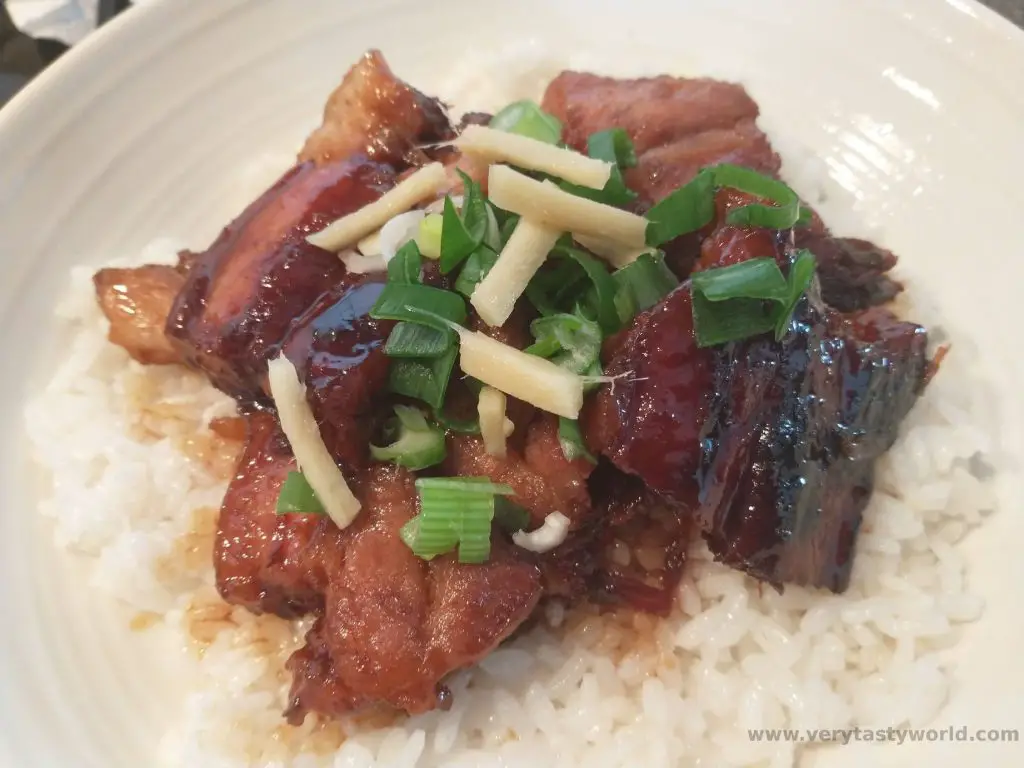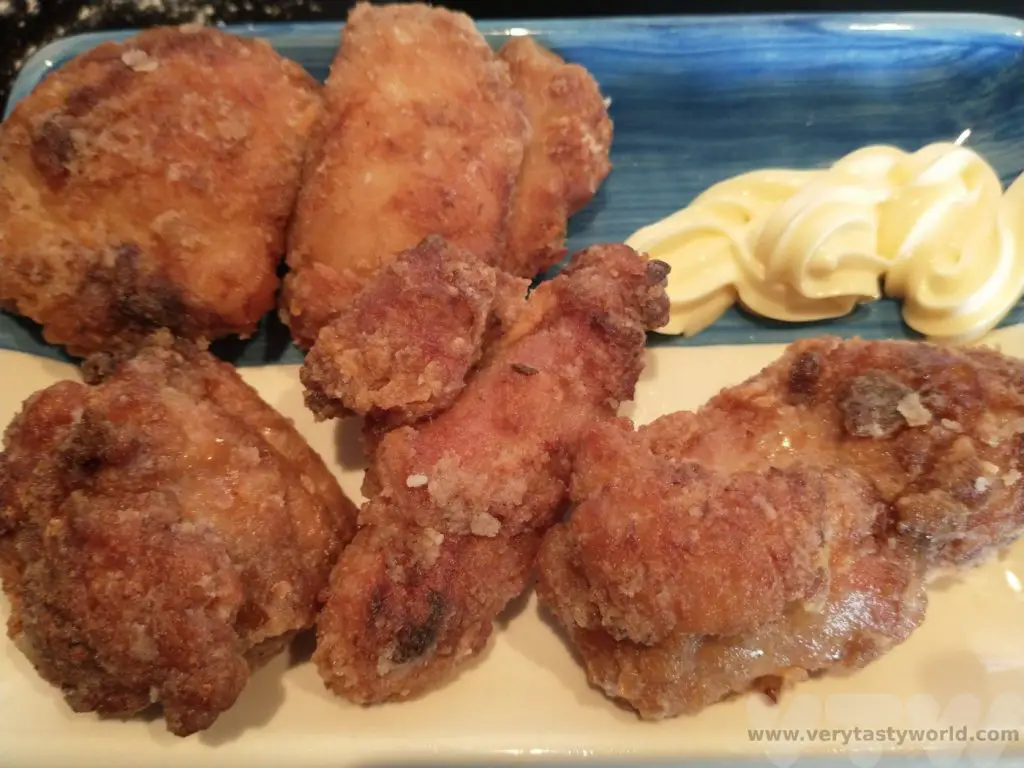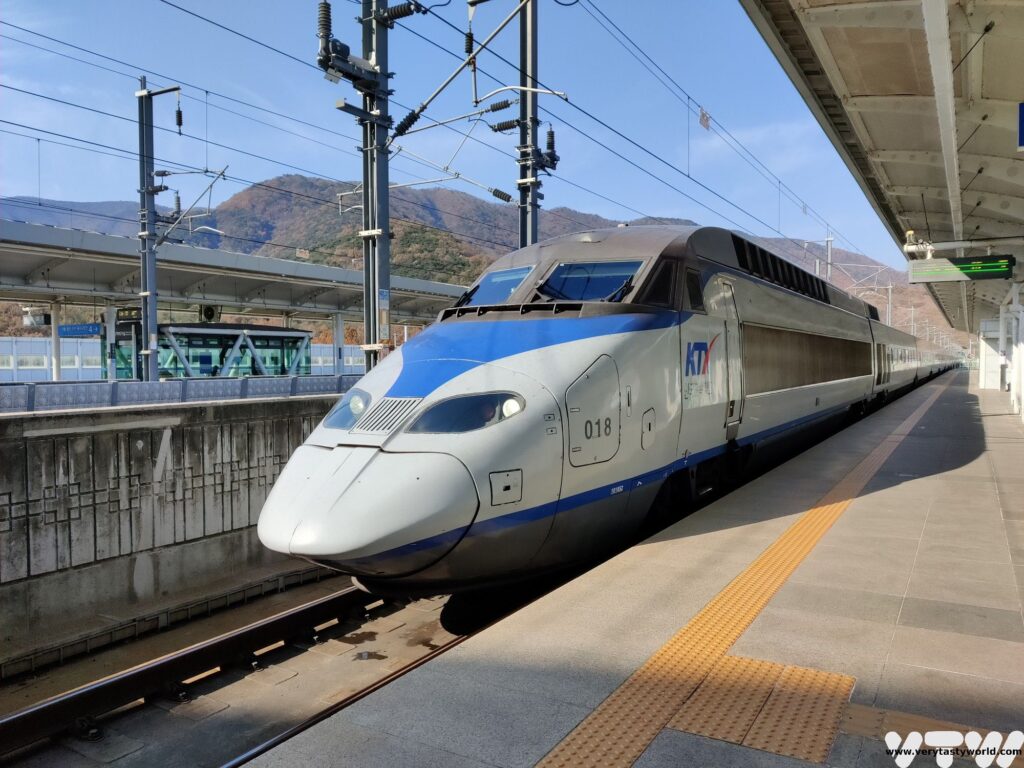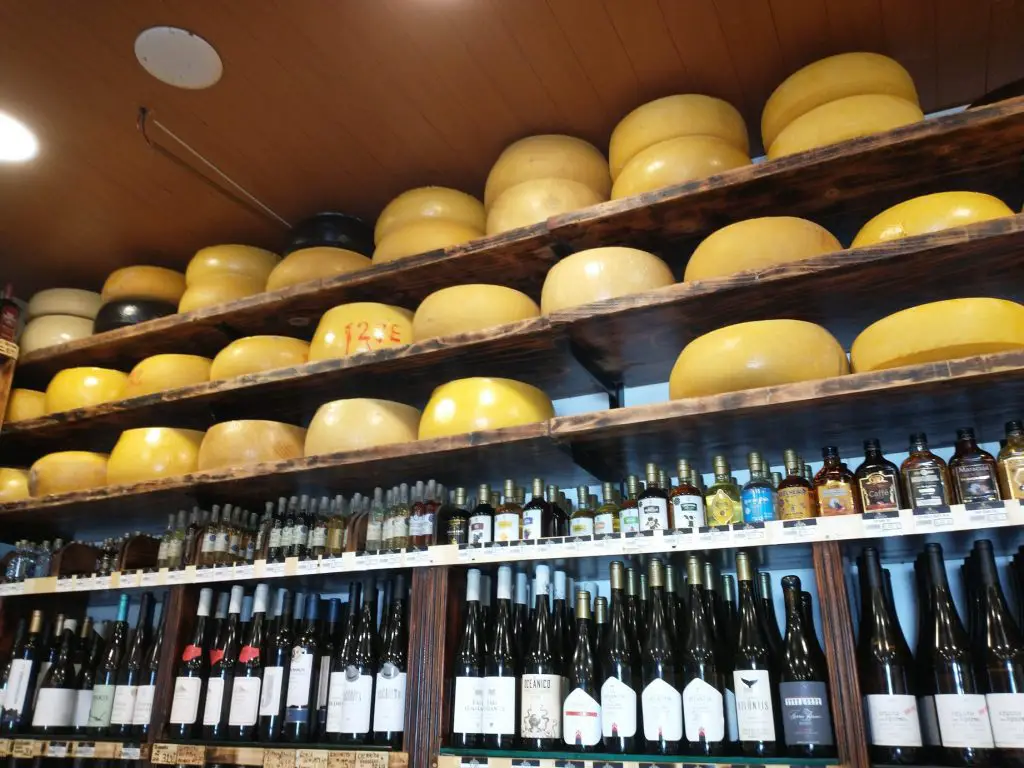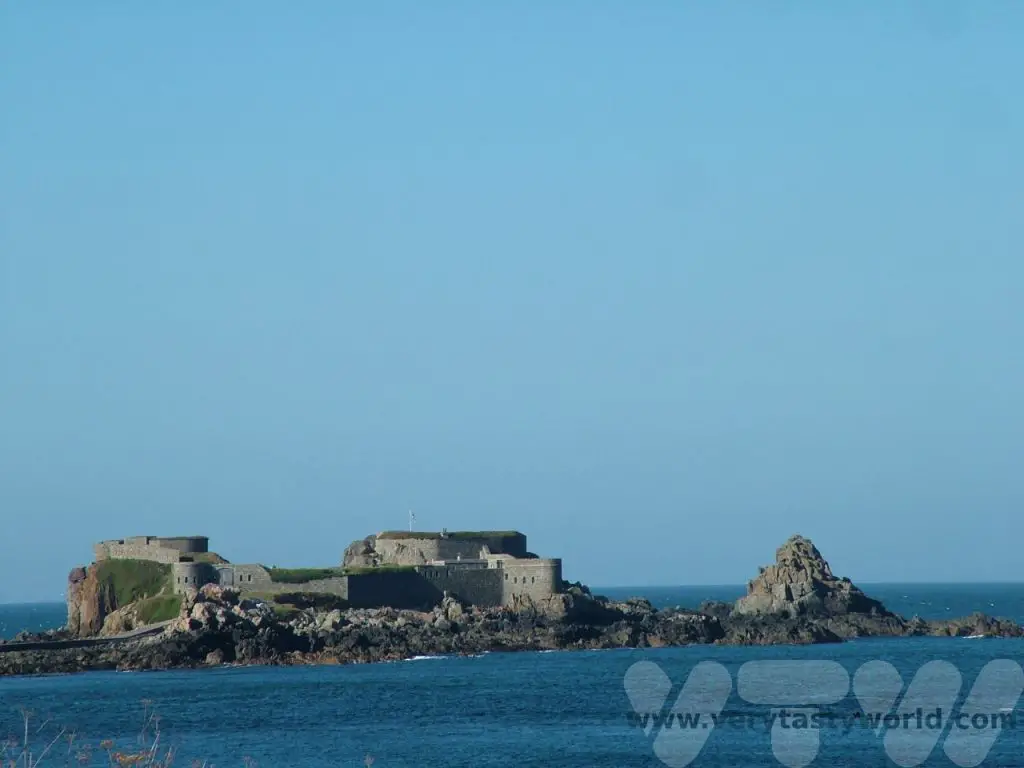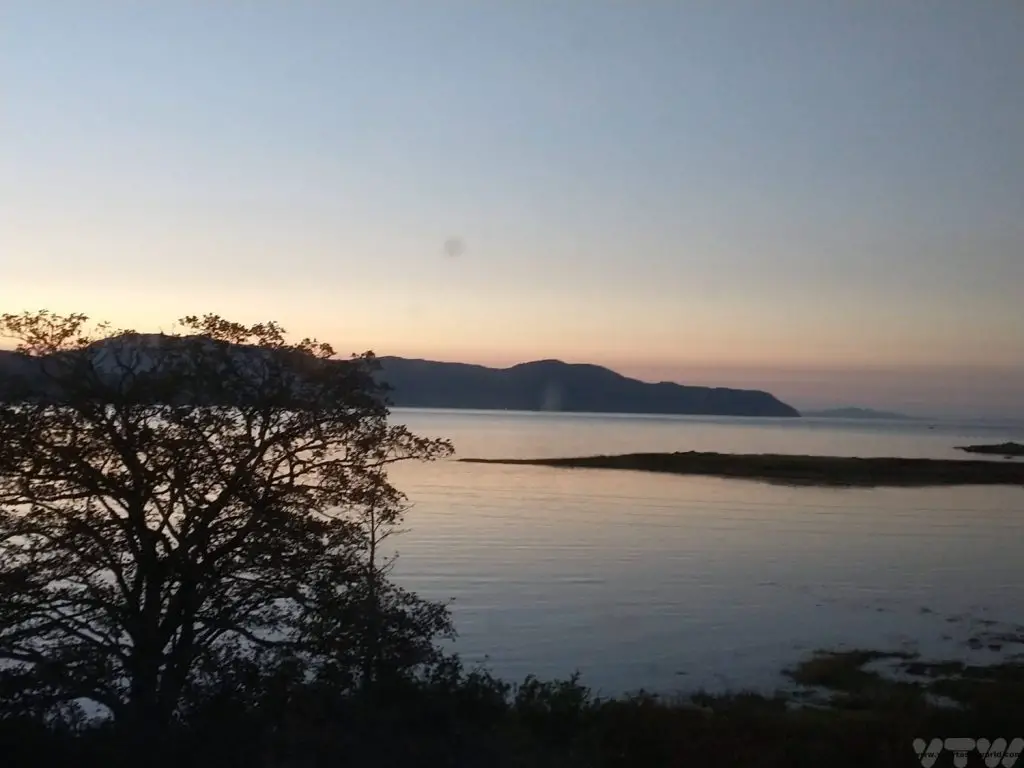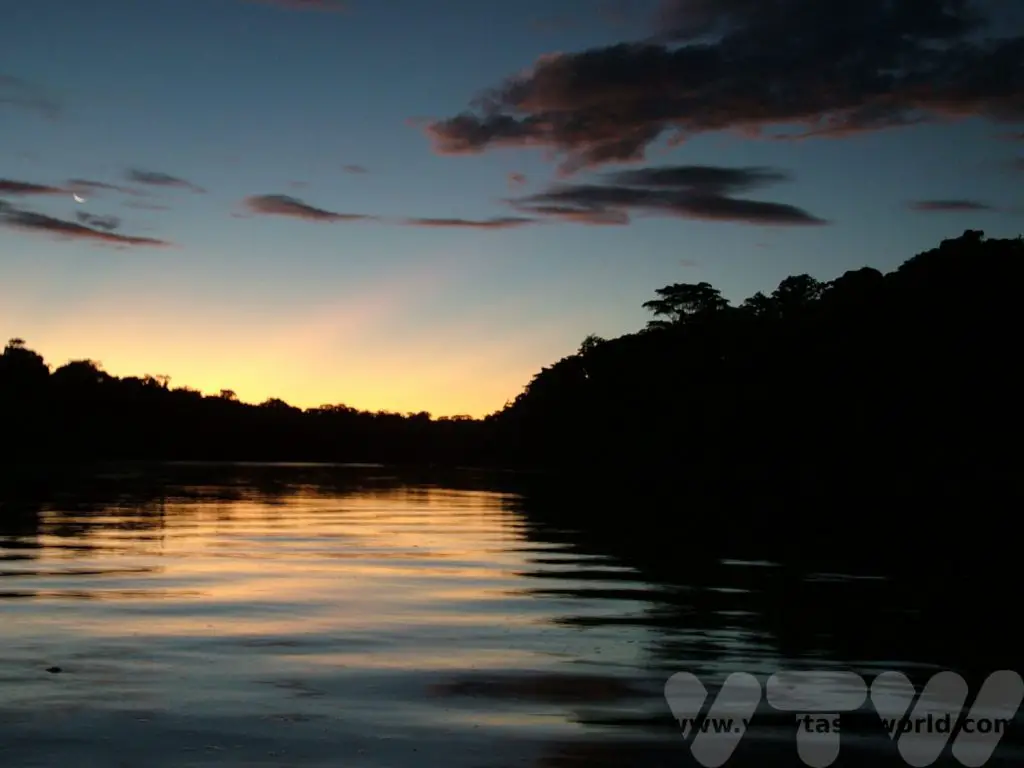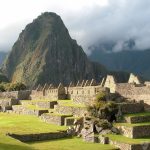Home » Countries
Category Archives: Countries
Is Kanazawa Worth Visiting?
Kanazawa, on the west coast of Japan, became much more accessible to visitors when shinkansen (bullet train) construction reached the city in 2015. The city is now easily accessible from Tokyo. So, is Kanazawa worth visiting? We absolutely think it is. It’s has plenty of things to see – a lively market (which has some amazing seafood restaurants), interesting museums, a castle, a koji park and one of the top three gardens in Japan.

Please note that this post contains affiliate links. If you click through and decide to make a purchase we will make a small commission, at no extra cost to you, which will help towards the costs of running this site.
Where Is Kanazawa?
Kanazawa is located on the west coast of Japan’s largest island Honshu.

How To Get To Kanazawa
Kanazawa is easily reachable on the shinkansen (bullet train). There are direct trains from Tokyo which take around 2.5-3 hours. You can also travel from Kyoto or Osaka, changing at Tsuruga.
Where to Stay in Kanazawa
Kanazawa has plenty of accommodation options for any budgets. We tend to stay in cheap business hotels so the APA Hotel Ekimae was located bang next to the railway station, which was perfect for us. The room was tiny but had all the facilities we needed, including a fridge, so we could go to the local konbini (convenience store), pick up a cheap breakfast box and store it for the morning.
Is Kanazawa Worth Visiting – Things To See
Omicho Market
Stroll down Kanazawa Ekidori Avenue from the main railway station for around 15 minutes and you’ll reach Omicho market. This extensive food market has been operating since 1721 and sells all sorts of exciting foodie ingredients. Fresh fish, meat and vegetables are the star attractions here and there are also opportunities to taste some local specialities.


It’s fascinating wandering through the stalls to see the various products on display. There are lots of snacks and goodies to taste on the go. We enjoyed loach cooked in sweet soy sauce on a stick as a snack.
Beware, some of the stall holders are understandably not fond of a constant parade of tourists taking photos of their wares and there are ‘no photography’ signs on some of the stalls. We suggest that you enjoy the experience of observing delicious ingredients rather than try to snap that perfect market food shot.
Kanazawa Castle
You can walk to the castle from the centre of Kanazawa, beyond Omicho market, and through the castle gardens.

It’s only fair to point out that many of Japan’s castles are reconstructions, the original buildings having been destroyed (sometimes several times) by fire over the centuries and Kanazawa’s is particularly modern. Originally completed in 1583, the Maeda Clan ruled from this castle. The oldest part of the castle here is the gate, which dates from 1788. The rest of the building has been rebuilt over the years, some even in this century!
The castle is mainly free to visit (some of the turrets have a fee) and has some interesting exhibitions.
Walking further past the castle gates leads to the Kenrokuen gardens.
Kenrokuen Gardens
Japan has many ‘best 3’ attractions, the most well-known is the ‘top 3 views in Japan’. Japanese gardens are wonderful places to visit and Kenrokuen Garden is one of the country’s top three. We visited in winter, just after the New Year holiday and, although we probably didn’t see it at its most glorious, it was still a delightful garden to visit. The admission fee is 320 Yen (about $2).


It is huge and beautifully designed, with large lakes, rippling streams, hidden paths and stone lanterns. Kenrokuen means “The garden of six sublimities”, which are characteristics that define the perfect garden. The sublimities are: artifice (curiously), antiquity, spaciousness, seclusion, water courses and wide panoramas.

Visit Ohno Port
A little way out of town is a toy museum and miso factory, located at Ohno machi (Ohno port), which is a bit of a journey; you can catch a bus from the Kanazawa station area (ask for the location of the bus stop at the tourist information centre inside the station concourse – it’s a five minute walk away, actually just down the road from the Apa hotel) and the port will be the very last stop. When you arrive at the sea you are there. You’ll likely be the last people on the bus.
Alternatively, you can get a taxi. The journey from the station takes around 20 minutes but the cost is considerably higher than the bus. Then just walk over the bridge to the little island.
A Delightful Toy Museum
At the far end of the island is a charming museum of mechanical toys which has a brilliant hands-on exhibition where you can spend hours playing games and enjoy viewing antique toys. The staff were absolutely delightful and very much wanted to make sure we enjoyed the exhibits. They were also very helpful when it came to supplying a timetable for the bus journey back into the centre of Kanazawa.
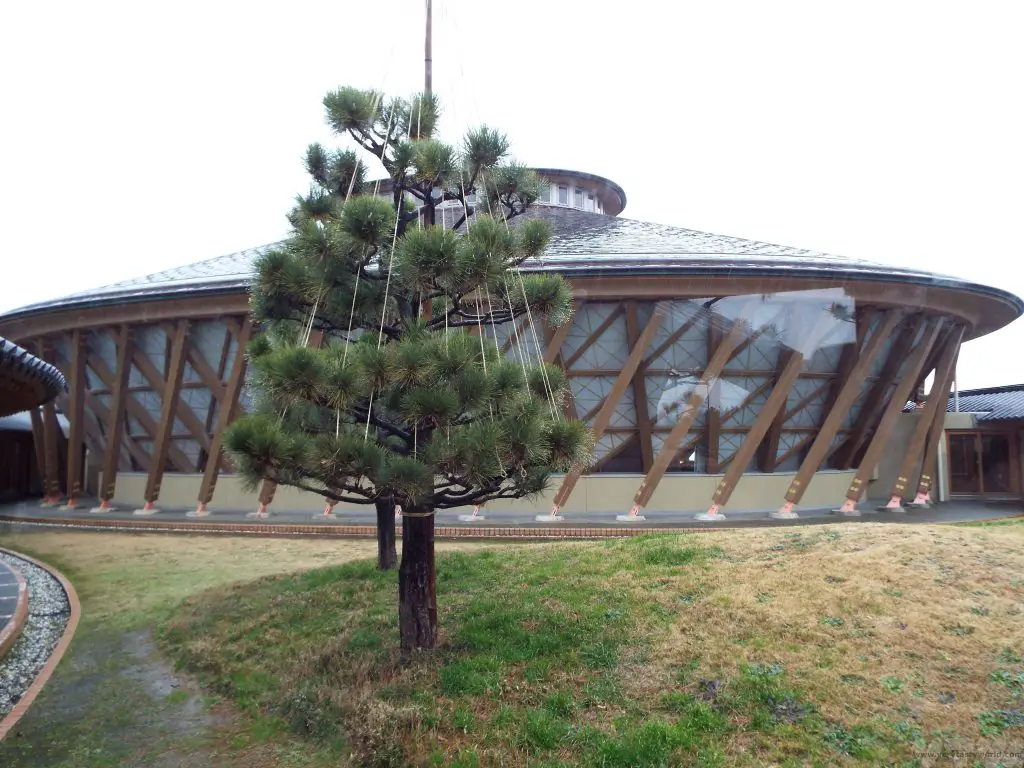
There are many historic mechanical puppets – karakuri – on display. The museum is a memorial to Benkichi Ohno,a master craftsman who lived in the area from 1831. Many of his creations can be seen at the museum.
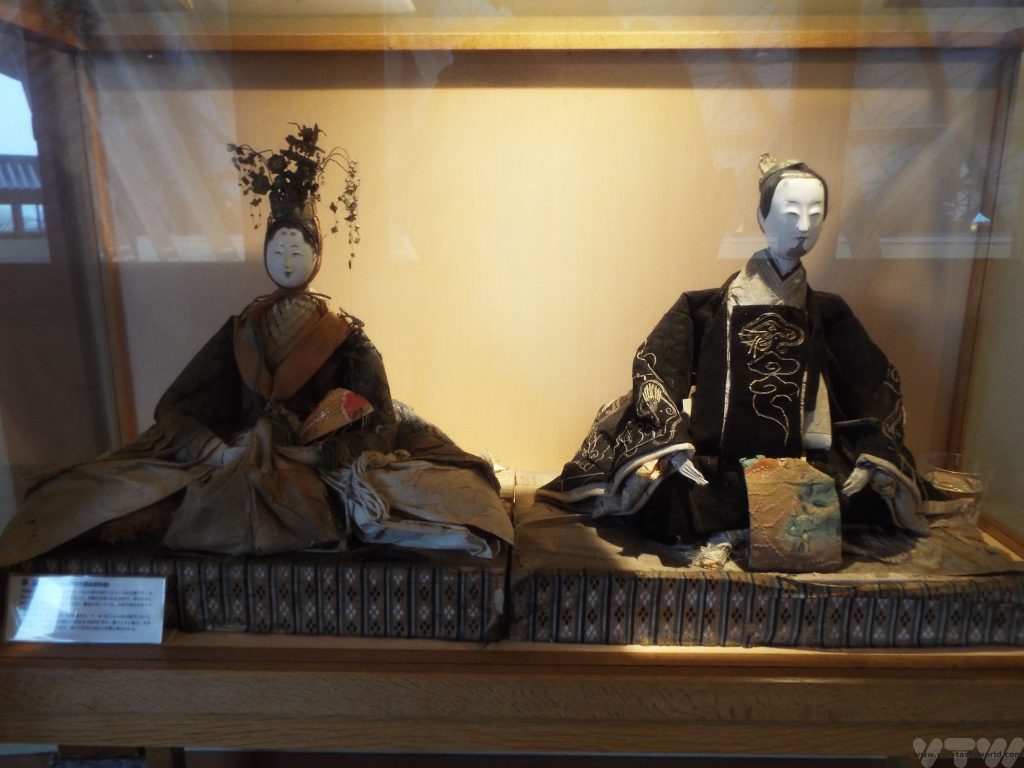

Some exhibits show you how the puppet mechanisms work.
Some dolls are cute(ish) which turn into scary. (Incidentally these words are, respectively, kawaii and kowaii in Japanese, be careful not to confuse the two!)
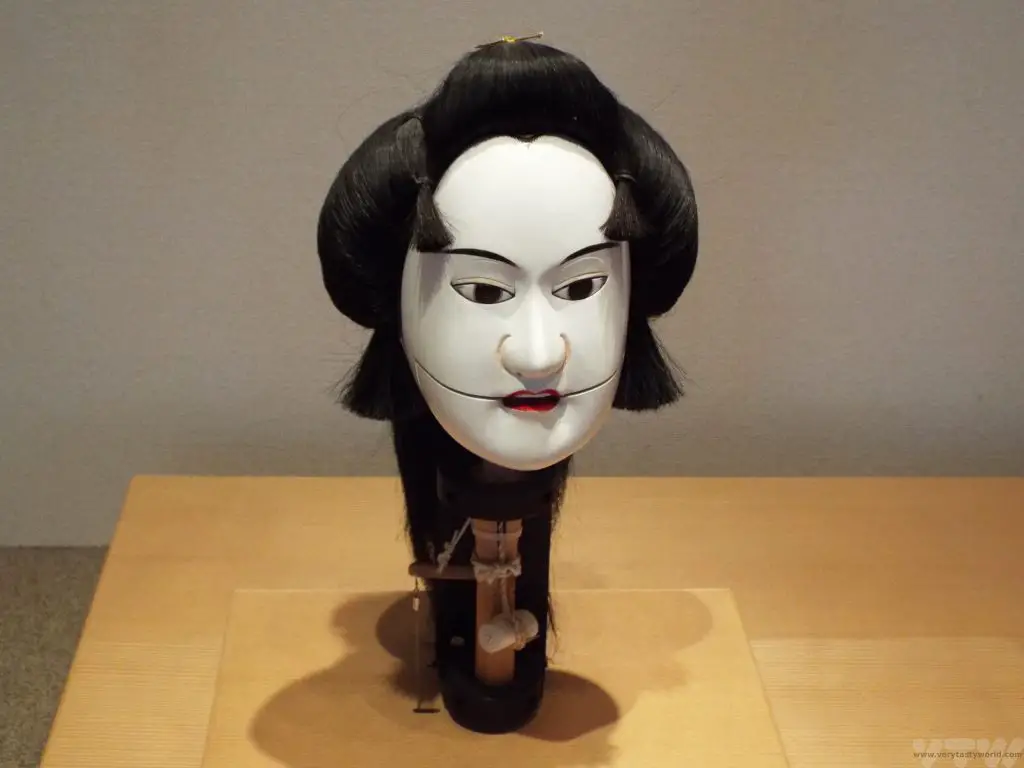
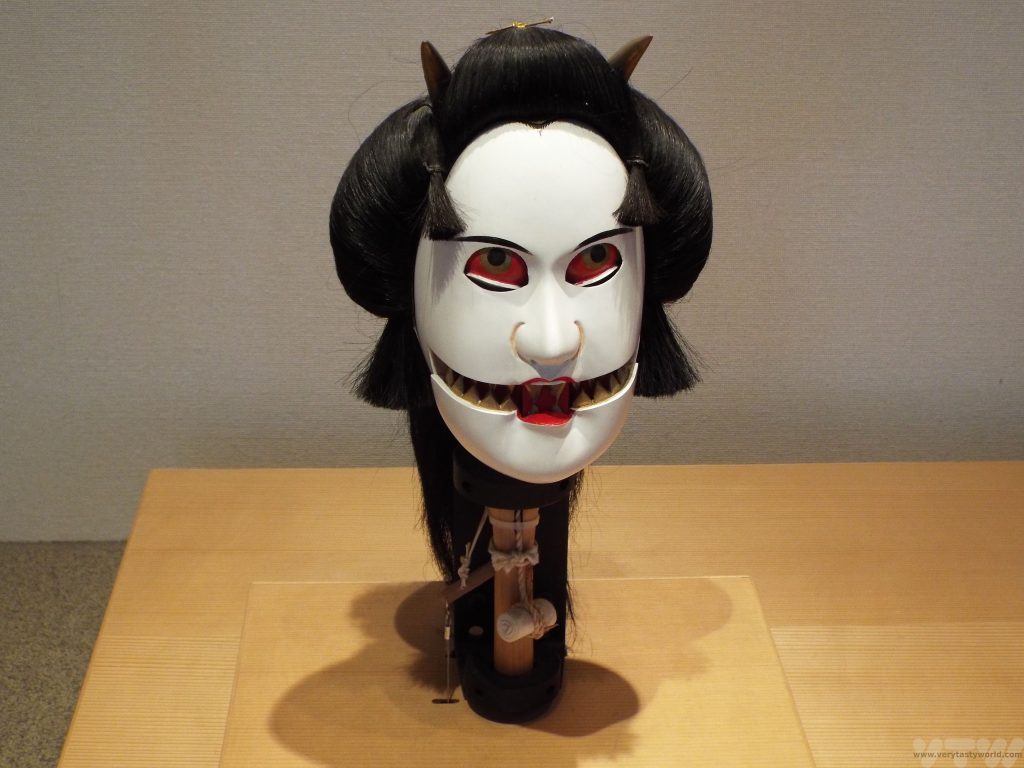
Around the circumference of the main building there are tables and chairs set out with all sorts of puzzles that you can try to solve.
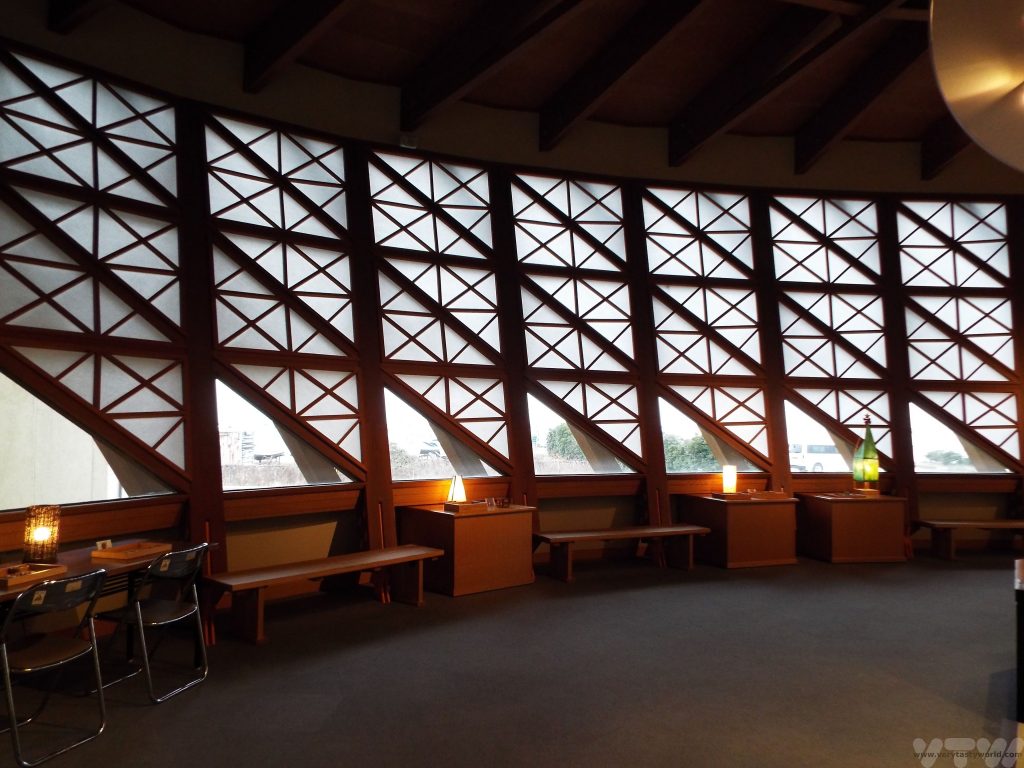
It’s a really hands-on museum and it was lovely to see families with children of all ages sitting together and working out solutions to some of the puzzles.
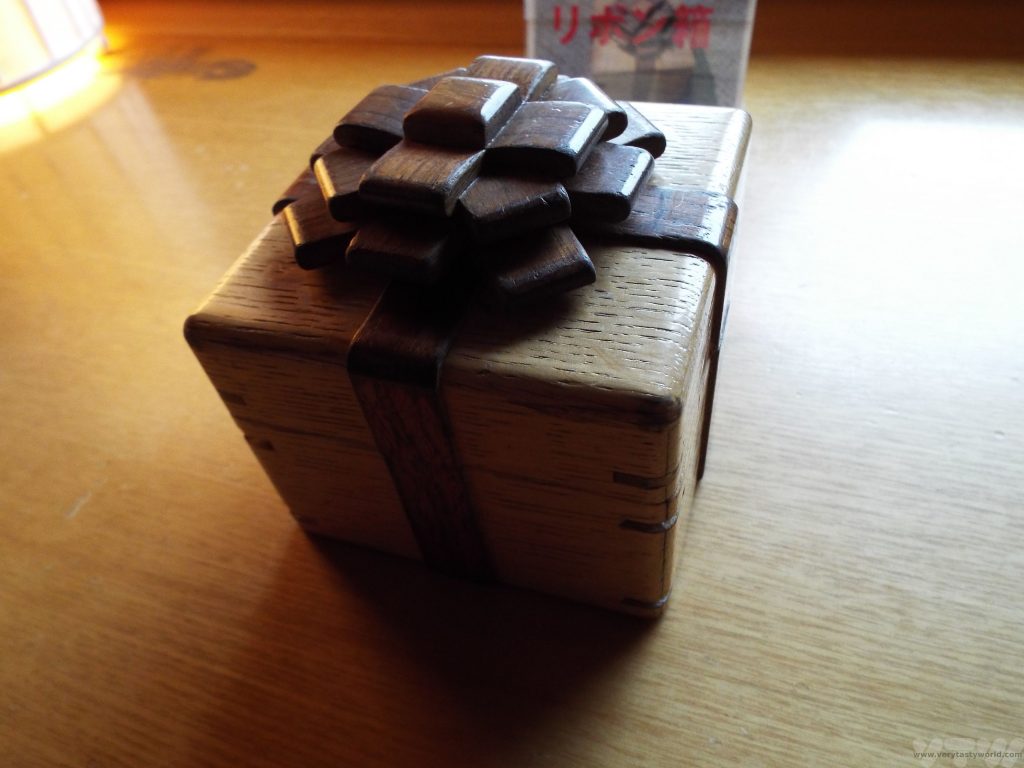
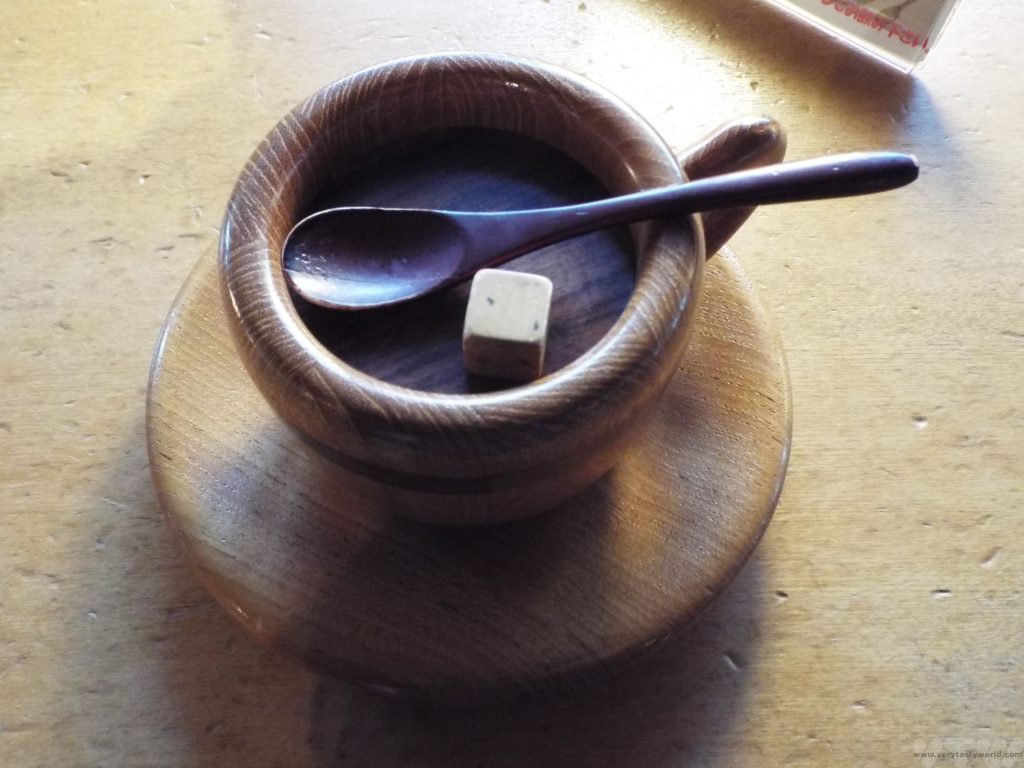
This doll is 300 years old, from the Edo period. The craftsmanship is exquisite.
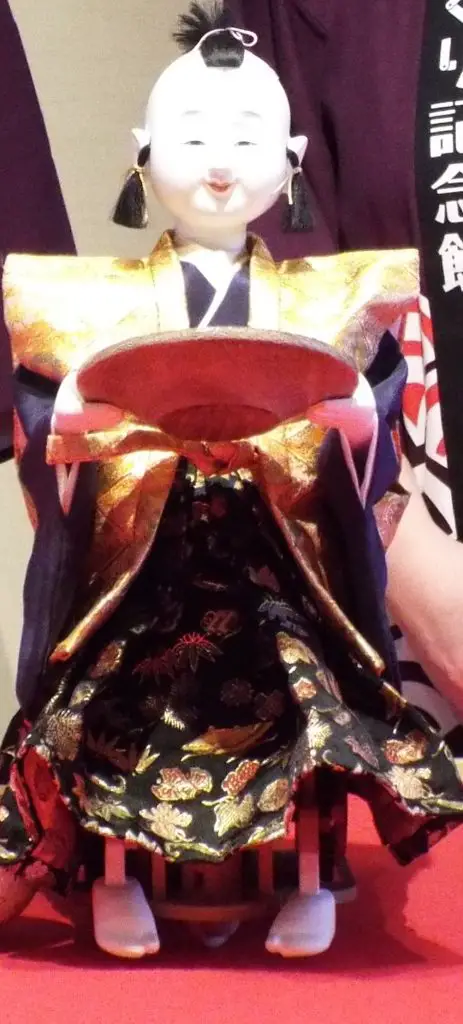
Just as we were leaving the park, the heavens opened and the rain started lashing down. We started to make a dash to our next destination, but a lovely staff member ran after us, brandishing an umbrella. We thanked her kindly but explained that we were British and were used to lots of rain. No, they insisted, and gave us a brolly so that we wouldn’t get wet. We’ve experienced this sort of kindness all over Japan, a welcoming generosity that just makes us love the country more and more.
A Delicious Koji Park
So, after a lovely diversion, it was on to the Yamato koji park, just a 10 minute walk (or 5 minute trot in the rain) away at the other end of the island. It’s part factory, part museum, part shop and part café. There weren’t any specific tours when we visited but the staff were super-helpful and directed us to a display where we could understand how miso is made.
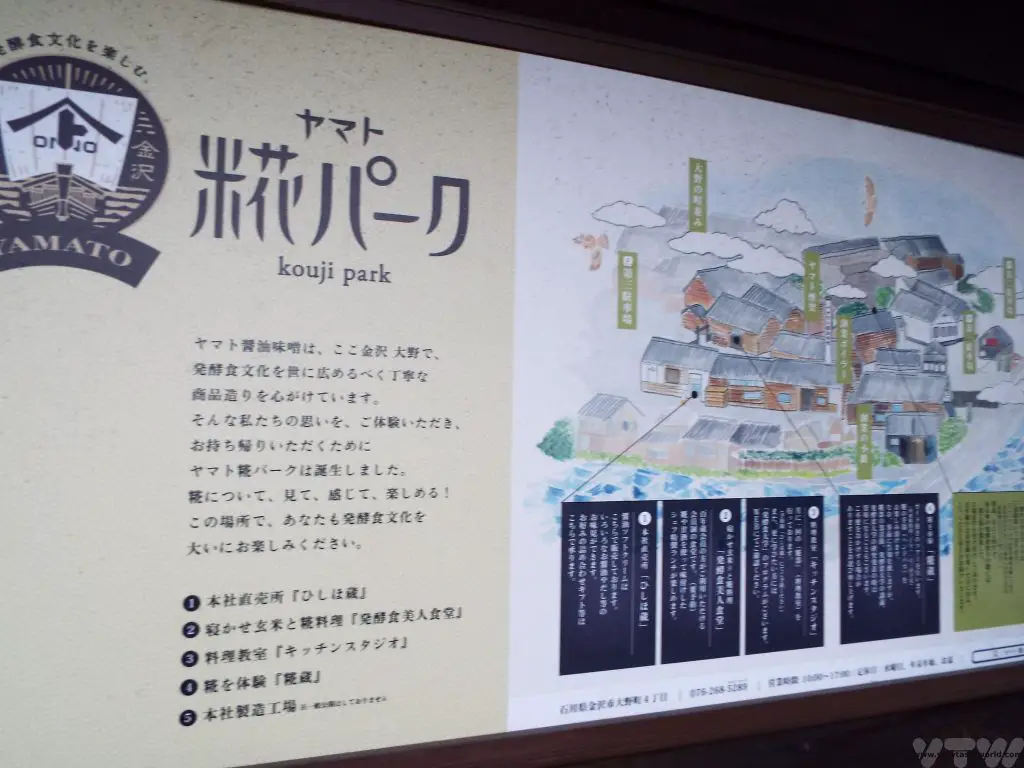


Miso basically contains five ingredients: water, koji, soy beans, rice, salt. Koji thrives on the rice. Then it is mashed with the soy beans, salt and water. After about six months yeast forms. The miso flavour develops thanks to the interactions between the yeast and the koji. Fermentation can take as long as three years.
Soy sauce is made using a very similar process and ingredients to miso but uses wheat instead of rice. A mash is formed and then it’s pressed (like olives for olive oil). After fermentation, the resulting liquid is soy sauce. It was fascinating to taste the difference between pasteurised and unpasteurised soy sauce. Unpasteurised soy has a more complex flavour because some of the heady aromas are lost in the pasteurization process.
Some the the traditional fermentation vessels are enormous. This was over two metres in height.
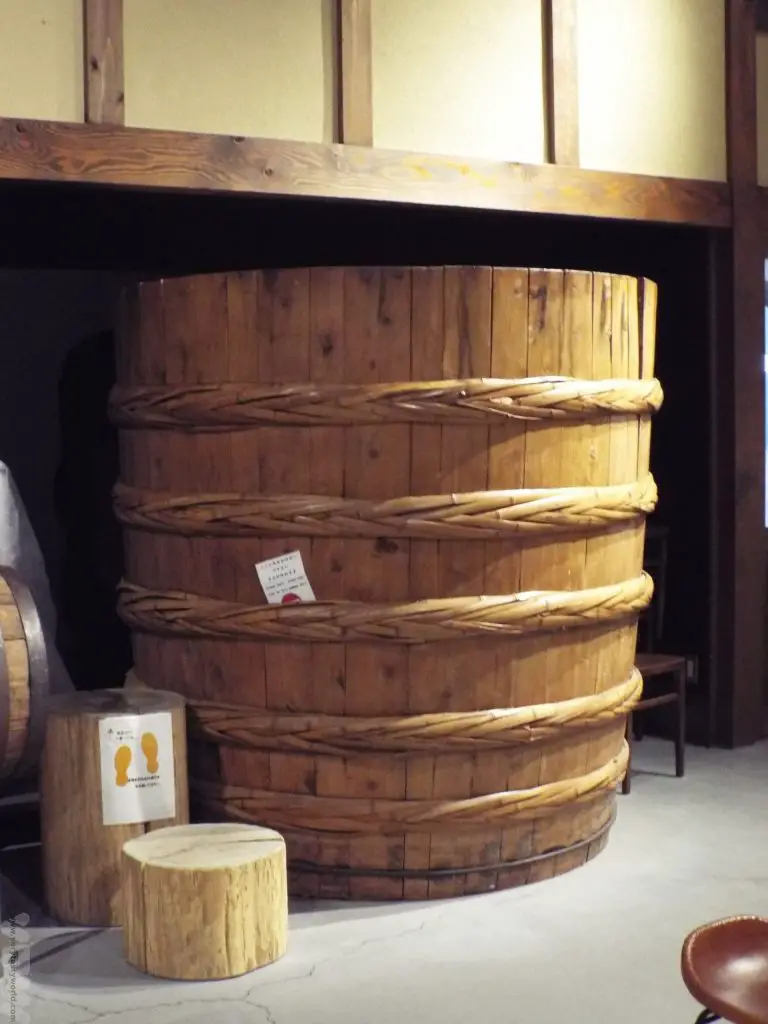
You can also dip your hands into a koji hand bath which will, apparently, give your skin a soft and delicate sheen. It’s quite nice to be able to dip your hands into a warm bath, especially on a cold, wet day. Apparently two minutes is the optimum time – there is a timer so you can check. And yes, we can confirm that our hands did emerge from the bath silky-smooth.
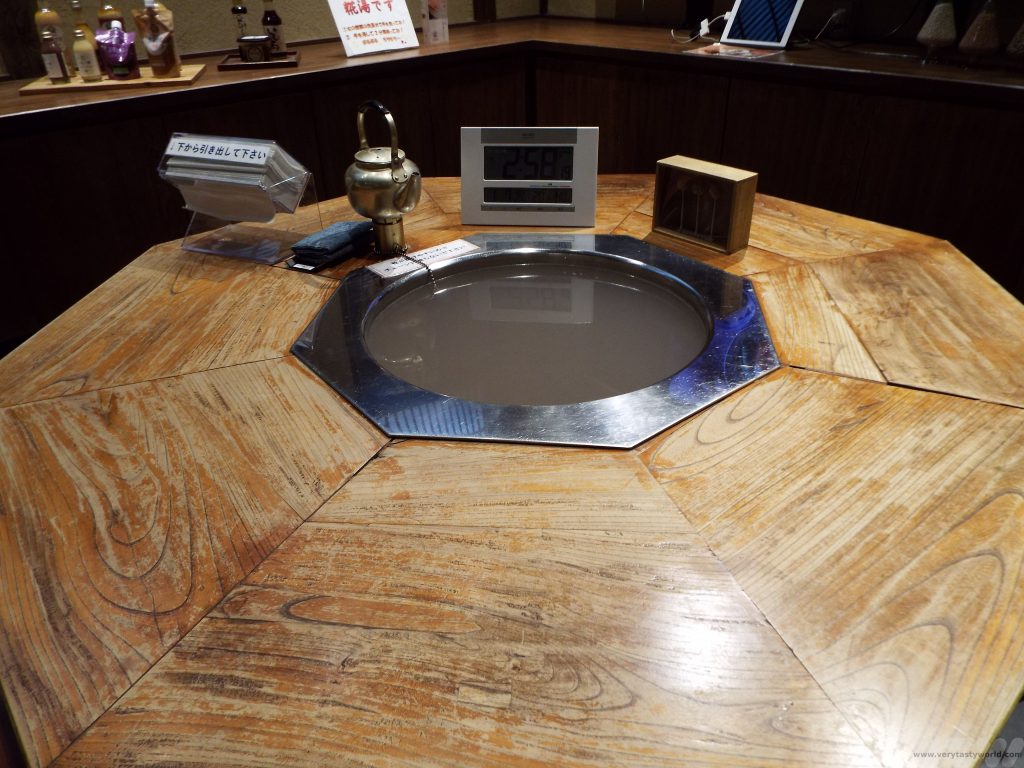
Foodie Souvenirs
There is a shop with an extensive variety of products and you are able to sample before you buy. It was particularly interesting to be able to taste different sauces and compare the flavours.

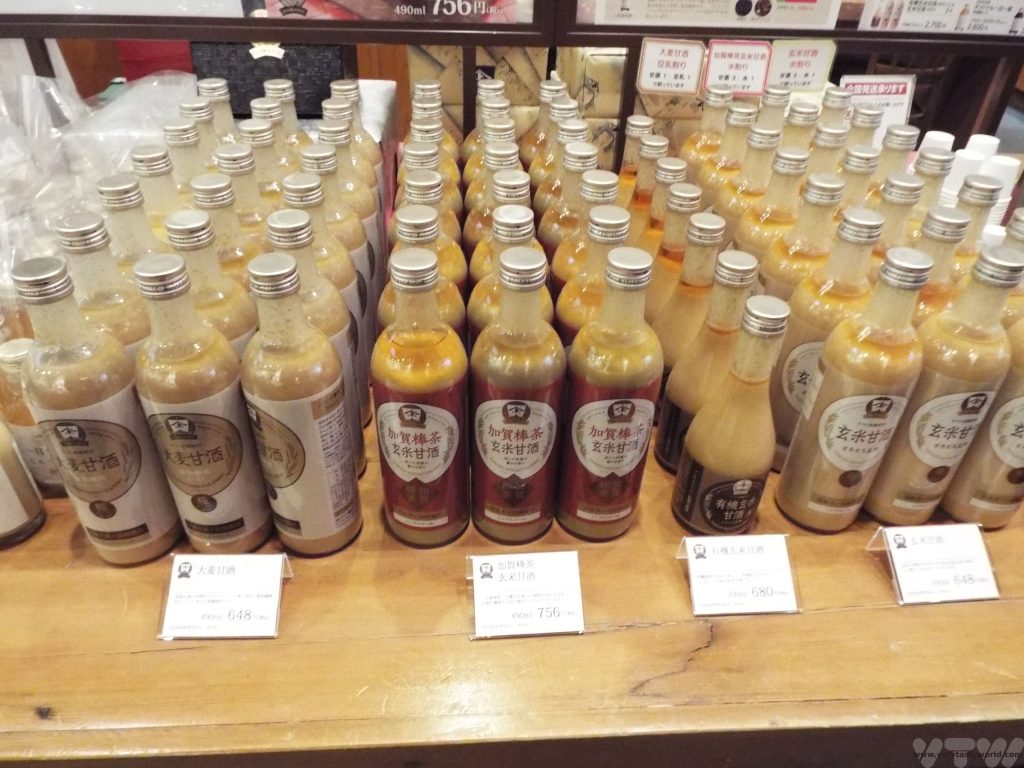
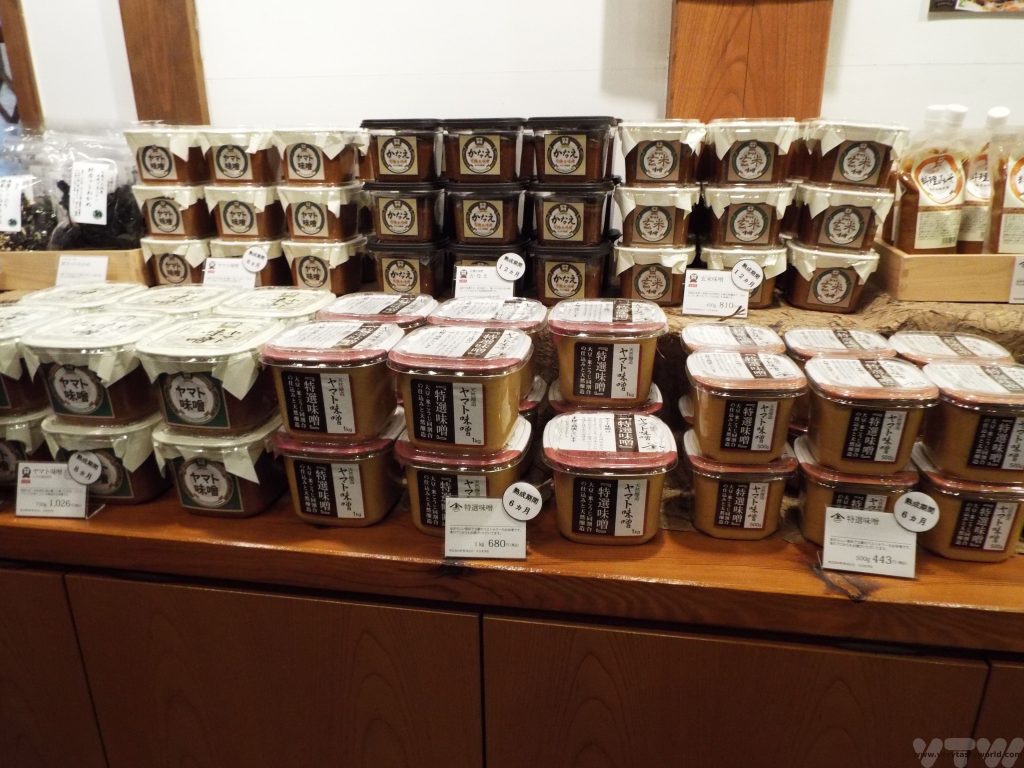
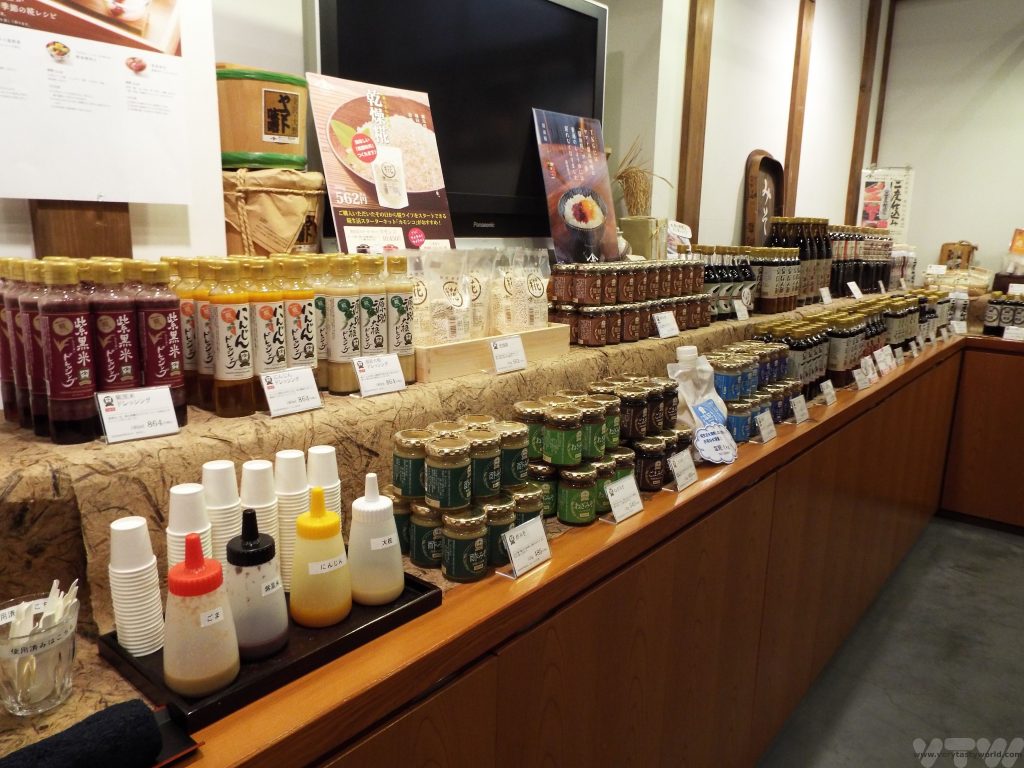
Amazake is a sweet, low alcohol drink made from fermented rice and koji. Amazake literally means ‘sweet’ (ama) ‘sake’ (sake, which can be used to describe alcohol). You can buy the paste, mix with hot water and drink. It tastes sweet and has a smooth, creamy texture. And for a delicious dressing, you can mix amazake with ponzu soy sauce (ponzu is a citrus juice comprising Japanese fruits sudachi, yuzu, and kabosu and vinegar mixed with soy sauce to give an amazingly tangy, salty flavour) in the ratio 1:1.
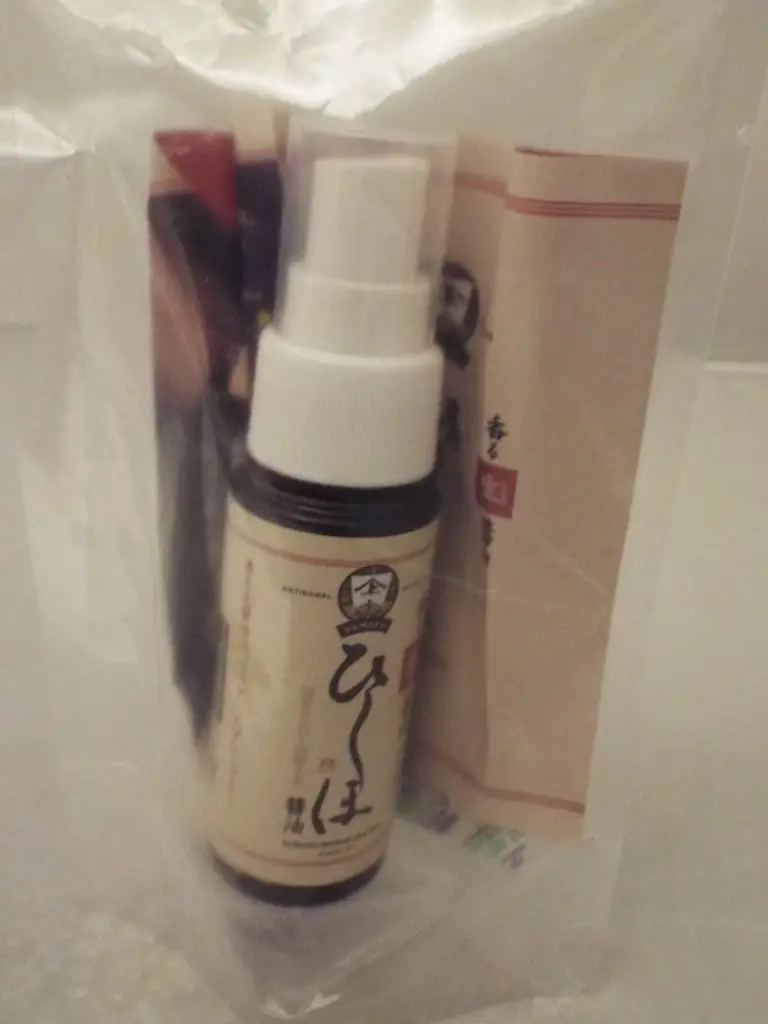
And one of the best foodie souvenirs ever – for the adventurer who cannot travel without seasoning – portable spray soy sauce, conveniently packaged in a container that would even fit into your hand-baggage.
They also have a café and ice-cream maker. Amazake and soy sauce ice-cream were on offer and we tried both. Soy sauce ice cream sounds so wrong but it was delicious, full of rich umami flavour that complemented the creamy sweet ice-cream.
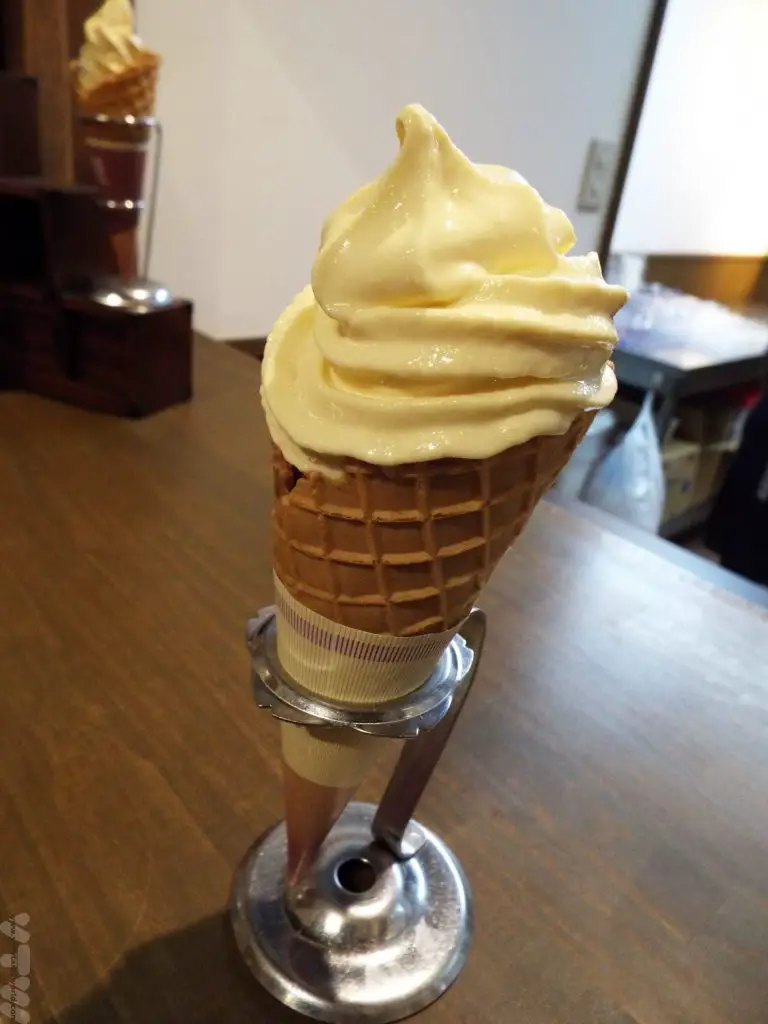
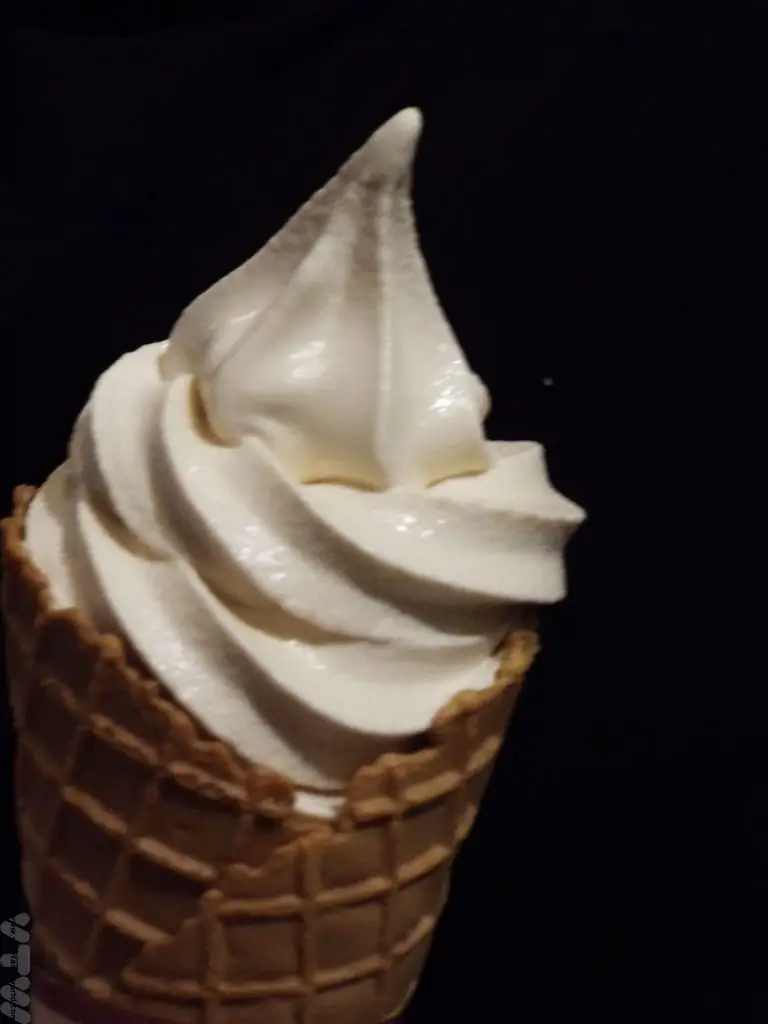
What was also rather lovely was that the CEO, Mr Yamato, was on site that day and came to say ‘hello.’ We can’t think of many companies where the boss would greet some very enthusiastic, albeit extremely damp, tourists.

We shopped for as many products as we could fit into our luggage. One particular packet that we were very happy to find was that of inoculated rice koji. It was also conveniently flat for packing and much cheaper than koji that we can purchase in Europe.
Making our very own miso was most definitely going to be one of our foodie missions on our return home. And this is how we made it…
Kanazawa For Foodies
Kanazawa is a fantastic location for foodies. Not only are the market and koji park great fun to visit, there are plenty of restaurants to suit all budgets, so eating out is a joy. Because Kanazawa is a port city the seafood is sublime – totally fresh and utterly delicious. We often find that you get the best quality – and often cheaper – seafood if you eat at a market.
We recommend visiting Omicho Market in the evening, after the stalls have closed. There are a number of restaurants which offer kaisendon sashimi bowls which are as beautiful as they are delicious. They comprise the freshest seafood, delicately arranged atop a bowl of rice. We ate at Yutaka which has a reputation as being one of the best in the area and it didn’t disappoint. It was extremely good value as well. This delightful bowl consisted of crab, prawn, squid, sea urchin, salmon roe, tamago, maguro, mackerel. To season, mix wasabi into a teeny bit of soy sauce, then pour it over the fish. It was accompanied by miso soup with fish and prawn heads.


Ice cream with gold leaf is another foodie treat. Why have an ordinary soft whip ice cream when you can cover it in gold leaf? We visited in winter, so didn’t indulge but we did bring home a great foodie souvenir of some gold leaf to adorn our ice creams at home.
When catching the shinkansen for onward travel don’t forget to pick up an ekiben – a bento lunchbox. Many ekiben are specific to the station you are travelling from. Kanazawa has a specialty seafood box. A thing of beauty and deliciousness!


Other Attractions in Kanazawa
The 21st Century Museum of Contemporary Art exhibits modern art in an incredibly cool building.
Ninjadera is a Ninja Temple complete with hidden rooms, secret tunnels, traps and labyrinthine corridors. Naruto fans will love this!
Kanazawa Yasue Gold Leaf Museum. Kanazawa has been producing gold leaf since 1593. This material is often used to adorn temples. It is real gold, beaten so thin that you can tear it apart just by touching it. This is a skilled craft. The museum offers a history of gold leaf craftsmanship in the area. If you are interested there are shops in Kanazawa that will offer the chance for visitors to have a go at applying gold leaf to various objects.
Out of Town
Kanazawa is located close to the Japanese Alps and, if you have a Japan Rail Pass, you can easily get around the region, although to get right into the countryside you will need to use buses or hire a car. We left our luggage at our business hotel, packed an overnight bag, and enjoyed a night away from the city in a traditional gassho farmhouse in the delightful country village of Ainokura. You can read about our gassho farmhouse stay in rural Japan.
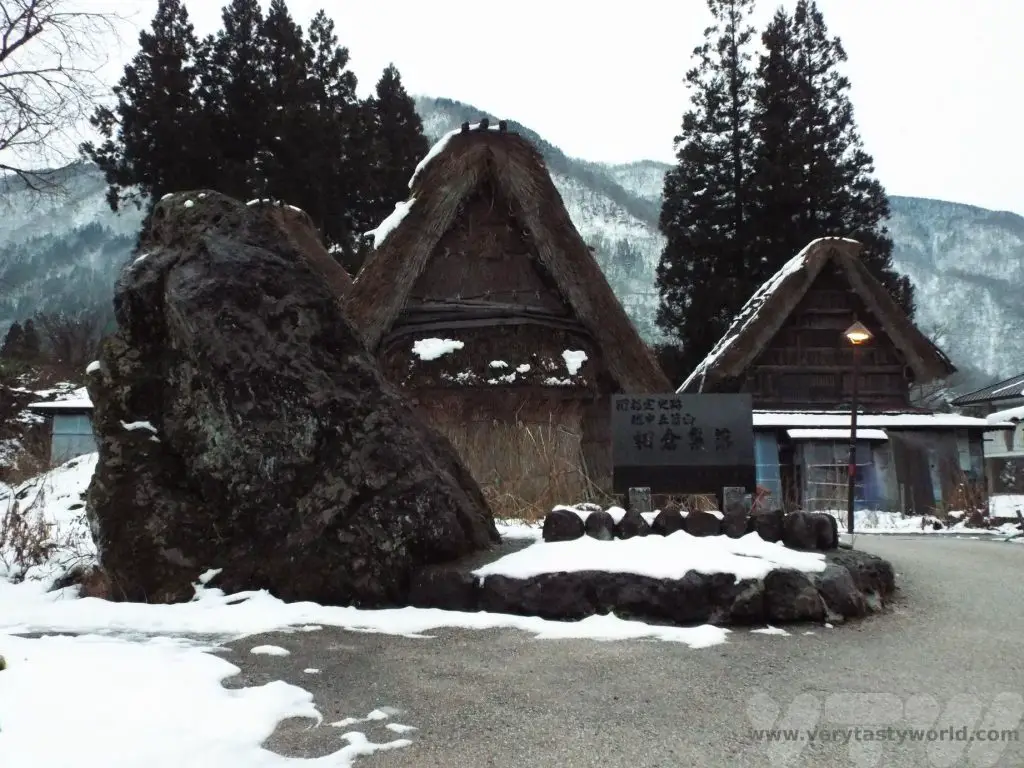
Alternatively, day trips to these lovely villages are also available.
Related Posts You May Enjoy

- Is Kanazawa Worth Visiting?

- RECIPE: How to Make Sushi Ginger – Gari

- Kobe Beef in Kobe – Is It Worth It?

- Recipe: Simmered Shiitake Mushrooms
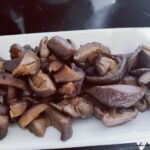
- How to Use Public Transport in Japan
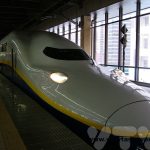
- RECIPE Oyakodon Donburi

- Planning a Trip to Japan
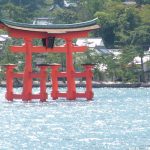
- The Makanai: Cooking for the Maiko House
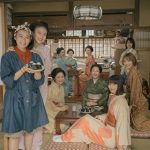
- Setsubun Food – Bean Throwing Day
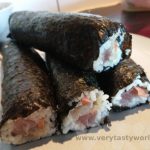
Best of Beijing – A 3-day Beijing Itinerary
China’s capital city is a huge, sprawling metropolis but it still embraces and celebrates the country’s long and fascinating history. Our 3-day Beijing itinerary will ensure you see the essential sights of this remarkable city, so many of which are UNESCO listed. We also have some suggestions for things to do in the evenings.
Please note that this post contains affiliate links. If you click through and decide to make a purchase we will make a small commission, at no extra cost to you, which will help towards the costs of running this site.
When To Visit Beijing
Beijing can be visited all year round, although some times will be busier than others. Lunar New Year, also known as Spring Festival, will be very busy for travelling around China. Also, the first week in October is National Week holiday, so transportation is likely to be busy then as well. We travelled in the winter – just after the main New Year celebration but towards the end of the Spring Festival fortnight. New Year is a lunar event and its timing will vary from year to year. The first day falls on the second new moon after the winter solstice, usually between 21st January and 20th February.
Travelling in winter was fantastic because the attractions were less crowded. Also, at the time of our visit, the air pollution wasn’t too bad (and Beijing is notorious for its poor air quality). But it was very cold so we recommend wrapping up warmly.
3-Day Beijing Itinerary – Day 1
Summer Palace and Hutong Alleys
Take the metro or a bus to the Summer Palace, a gorgeous landscaped garden and park that is a UNESCO heritage site. It was constructed as an imperial garden during the Qing Dynasty and completed in 1764.
The garden is formed around Kunming Lake and Longevity Hill. Although the vast lake looks natural it is completely artificial.
Highlights include the Tower of Buddhist Incense at Longevity Hill, a beautiful octagonal structure used as a place of prayer for the emperors and empresses.

The Seventeen Arch Bridge links to Nanhu Island. It’s the largest bridge in the palace grounds and is highly decorated, notably with beautiful carved lions.

The Long Corridor is 728m long and dates from the 18th century. It is a beautifully decorated covered walkway with artwork inspired by literature, folk stories, legendary heroes, historic figures, enhanced by intricate images of flora and fauna.

The Summer Palace is located around 15km from the city centre. You can take Line 4 to Beigongmen Station or a bus to Xin Jian Gong Men (Yiheyuan New Palace Gate).
Return to Beijing and spend the afternoon exploring the hutongs. These give a real insight into old Beijing. Dating back to the 13th century, they comprise a maze of winding alleyways behind which are single-storey houses set within courtyards. It’s possible to take a rickshaw ride through these areas. Some houses are open to the public so that you can peep inside and get to understand local life. Although modern architecture dominates the city a fair few hutongs remain and you can choose which you wish to visit.

3-Day Beijing Itinerary Day 2 – Great Wall of China
No trip to Beijing would be complete without visiting the Great Wall of China. One of the seven wonders of the modern world, this UNESCO heritage site is a triumph of engineering. The wall runs almost 20,000km from Gansu to southern Manchuria and was built over many centuries by successive Chinese emperors. It’s a myth that the construction can be seen from space, but who cares? It’s still unbelievably impressive.

The most popular sections of the wall that are easily accessible from Beijing are at Mutianyu and Badaling. We visited Mutianyu, which is about 45km away from the city. It takes an hour or two to reach it depending on the traffic (which can be congested in Beijing). You can catch a bus, get a taxi or go on an organised day trip. These days, the numbers of visitors are restricted to 30,000 each day, so pre-booking is essential.

At Mutianyu you ascend to the wall by cable car and can then walk along it. The views are nothing short of spectacular as you view it snaking across the undulating mountains as far as the eye can see.

When you’ve finished admiring the sheer magnificence of this amazing structure, you descend again by cable car. Or, if you’re feeling adventurous, you can take a slide to the bottom.
3-Day Beijing Itinerary Day 3
Tiananmen Square and The Forbidden City
Slap bang in the heart of Beijing is Tianenamen Square, Square of the Gate of Heavenly Peace. It is one of the largest public squares in the world. Tiananmen Square is big. Really big. Big enough to fit 1,000,000 people.

To those outside China the square is best known for the student democracy protests that ended with a catastrophic military intervention and massacre in 1989. Although the world was watching, many people within China are still unaware of what happened. There are often several plainclothes security officers in the square.
You can reach the square on Subway Line 1 – Tiananmen East or Tiananmen West. Entrance is free but there are fixed entrance locations. Security checks will take place, bags will be searched and we advise keeping your documentation with you. It is really important not to talk about the events of 1989 while visiting the square. We also recommend not wearing clothes that have political messages.
There are various monuments around the square, including the Monument to People’s Heroes and the Monument to Revolutionary Struggle at Mao Zedong’s mausoleum.


The China National Museum, which exhibits precious cultural artefacts, lies to the east of Tiananmen Square and the Great Hall of the People is on the western side.
To the north of the square is the Forbidden City.

This enormous complex is the former imperial palace of Chinese Emperors, from the Yongle Emperor of the Ming dynasty until the end of the Qing Dynasty. Constructed between 1406 and 1420, it boasts 9,999 rooms (although they have since been counted and the total came to 8,886, which is still pretty impressive). It has a rectangular form, nearly 970m long on a north-south orientation and 750m wide.

Even though the site is huge, visitor numbers are now restricted to 40,000 per day so we recommend prebooking tickets for your visit.

The details in the architecture are remarkable. Many of the rooftops have a series of animals striding across them. Each animal represents something different – lions stand for power, dragons protect against fire and the phoenix should bring good fortune. The quantity of animals indicates the status of the building – the most important will have nine.

Many of the the gate entrances are protected by guardian lions – the male lion places his left paw on an orb and the female places hers on her cub.

And the imperial garden has lovely pavilions.

The Temple of Heaven
In the afternoon we recommend a visit to the delightful Temple of Heaven complex. The purpose of the beautiful buildings, set within a lovely garden, was for the Emperor to pray for good harvests. From the Forbidden City/Tiananmen Square, Line 1 then Line 5 to Tiantan Dongmen Station, Exit A, will get you to the East gate.
The Circular Mound Altar comprises three beautiful terraces, built for the Emperor to pray for good weather.

The Imperial Vault of Heaven was the repository for the tablets of the gods, used when making prayers.

The Hall of Prayer for Good Harvests which, as the name suggests, was a place of prayer as the emperor would ask the gods for bountiful yields of food.

There are tea houses close by and this is a great opportunity to learn about Chinese teas and to have a taste. We have a post with more detail about the Temple of Heaven and tasting heavenly tea. Although beware, there are sometimes scams surrounding tea houses where a friendly local person may approach you and invite you to drink tea with them and they can practice their English. But then they disappear and you end up with a very expensive bill. Most establishments are absolutely respectable, but always check the menu and pricing!
Suggestions for Evening Entertainment
Visit A Food Street Or Night Market.
Wangfujing Food Market is one of the largest and most famous in Beijing. Located close to the Forbidden City, there are all sorts of delicacies on offer, including some that could be a challenge! Bugs and scorpions, anyone? Or maybe some wiggly seafood?


Guijie Night Market, in Dongzhimen, is open 24 hours and offers a huge range of traditional Chinese delicacies.
See An Acrobatics Show
Chinese acrobats are jaw-droppingly skilled. For a spectacular evening of thrills, we recommend an acrobatic show. From balancing acts to juggling to contortion to multiple crazy motorcycles zooming inside spherical cages (which had us on the edge of our seats) you are sure to be entertained.
Watch A Beijing Opera Performance
It has to be said that Beijing Opera can be a little challenging to the inexperienced ear. However, there is no doubt as to the skill of the performers, who can sing, dance, stage fight with weapons and perform amazing acrobatics. The costumes and make-up are flamboyant and the performance is highly stylised. This really does represent the best of traditional Chinese entertainment.
Beijing for Foodies
Beijing’s most famous dish is, of course, Beijing Duck (formerly known as Peking Duck). Most Chinese restaurants in the UK when we were growing up were actually Cantonese (Hong Kong) and hence the aromatic crispy duck we ate when growing up is very different to authentic Beijing Duck. Beijing duck’s skin is crispy-thin, almost glassy, and a bronzed orange in colour. It has been a popular dish for many centuries and was one of the dishes that had a predominant place on imperial menus.
A great deal of preparation goes into this dish. After the duck has been plucked and entrails removed, air is pumped under the skin to separate the skin from the fat. The skin becomes tightened when the duck is blanched in boiling water. A marinade comprising honey, soy sauce and five spice is applied and the duck left to hang for at least 24 hours. Then it is roasted in an oven. It is usually served in pancakes with juliennes of cucumber and spring onion. We most definitely recommend trying Beijing duck in Beijing.
Beijing has so much to offer the visitor, from the history spanning millennia to the high-tech modern cityscapes. This three day Beijing itinerary will ensure you see the very best that the city has to offer.
Related Posts You May Enjoy

Andasibe Mantadia National Park Madagascar
Andasibe Mantadia National Park Madagascar is one of the country’s most popular parks to visit because it has a remarkable diversity of wildlife to discover. Lemurs are undoubtedly Madagascar’s main wildlife attraction and the Mantadia National Park is home to both the largest and the smallest species. But there are also many birds, amphibians, reptiles and flora in the rainforest and these are fascinating as well. It is also one of the parks that is closest to Madagascar’s capital Antananarivo (known as Tana). Here is our guide to visiting this wonderful national park.

Please note that this post contains affiliate links. If you click through and decide to make a purchase we will make a small commission, at no extra cost to you, which will help towards the costs of running this site.
Getting to Andasibe Mantadia National Park Madagascar
We travelled to Madagascar with a local operator who arranged all our transportation and accommodation for us. The best route to reach Andasibe is to drive along the RN2 (Route Nationale) from Tana. As with all driving in Madagascar, the roads are slow-moving and riddled with potholes. The RN2 is also the main road between Tana and the sea ports on the eastern coast so there is often a parade of lorries rumbling their way along, hauling goods for export and creating a cloud of dust in their wake. You just have to sit tight and get into the ‘mora mora’ mindset – slowly, slowly.
Buses will also be available from Tana if you are travelling independently. These are basically minibuses which can be quite cramped and will also be slow, especially as they will stop multiple times along the way. There is also a train from Tana to Andasibe.
It took us around 5 hours to travel Andasibe – a 150km journey on a road that was particularly slow that day as we were stuck behind lots of lorries that were difficult to overtake. It was dark when we arrived.
Where We Stayed in Andasibe
Andasibe is the best location for exploring the Mantadia Park. There are a few accommodation options. We stayed at the Mantadia Lodge at Andasibe which was a fair way out of town up a steep hillside. It was very posh, much more luxurious than we normally choose. (But that was kinda nice after the long journey!)


Our room was spacious and had a great view of the rainforest from the wide windows. There was also an infinity swimming pool which was lovely to relax in whilst overlooking the landscape. One of the best benefits was the free minibar which offered a variety of drinks, including beers, and these were topped up every day.
Exploring the Madagascar Andasibe Mantadia National Park
We spent two days exploring this lush rainforested area in search of wildlife. The area of the Mantadia National Park is roughly 155 square kilometres and is home to much of Madagascar’s unique wildlife. Lemurs are the best known and most popular of the creatures that inhabit this remarkable rainforest but there are many birds, reptiles and amphibians to view as well.
The reason that lemurs are so important is that Madagascar is the only place in the world where you can see them in the wild. When the island separated from mainland Africa millions of years ago, evolution took many species in very different directions. On the African continent, primates evolved into apes and, eventually, humans; in Madagascar they evolved into lemurs. We don’t often use the word ‘unique’ but it absolutely applies to Madagascar’s wildlife.
The Analamazaotra Special Reserve
Leaving early in the morning, we visited the Analamazaotra special reserve, which is located close to Andasibe. It was an easy hike through the forest where four diurnal lemur species reside. We managed to see three of them. This is one of the best places to see the remarkable Indri Indri lemur, the largest of all the lemurs, and endemic to the area. The lemurs have a hauntingly beautiful cry as they communicate with each other in the forest. When we first heard them, we thought we were hearing whales singing!
The Indri Indri live together as families in separate territories and can live for up to 80 years. They breed once every three years, and their only puppy remains with its mum for nine years before it leaves to starting a new family elsewhere in the jungle. Lemurs need to come down from trees to eat clay once in a while to help digestion. They get their water from leaves. They can jump up to 10 metres across the treetops.

Observing these remarkable lemurs was a true privilege. The reason that it is so important to protect the Indri Indri is that they cannot be kept in captivity. People have tried. But these highly intelligent creatures value their freedom too much and simply refuse to eat.
We also saw the Diademed Sifaka lemurs who share the forest with the Indri Indri but eat different foods, so they don’t compete.

And the Eastern Lesser Bamboo lemurs were delightfully energetic and lively little lemurs, flitting through the bamboo.

We saw the Pandanus frog which lives in the sharp, spiked pandanus plant. The frog can get water from inside the plant. Unusually for a tree frog, this species has a tadpole phase. Many tree frogs don’t, they never walk on the ground – the eggs usually hatch straight to little frogs.


Madagascar may not have giraffes, but it does have bizarre insects like the famous giraffe-necked weevil (Trachelophorus giraffae). They live on the trees and feed from the leaves. The female is quite adept at rolling up leaves in order to lay her eggs inside.
Visiting Andasibe Village
We spent the afternoon exploring the village of Andasibe,walking the narrow cobbled streets. It has a population of around 5000 people.

We joined the local spectators watching a football match.

And then walked through the village to the old colonial train station with its curiously angular architecture.


Trains do run from Tana to the coast via Andasibe, but are slow and do not necessarily stick to their timetables. But a rail journey could be worth considering if you have the time for a leisurely trip.
Nightwalk at the VOIMMA Reserve
The VOIMMA reserve is a great initiative because it was founded by the Andsibe villagers who wanted to have their own stake in eco-tourism. This park, run by the community, provides a local alternative to the national parks which are managed by the government. At nightfall we donned head torches and made our way through the forest to try to spot the nocturnal creatures of the area.
Having seen the largest lemur we also got very lucky and saw the smallest lemur, the Brown Lemur, which isn’t much bigger than a mouse. He was a bit shy though, not keen to pose for a good photo.

And the curvy chameleons were out in force.

The Andasibe Mantadia National Park Madagascar
The following day was an early start again. The primary forest of Madagascar’s Andasibe Mantadia Park is around an hour’s journey from the village. We spent three hours hiking in this park. It requires a reasonable level of fitness as there are some steep slopes and dense vegetation.


There are over one hundred species of bird in the park, including kingfishers, hawks, moorhens, flycatchers and fan-tailed birds. There are also 14 species of lemur, multiple reptiles including the snake boa manditra and multiple species of amphibian.
We didn’t have a huge amount of luck here but did see more lively Diademed Sifaka lemurs playing in the treetops.


Vakona Reserve Visit
On the way back from the forest we visited a lemur sanctuary, the Vakona Reserve, where lemurs are rescued and rehabilitated, with future generations being returned into the wild.
Located near a former graphite mine, this sanctuary comprises five islands. The first is inhabited by rescued lemurs who will remain on the island. They are habituated and it’s possible for visitors to get really close to them.
The offspring of these lemurs will eventually move to the next island, then the next and so on. After about nine years future generations will progress to the fifth island where they will have no contact with humans. From there, they can move back to the wild. It’s a great scheme because it genuinely helps the lemur population whilst bringing in income from tourists who can get fantastic photos of the lemurs.



You have to get aboard a canoe to reach the first island, the only one that visitors are allowed to set foot on.
Andasibe for Foodies
Although people don’t generally go to Madagascar for the food, Malagasy cuisine is both interesting and delicious. Our hotel had a vast range of local and international food (Sushi? In Madagascar?) which was very nice but also relatively expensive. Some tours offer an all-inclusive package, others don’t and we preferred to eat local food, so our lovely driver took us to Vane Resto.
Vane Resto was located around a ten minute drive from Andasibe. We enjoyed zebu kebabs with garlic and ginger grilled on skewers and river fish.
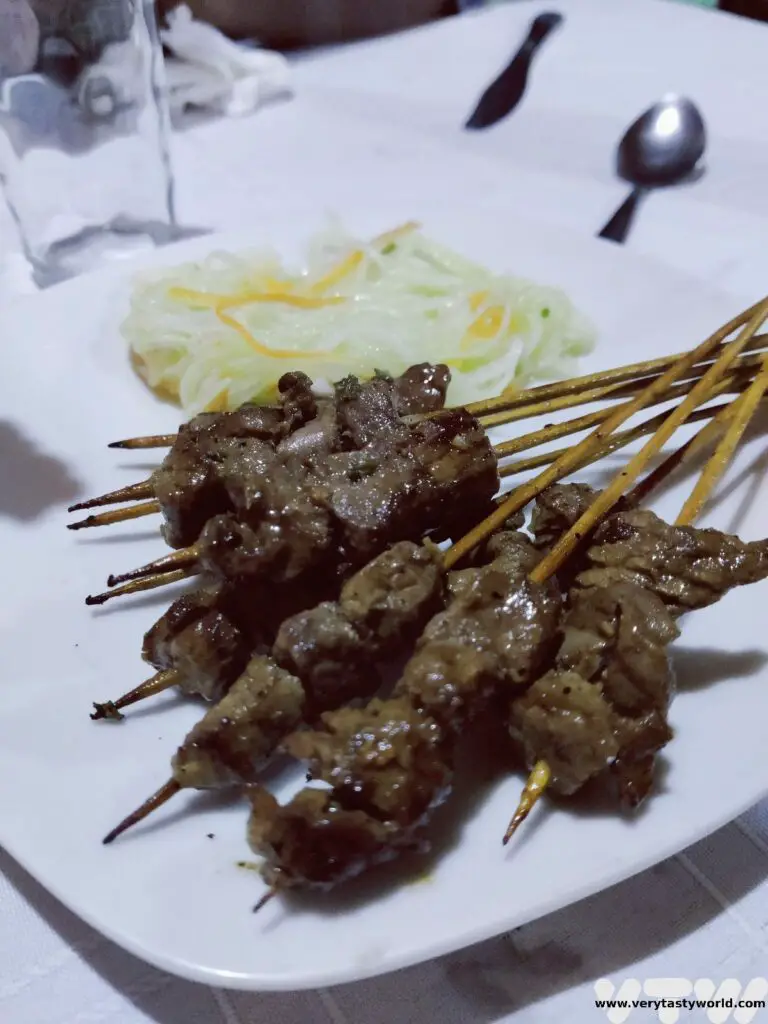
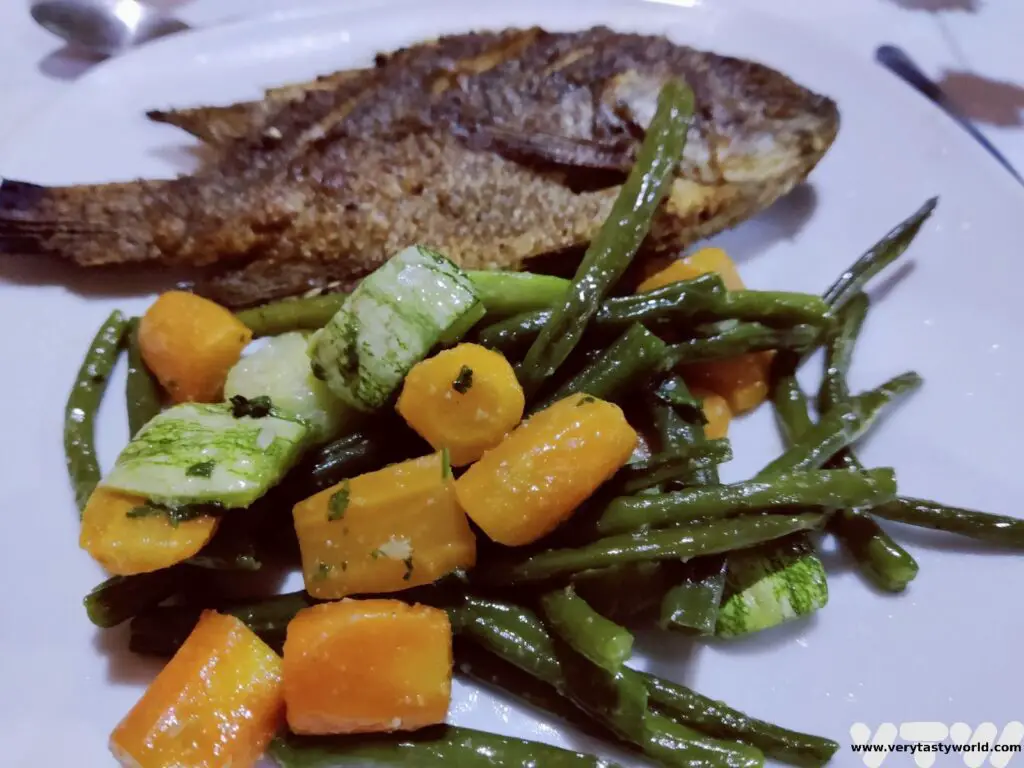
All washed down with Three Horses Beer, or THB, is the most popular in Madagascar. It’s a light, refreshing lager. The food is cheap and hearty.
Return To Tana
We left Andasibe and began our journey towards the capital. It was a 150km drive lasting about 3.5 hours so we broke it up by visiting the Peyrieras Nature Farm. Located half way along the route, 75km from Tana, this is a small privately run reserve at Marozevo, between the towns of Manjakandriana and Moramanga. It was founded by a French entomologist called André Peyriéras. We were able to see their butterflies and reptiles. Although Madagascar is best known for its lemurs we consistently found the reptiles to be absolutely fascinating as well. The sheer variety of chameleons was astonishing




And we never failed to be surprised at the amazing camouflage abilities of the geckos, which can flatten themselves to the trunk of a tree in admirable attempts to deter predators.


And, of course, we couldn’t pass by the adjacent forest area which supports families of habituated Verreaux’s Sifaka lemurs. We were able to meet them and feed them choice bits of banana.


Lunch at Amanistena
Amanistena on RN2 is a fairly unremarkable town but the locals decided that they could try to benefit from tourists travelling through it to the Andasibe Mandantiba National Park, so they established themselves as a sausage town. It’s a great initiative, so we just had to stop for zebu and pork sausage with cassava powder chips and chilli sauce. And a beer. Apparently Madagascar’s president always stops for a sausage when he’s in the area – they’re that good!

Although the RN7 is the most popular route to follow when visiting Madagascar, we highly recommend spending an extra few days exploring the Andasibe Mantadia National Park. We were thrilled to see both the largest and the smallest lemurs as well as a plethora of other fascinating creatures and birds. We will never forget the hauntingly beautiful cry of the Indri Indri, creatures that will never succumb to captivity. See them while you can!
Related Posts You May Enjoy

- Skeleton Coast Self Drive in Namibia

- Malagasy Cuisine – The Food of Madagascar
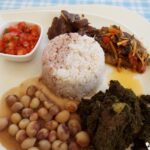
- Mora Mora on the RN7 Madagascar – A Road Trip
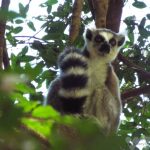
- Tree Climbing Lions, Hippo Hordes and Safari Shenanigans in Uganda
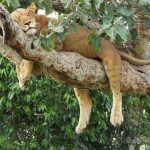
- Tourist Attractions In Ethiopia
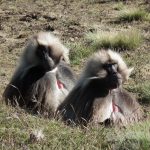
- Uganda Chimpanzee Trekking in Kibale
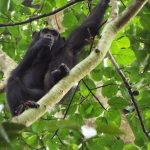
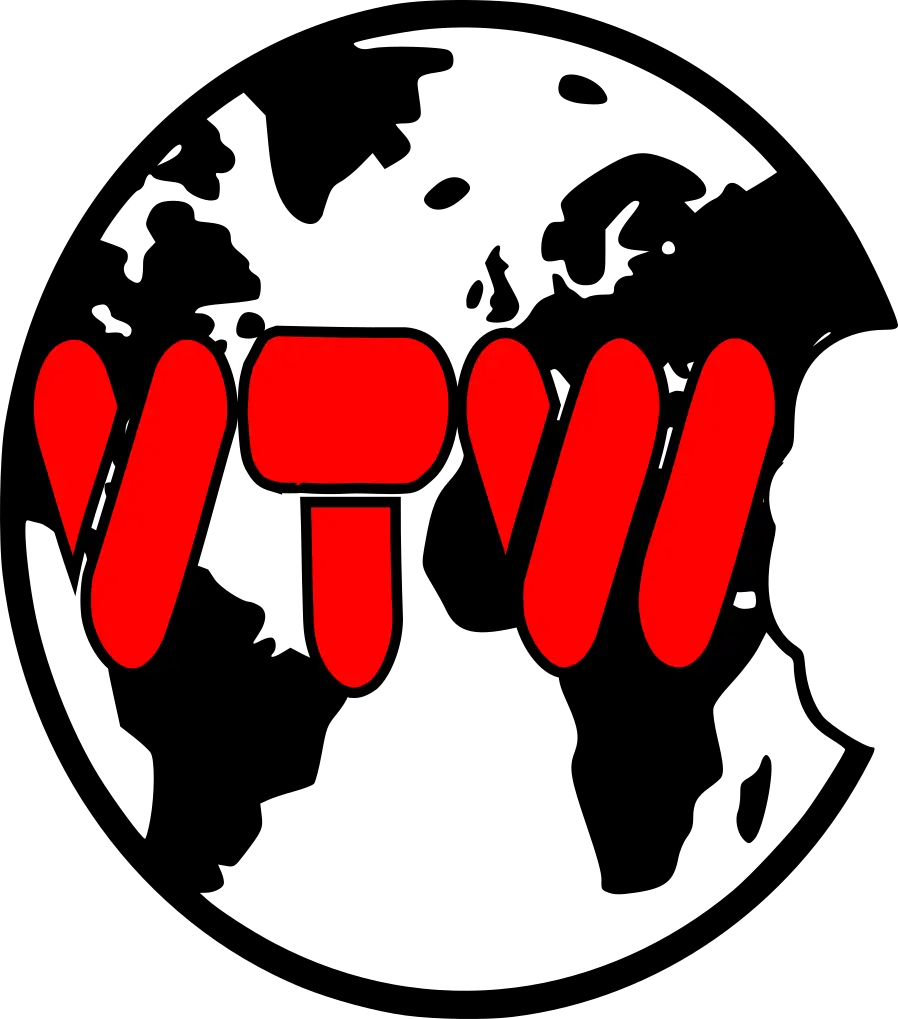
Thanks so much for reading. We hope you enjoyed this article. If you’d like to keep up to date with new posts and recipes, please subscribe to our newsletter or follow us on social media – X, Facebook or Instagram. We always love hearing from you and would be delighted to read your thoughts about this article.
RECIPE: How to Make Sushi Ginger – Gari
Sushi ginger, also known as gari, is one of the essential accompaniments to sushi and sashimi. When eating sushi you expect to find wasabi and soy sauce, which you mix together to dip your fish into. Ginger is eaten separately, between the pieces of sushi or sashimi, and its purpose is to cleanse the palette between delicious bites.
The ginger is pickled by marinating in a sweetened vinegar and therefore it has sweet and sour flavours, with a warming kick from the ginger itself.
Ginger is naturally a creamy-beige colour but you will often see sushi ginger that is a delicate pink. This is usually due to it being pickled with red shiso, a herb that is very popular in Japan. It’s also known as perilla.
Gari is very easy to make and we promise you that this recipe beats any shop bought sushi ginger hands down.
How to Make Sushi Ginger
(Makes a 500ml jar)
Ingredients
A big piece of ginger – we used about 4 pieces of this beauty. That works out at about 500g but you’ll be able to judge depending on how thinly you slice it and how much you want to squish into the jar.
1.5 cups of rice vinegar (~350ml). We recommend rice vinegar because it has a lovely flavour, but you could use white wine vinegar or white vinegar if you can’t easily find rice vinegar.
1 cup of sugar (~250 ml)
1 tbs salt
Optional red shiso or red perilla leaves (for colour)

Method
Scrape the skin off the ginger. You could use a vegetable peeler, but some people use a teaspoon just to get the finest layer of skin off. Ginger skin is edible but, because you want this to look pretty, it’s worth getting all the skin off.
Finely slice the ginger as thin as possible, ideally using a mandoline. You need the ginger to be as thin as possible so it’s worth looking into a mandoline that can slice extremely fine. You’re aiming for less than 1mm if possible.

Also, while they are great kitchen tools, a mandoline is basically a razor blade on a board and can be dangerous to clumsy cooks such as us. So do use the safeguard that is usually provided with the gadget, or wear special gloves.

If you don’t have a mandoline, a handheld vegetable peeler gets reasonable results.
Try to get a variety of shapes and sizes. Ginger has a grain so it may do this for you naturally as you slice.
Place the ginger slices in a bowl, sprinkle over the salt and mix. Leave for 20-30 minutes.

In the meantime, wash your jar with soapy water and then sterilise it by pouring boiling water in. Let it stand for a few minutes. You could also empty the water and let it dry in a barely warm oven for 10 minutes or so, but we don’t bother. Vinegar is acidic so the jar just needs to be very clean.
Squeeze the ginger to release the salty water. Do this gently so you don’t crush all the pieces together. Then pat with kitchen paper to draw out more salt water.

Place the ginger slices in the jar. Take some time to unwrap any squeezed pieces that have squished together, so that they go in as individual slices.

Put the vinegar and sugar into a saucepan and heat slowly. Wait until the sugar has completely dissolved and the mixture is about to boil.

Then pour the sugary-vinegar over the ginger in the jar.

If you have shiso leaves, this is the time to put these in the jar.
Put the lid on and let the pickle cool naturally.

Even though you’ll want to eat this immediately, you need to wait for at least a week for the pickling flavours to develop.
This will keep in the fridge for many months. Honestly, it is so good that you’ll want to get another batch pickling straight away because you will be eating this endlessly…
Related Posts You May Enjoy

- RECIPE: How to Make Sushi Ginger – Gari
- RECIPE: How To Make Elderflower Champagne
- RECIPE Oyakodon Donburi
- Zero Waste Recipes Before Your Holiday
- RECIPE: Vegetable Biryani Tamil Nadu Style
- RECIPE: Vegan Wild Garlic Pesto
- Recipe: Venetian Pasta Sauce
- RECIPE: Biryani Raita Recipe
- RECIPE: How to Make Costa Rica’s Gallo Pinto

- Is Kanazawa Worth Visiting?

- RECIPE: How to Make Sushi Ginger – Gari

- Kobe Beef in Kobe – Is It Worth It?

- Recipe: Simmered Shiitake Mushrooms

- How to Use Public Transport in Japan

- RECIPE Oyakodon Donburi

- Planning a Trip to Japan

- The Makanai: Cooking for the Maiko House

- Setsubun Food – Bean Throwing Day


Thanks so much for reading. We hope you enjoyed this article. If you’d like to keep up to date with new posts and recipes, please subscribe to our newsletter or follow us on social media – X, Facebook or Instagram. We always love hearing from you and would be delighted to read your thoughts about this article.
Heart and Seoul – Four Days in Seoul
South Korea’s capital city is a thriving metropolis, a perfect blend of historic and modern. It boasts five royal palaces nestled amidst the modern skyscrapers, and the city offers history, culture, shopping and style. It also has an amazing food scene, from street food to posh nosh, and there’s an opportunity to explore Korea’s delicious cuisine around every corner. With so much to see and do, you could easily spend much longer in this vibrant and exciting city. Our guide for spending four days in Seoul will cover the essentials and give you a flavour of what this wonderful city has to offer.
Please note that this post contains affiliate links. If you click through and decide to make a purchase we will make a small commission, at no extra cost to you, which will help towards the costs of running this site.
Getting to Seoul
Most visitors arrive from Incheon airport, about 50km from Seoul Station. There are multiple options to get into Seoul but the quickest and most convenient is the AREX Airport Express which gets to Seoul station in around 40-45 minutes. There is an all-stop train, which takes a bit longer. Buy a ticket at the machine (multiple languages available, including English) in Terminals 1 or 2 by the station entrance. Just follow the signs from the airport arrivals hall. You can choose your train and seats will be allocated automatically.
One thing that we really liked about Incheon airport was that there are a whole bunch of local people at the station who were available to help you purchase tickets. It is really useful if you’ve just arrived and are feeling a bit dazed after a long flight.
Other options for getting into the city are buses and taxis, although taxis can be expensive.
Getting Around Seoul
Seoul has a comprehensive public transport system and it is very easy to travel around. Maps and signage are available in English, Japanese and Chinese as well as Korean. We recommend buying a T-money card, an electronic money card which enables you to tap in and out at subway stations and on buses. You can top up your card using cash at machines or in convenience stores.
It’s worth knowing that some subway stations are really large and have multiple exits, so check which exit will get you to your planned destination.
One thing we did find frustrating was that Seoul isn’t very pedestrian-friendly. We love walking around cities and, although we managed to walk to a lot of the attractions, we spent a lot of time waiting to cross the road at pedestrian crossings because the traffic definitely got priority. If we saw the crossing lights change to the green man from several metres away, we’d run to cross the road so that we wouldn’t have to wait for ages!
Google maps isn’t the best app to use for getting around. It’s not very detailed and we found it was particularly difficult to identify how accessible green spaces were.
Four Days in Seoul Day 1- Ancient and Modern
Day 1 Morning in Myeongdong
Make your way to City Hall metro station on subway line 2. This is the perfect stop to wander around Myeongdong. The area perfectly illustrates the contrasts between Seoul’s old and the new as Deoksugung Palace lies nestled amidst the modern high-rise buildings.
Deoksugung
Deoksugung is one of the smaller palaces. It was inhabited by the Korean royal family from the Joseon dynasty,until Japan annexed Korea in 1910.

At the far end of the complex is the National Museum of Art. When we visited they were showcasing one of Korea’s earliest modern artists, Chang Ucchin. There is a small fee to enter.

Make sure to time your visit for the changing of the guard – at 11am, 2pm and 3:30pm (except Mondays). These events are free and takes place in the palace courtyard, outside the main complex, so they will draw the crowds. Be prepared for lots of pomp with raucous music and crashing drums. You can also pose for photos alongside some of the guards after the event has finished.

Seoul Museum of Art
Just around the corner from Deoksugung is SeMA – the Seoul Museum of Art, operated by the city council. You can wander through the outdoor sculpture park before exploring the museum to view permanent and temporary exhibitions from contemporary artists. Entry is free.
City Hall
City Hall is just across the road from Deoksugung Palace, a screamingly modern building with a cool exterior and interior – notably the green living wall inside.

You don’t need to spend too long here, it is largely an administrative building but you can use the elevator to visit the upper floors and get a view over the city. It also hosts various exhibitions.
Entry to City Hall is free.

Day 1 Afternoon – Choice of Cookery Class or Seoul Tower
There are a couple of choices, depending on your interests. If you want to learn more about Korean food, we can recommend the Hello-K cookery course. It involves meeting at a set location and joining a small group of like-minded foodies. The afternoon starts with a tour of a local market where your host will introduce a vast variety of ingredients.




Then it’s back to the family home and a cookery class. Everyone gets their own cookery station and we all cooked together. We made bibimbap (lovely ingredients beautifully arranged over rice), pajeon (Korean pancakes), dakgalbi (spicy chicken) and some banchan side dishes.


And then of course you get to eat your delicious meal – no need to worry about finding a place to eat dinner tonight!

Alternatively you could spend the afternoon exploring the lovely park on Namsam Mountain with Seoul Tower, an observation tower at the top. It’s the second-highest point in Seoul. You can hike around the park or catch a cable car.
If you did the cookery course you won’t be hungry, but if not, why not head back to Myeongdong Market where you can shop for all sorts of souvenirs and enjoy some seriously good street food. It’s located near the Sungnyemun Gate.

Four Days in Seoul Day 2 – A Day Trip to the DMZ
No trip to Seoul would be complete without an excursion to the DMZ – the demilitarised zone which demarcates the border area between South Korea and its mysterious neighbour to the north. This tour offers a fascinating insight into modern Korean history.
At the time of visiting, it was not possible to visit the JSA – Joint Security Area – which is the actual border between North and South Korea. However, the DMZ tour is fascinating.
Need to Know: You cannot travel to the DMZ independently – you have to go with a tour. Even if you book a private tour you may travel to the zone in a car but you will still have to get on a coach with a group.
You will need to bring your passport and will have to give it – temporarily – to the tour leader when they obtain your ticket and register you as a visitor. Your passport will be returned and checked by soldiers on entry to the zone and when you leave.
The DMZ Tour
The Peace Park
The first part of the tour takes you to the Peace Park. The park was built in 1972 in the spirit of peace and, hopefully, reunification one day. There are a number of exhibits and memorials here as well as, somewhat curiously, a theme park.
The Freedom Bridge was built as a temporary structure to allow an exchange of prisoners of war in 1953. It is not possible to cross the bridge these days.
There is also a dilapidated steam locomotive that was derailed during the war. Riddled with bullets it has remained in situ for decades, slowly rusting.

You can cross the Imjin river in a gondola and climb the hill to view an exhibition about the war, including a number of foreign countries whose soldiers were involved. We were surprised at the number of British soldiers who fought in the Korean War.

Observing North Korea
Passports are checked before entering the DMZ proper. The next stop is the Dora Observatory where you can use binoculars to look into North Korea. When you gaze into North Korea, North Korea probably gazes back at you.

Sometimes it’s a bit hazy but you can see two villages that are located on either side of the border. The South Korean side is occupied, the North Korean is not – apparently the windows on the buildings are painted on.

The South Koreans who live in this village, so close to the border, do not pay tax, do not have to do military service and have free healthcare.
Third Infiltration Tunnel
The blue line painted on the road marks the official DMZ. The next stop is the Third Infiltration Tunnel. There is an exhibition centre with audio-visual presentation.

You can also go down the third infiltration tunnel. This is one of a series of tunnels constructed by North Korea with the aim of getting 30,000 troops per hour into the South should they decide to invade. Defectors claim that there are ten tunnels but only four have ever been found. We walked down the shaft to the tunnel and through it to the end, about 170m from the border. It’s not too claustrophobic in there. Photos are not allowed inside the tunnel.

This is also a place to buy souvenirs of the visit. One that may be of interest to foodies is a blueberry wine made to a traditional recipe from a North Korean defector.
Four Days in Seoul Day 3 – Palaces and Hanok Villages
Day 3 Morning – Gyeongbokgung and Bukchon
This is the day to go back in time, to the Jongno District in central Seoul, to explore more of Seoul’s palaces and also a traditional Hanok village. Anguk station on Line 3 or Jongno 3 on Lines 1, 3 or 5 are good starting points. This is a long day, with loads of attractions, so you might want to prioritise some over others, so that you can spend more time at the places that are of most interest.
The palaces have a small fee to enter and you can buy a ticket at the entrance. However, if you arrive dressed in hanbok – traditional Korean attire – entry is free. You can hire these clothes in nearby stores. If you love dressing up this is a fun activity. They offer a full range of sizes.
Gyeongbokgung Grand Palace
Start at Gyeongbokgung, another palace with a changing of the guard ceremony. It is the largest of Seoul’s grand palaces and was the primary royal palace of the Joseon dynasty.

Built by King Taejo in 1395, it was destroyed during the Japanese invasion of 1592–1598, restored during the 19th century but destroyed once more by the Japanese at the start of the 20th century. It has been slowly restored since the 1960s.

This is the most impressive of the grand palaces. It has a large number of beautiful buildings set amidst a delightful walled garden complete with pavilions and ponds.


Adjacent to the palace is the Korean Folk museum which is free to enter. This fascinating museum has several permanent and temporary exhibitions showcasing traditional life in Korea.


A Traditional Hanok Village
Moving east, head towards Changdeokgung Palace via the Bukchon Hanok Village. A Hanok is a traditional Korean house. Bukchon means ‘north town’ and this village features over 800 wonderfully photogenic houses. It is visited by a large number of tourists so there are lots of shops and cafes in the area.

It is possible to visit Baek In-Jae’s house (free entry) to learn more about the area and peek inside some of the rooms. He clearly made a lot of kimchi!


It’s important to be aware that people live in these villages and there are signs on some streets asking visitors not to be too noisy.
Day 3 Afternoon – Changdeokgung, Jongmyo and Some Foodie Fun
A quick foodie surprise as we left the village was Hansik Space E:EUM on 18 Bukchon-ro, a museum dedicated to hansik – Korean food. We came across it as we strolled past. There are some interesting exhibitions about ingredients and cooking methods as well as a room full of Korean booze where we got the chance to sample some sochu (a popular Korean spirit). We also managed to find a makgeolli (rice wine) brewing kit which made a fantastic souvenir.
Changdeokgung Palace
The next royal palace is the Changdeokgung Palace, a UNESCO world heritage site. In the early 15th century, the King Taejong ordered the construction of this grand Changdeokgung Palace Complex to complement the main palace of Gyeongbokgung. Changdeokgung is situated at the foot of a hill and the buildings and landscape have been carefully designed to complement the geography of the area. It has a large ‘secret garden’ (extra cost to visit).

Jongmyo Shrine
To the south of Changdeokgung lies the Jongmyo Shrine, a fascinating site that was a former shrine for the internment of the kings and queens of the Joseon dynasty. The entrance fee is nominal and there are guided tours in multiple languages on weekdays. The sign outside indicates when the next tour will be. The tours last around an hour and offer a fascinating insight not only into the shrine and its buildings but also the traditions and practices of the Joseon royal family. Make sure you don’t walk on the raised paths as these are for the spirits alone. (You’re allowed to walk where the kings walked though – only the dead get special treatment.)


Finally, if you have time, head back to The Kimchi Museum – Kimchikan – just off Insa-dong Cultural Street. An essential visit for foodies, it is located on the 4th, 5th and 6th floors of the Insa-dong Maru building. It is open from 10am to 6pm. Korea’s national dish, a food so famous that it is UNESCO listed, is eaten with pretty much every meal. This fascinating and highly interactive museum has exhibits showing the history of kimchi, offers recipes for different types of kimchi and even offers kimchi tasting!


Insa-dong Cultural Street is a good place to seek out restaurants for your evening meal – there are a variety of establishments offering many different types of Korean cuisine.
Four Days in Seoul Day 4 – Art and Museums, Fish Market and A Park
Leeum Art Museum
Catch the subway to the Leeum Art Museum. Line 6 will take you to Hangangjin Station and use Exit 1. Then walk up the hill to the museum. It houses both traditional Korean art (free) and contemporary art exhibitions (which have a fee). Take the lift to the top of the building and then wend your way down, looking at Korean art from across the ages.


The staircase is a work of art in itself.

From Leeum catch Line 6 to Samgakji Station then change to Line 4 for Ichon and the National Museum of Korea.
National Museum of Korea
This splendid museum, set in a large park, is brilliantly designed and gives a comprehensive account of Korea with a wealth of objects all laid out in a way to illustrate the country’s long and rich history.

The upper floors showcase objects from around the world. Entry is free and you really can spend hours here.

Hangul Museum
If you have time, the Hangul Museum is located in the same park. We found this museum fascinating and receommend a visit.

Hangul is one of the few alphabet systems that can actually be dated – it was invented in 1443 by King Sejong the Great, the fourth monarch of the Joseon dynasty. He was a very enlightened leader who wanted to improve literacy amongst the people.

Before the invention of Hangul Koreans used a version of Chinese characters but these weren’t really suited to the language. Hangul is phonetic, consistent and a surprisingly easy script to learn. We managed to pick it up (using visual mnemonics) in a just few hours. It was pretty helpful while we were travelling. The museum is fascinating and well worth a visit. Again, entry is free.

Noryangjin Fish Market
If you’re feeling hungry after all that culture, we recommend a seafood meal at the Noryangjin Fish Market. Back on the subway, take line 4 to Dongjak, then change to Line 9 and the Noryangjin Fish Market stop.
This is one of South Korea’s largest fish markets. The sheer quantity and variety of seafood on offer is astonishing.

There are a range of restaurants upstairs, so you can enjoy a meal of the very freshest fish. If you’re feeling adventurous you can buy fish from the market, take it upstairs and ask a restaurant to cook it. Alternatively you can get a table and the staff will purchase the fish and cook it for you. Many restaurants have instructions in English outside, so that you can understand what deal you are getting. If you bring your own fish you’ll be charged a table fee and a cooking fee, which may be reduced if you also order the restaurant’s own fish soup.


We recommend eating early if you are visiting at the weekend. We arrived at 4:30pm, had a look around and were lucky not to have to wait for a table when we ate at 5pm. By the time we had finished eating, customers were queuing out of the door, many carrying platters of raw fish they had bought in the market. And, even though there were long queues, once we were seated, there was no pressure from the restaurant to hurry.

Yeouido Han River Park
If you have time – and it’s a bit of a convoluted journey considering it’s not that far from the fish market – you can spend the evening at Yeouido Han River Park. It’s a lovely setting right on the riverside. It was made famous (for us) in the film The Host, directed by Bong Joon Ho, which features a giant mutant monster emerging from Seoul’s river. We went to look for the monster later in the evening and are pleased to report that it wasn’t there. Well, at least, we didn’t see it…

Although these four days in Seoul can only really scratch the surface of this amazing city, it is possible to see a diverse range of sights within this time. We can’t wait to return.
Related Posts You May Enjoy

Thanks so much for reading. We hope you enjoyed this article. If you’d like to keep up to date with new posts and recipes, please subscribe to our newsletter or follow us on social media – X, Facebook or Instagram. We always love hearing from you and would be delighted to read your thoughts about this article.

Amazing Azores – A Sao Miguel Itinerary
The gorgeous Azores are an archipelago of nine islands located right in the middle of the Atlantic Ocean. They are a haven for marine life, notably whales and dolphins, and viewing these marvellous mammals is one of the key attractions. But it’s not all about the sea, the islands are truly beautiful and have some interesting landscapes to explore as well. Sao Miguel is the largest in the group and the easiest to reach. Our Sao Miguel itinerary has a combination of active and relaxing activities, including wildlife viewing, nature excursions, cultural sites and foodie fun.

Please note that this post contains affiliate links. If you click through and decide to make a purchase we will make a small commission, at no extra cost to you, which will help towards the costs of running this site.
Where are the Azores?
The Azores are located right in the middle of the Atlantic ocean, about two-fifths of the way between Europe and America. They are an autonomous region of Portugal.

Azores’ location in the Atlantic. The largest island is Sao Miguel with its main town, Ponta Delgada.

When To Visit The Azores?
The Azores can be visited all year round. Thanks to their location, they have a mild climate with an average temperature range between 12C (winter) and 25C (summer). The islands do see a lot of rainfall, which accounts for the lush greenery, but the drier season runs from April to August. However, these ‘drier’ months can see a fair amount of rain as well!
If you are interested in whale and dolphin watching, you will be able to see species all year but some visitors are seasonal.
The resident species are:
- Common dolphin
- Bottlenose dolphin
- Risso’s dolphin
- Sperm whale
The regular seasonal species are:
- Atlantic spotted dolphin – June to December
- Striped dolphin – March to September
- Blue whale – March to June
- Fin whale – March to June
- Sei whale – March to July
- Pilot whale – April to October

Of course whales and dolphins do not have a precise calendar, so these dates are not fixed – some years they may pass through earlier, some years they’ll be later. And because they are wildlife, sightings cannot be guaranteed, although there is usually a good chance of seeing something.
How To Reach the Azores
Most people fly in to Sao Miguel which has the archipelago’s only major airport. There are regular flights from Lisbon and other European cities. Visitors often choose to stay on Sao Miguel but, if you have more time, it is possible to explore some of the other islands. You can fly inter-island or catch a ferry.
Where to Stay in Sao Miguel
Ponta Delgada is the main town on Sao Miguel. It’s just a 10 minute drive from the airport. It’s a small and very pretty town that is very easy to walk around. There are plenty of hotels to suit any budget.
We stayed at the Canadiano Urban Nature, a three star hotel. We had a large room with balcony and a fine buffet breakfast was included. The staff were delightful and very friendly.
Notes About Our Sao Miguel Itinerary
We recommend booking any marine life viewing trips early on in your holiday because the weather can sometimes be unfavourable for going out to sea. Boat trips may need to be cancelled, and this could happen at short notice. The tour companies monitor the weather and sea conditions regularly and will keep in touch – so it’s important that you give them contact details. If your trip is cancelled on a particular day, the tour operator will usually be able to rearrange your excursion for later in the week.
We also suggest that you book these trips in advance as places are likely to fill up during the high season. If the weather is bad on your first few days and your sea excursion is delayed to later in the week, then it’s very easy to swap around some of the days in this itinerary, and we have some suggestions for indoor activities. Refunds are given if a trip has to be cancelled entirely.
Sao Miguel Itinerary Day 1 – A Marine Wildlife Boat Trip
The Azores are famous for their thriving marine life, especially the whales and dolphins that populate or pass through the seas surrounding these lovely islands. There are various tour companies that run trips several times a day from the harbour in Ponta Delgada. The excursions usually last around 3-4 hours.
There are primarily two types of boat for the trips – a large catamaran or a Zodiac RIB. Each has advantages and disadvantages. The catamaran can accommodate more people so can get a little crowded, especially when everyone rushes to the side of the boat to peer at the marine life. The Zodiac has a much smaller capacity but the ride can be bumpier and your seating position is fixed – you can’t move around the boat.

There will be a marine biologist on each boat and they explain about the different types of species that can be seen. They are great at spotting wildlife and have equipment to locate the whales. They also look for the ‘blow’ (a spout of water vapour) as the whales exhale – sperm whales have a blow hole on the front left side, blue whales have two blow holes.

On our first trip out we saw lots of Atlantic Spotted Dolphins who were happy to swim alongside the boat.

Then we came across a sperm whales. These magnificent creatures feed on squid and octopus on the sea floor. They dive to the bottom of the ocean for up to 45 minutes, down to a depth of around 1000m.

The biologists will also let the boat know when the whale is about to dive – the head bobs up. Then they dive and you see famous tail flick. Timing the photo of the famous tail flick can be tricky so we thought it was better to watch and enjoy. Many of the marine biologists have amazing cameras and will share photos from your trip. The boat trips usually last around 3-4 hours.
In the afternoon take some time to explore the lovely town of Ponta Delgada. The three arches of the city gates, Portas da Cidade, are the entrance to the city. They were built in the 18th century and later moved to Gonçalo Velho Cabral Square. There is a legend that if a couple walks through the central arch together, they will stay together until the end of their days. Well, we had to… and we received a round of applause from local bystanders as we walked through holding hands!

Ponta Delgada is a lovely town to wander around and has plenty of shops, restaurants and cafés.

Even the paving stones are pretty…



Sao Miguel Itinerary Day 2 – Marine Viewing Trip in a Zodiac
Whale watching in a Zodiac RIB – this is a smaller vessel where you are much closer to the sea. These nippy boats can also reach the marine life more quickly if a whale is spotted. But – they are bouncier so may not be the best option if you are likely to suffer from seasickness. If you have a tendency to feel queasy on the ocean, try to sit near the back of the boat.
On all the whale watching trips we were impressed that the animals’ welfare was top priority. All the boats have to adhere to a specific set of rules: they can only ever follow a whale and are never allowed in front of its path. They must also stay at least 50m from the whales, but most remain 100m away, which is more responsible. Although we got lucky when a curious baby sperm whale approached our boat to enjoy some human watching while her mum was feeding on the ocean floor.

Some common dolphins accompanied us back to shore.

In the afternoon we recommend a visit to the botanical gardens. Jardim Botânico António Borges is delightfully designed. It has all sorts of nooks and crannies with lovely paths, small cliffs, bridges, caves and grottoes. It also has a small café. There are several botanical gardens in and around Ponta Delgada and, although they were all great, this was our favourite.


Sao Miguel Itinerary Day 3 – Day Trip To Las Furnas
You could hire a car and drive to Las Furnas but we decided to opt for an excursion. They are good value, well organised and lunch was included. There are plenty of options to choose from, depending on your interests, and most companies will pick you up from your accommodation. The Las Furnas trip perfectly demonstrates how geologically active the island still is.
The day starts with a trip to one of Europe’s only tea plantations – where you can see the tea growing, observe the tea being processed using traditional equipment and, of course, enjoy a cuppa.

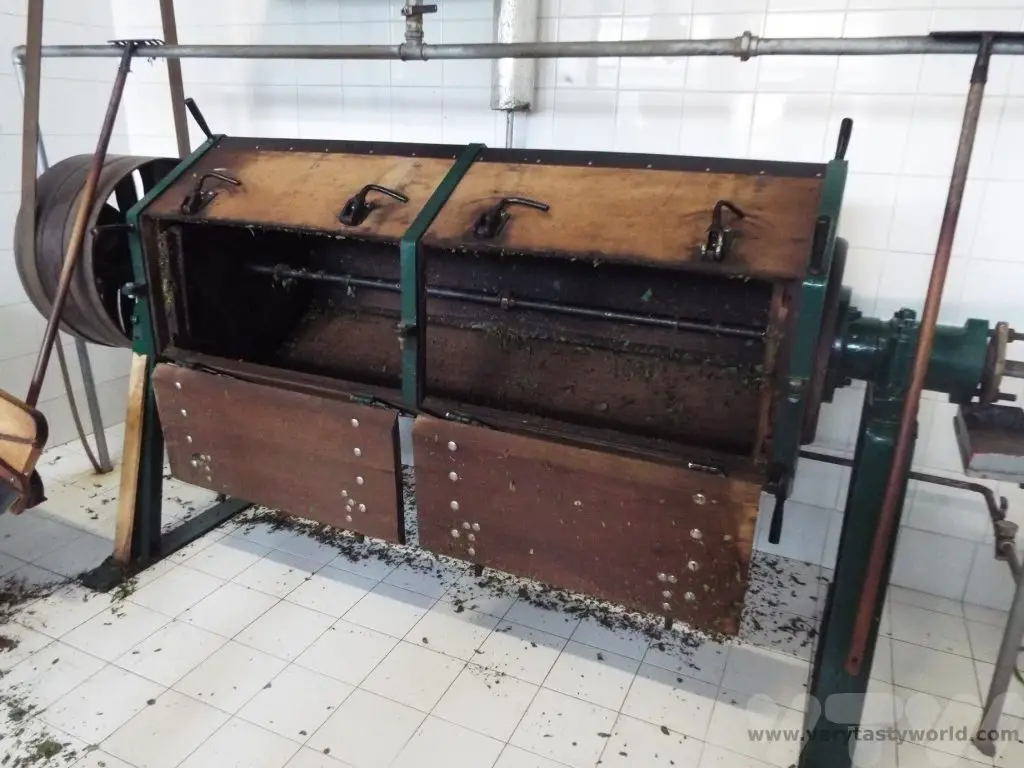
The next stop is the Lake Furnas viewing point. Sadly it was a bit of a murky day.

We then descended to the local town which smells of sulphur and steams copiously. There are many fumeroles which bubble and hiss, squirting boiling water and steam from the depths of the earth.


Then it’s a trip to the lakeshore. One of the great things about this trip is that, not only is lunch included, lunch has been cooked inside a volcano! Cozido is a dish comprising meat and vegetables that have been placed in a large pot and then buried in a hole in the ground for around six to seven hours. There is a fenced-off area next to the lake which has mysterious mounds of soil, each with a name tag.

At around 1pm the restaurants’ vans arrive to collect their food. Then it’s back into town to enjoy a leisurely lunch. If you are vegetarian, let the restaurant/tour company know when booking and they can arrange a veggie cozido untainted by meat.
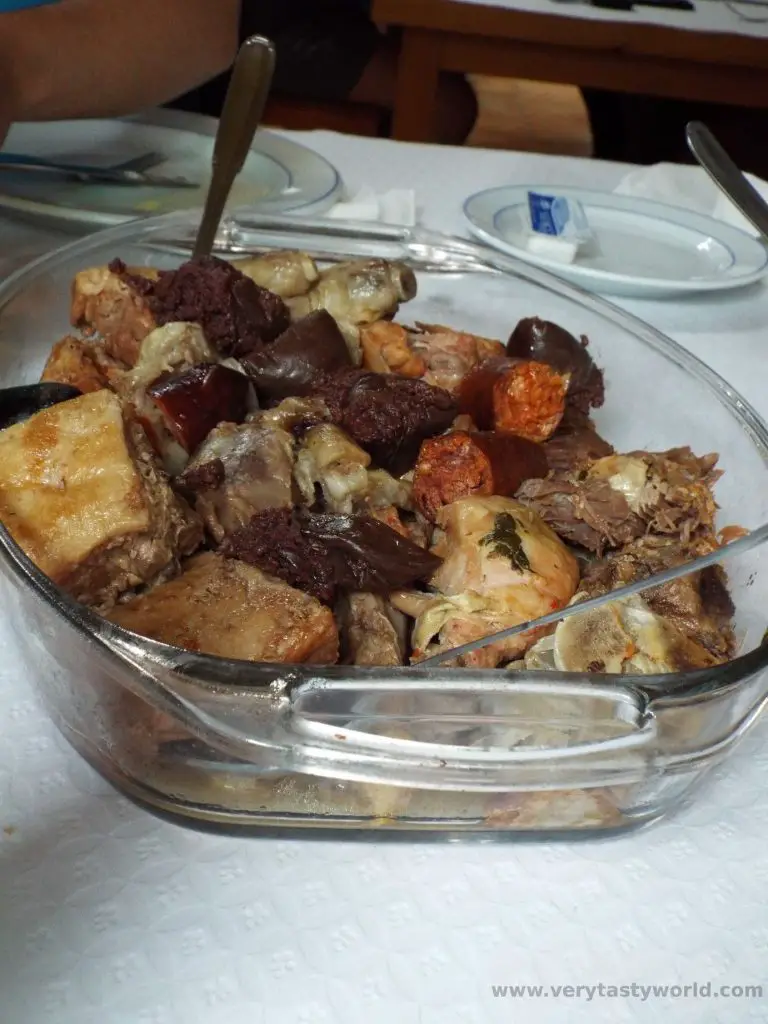
And what better way to relax after lunch than relaxing in a thermal pool at Tanque Termal Parque Terra Nostra? The rusty colour of the water isn’t particularly inviting but they are a delightfully warm temperature, fed by the local hot springs.
We left our valuables in the minibus and just changed into our swimwear by the edge of the pool. It was actually quite nice that the weather was a bit cold and grey – soaking in a warm, mineral-rich pool was very pleasurable. We bathed until we were all wrinkly then wandered around the lovely gardens.
Sao Miguel Itinerary Day 4 – Day Trip to Sete Citades
Sete Citades is located on the west side of the island. The name means ‘seven cities’ after a legend where an archbishop and six of his bishops each established a city in the area. However, apparently disaster struck and all the cities were sunk.
The Azores are volcanic and a vast caldera was formed when a volcano collapsed in around 1445. Two lakes have formed – Lagoa Verde with its green waters and Lagoa Azul with water of azure blue. They are separated by a bridge, which has seven arches.

A delightful area to visit, the main caldera is comprised of two lakes, each of which has a distinct colour – one with blue water, the other with green. There is another legend that a princess fell in love with a lowly shepherd and planned to marry him. But her father disapproved of their union and told them he would never allow it. She obeyed the king and broke it off and, when the lovers last met for the final time, they cried. The tears from her blue eyes coloured the larger lake and the tears from his green eyes tinted the smaller pool.
There are all sorts of activities in this area. We enjoyed mountain biking along the shores of the lakes and then went kayaking on the lakes. It’s possible to kayak underneath the bridge. Stand-up paddleboarding is also available.

And, of course, it’s the most delightful area to go walking in. You could hire a car from Ponta Delgada or arrange an organised trip which includes the activities.
Sao Miguel Itinerary Day 5 – Exploring Ponta Delgada
These are places to visit along coastline in Ponta Delgada and out to the eastern side of the city.
Museu Militar dos Acores
A military history museum that is located inside a 16th century fortress, this documents the history of the islands’ defence over the centuries.


Pineapple Plantation
It’s a fair walk (but definitely walkable) and we recommend a visit to the Azores’ pineapple plantation, located on the outskirts of Ponta Delgada. You can visit the greenhouses to see the pineapples growing and watch audio-visual displays showing the cultivation process.
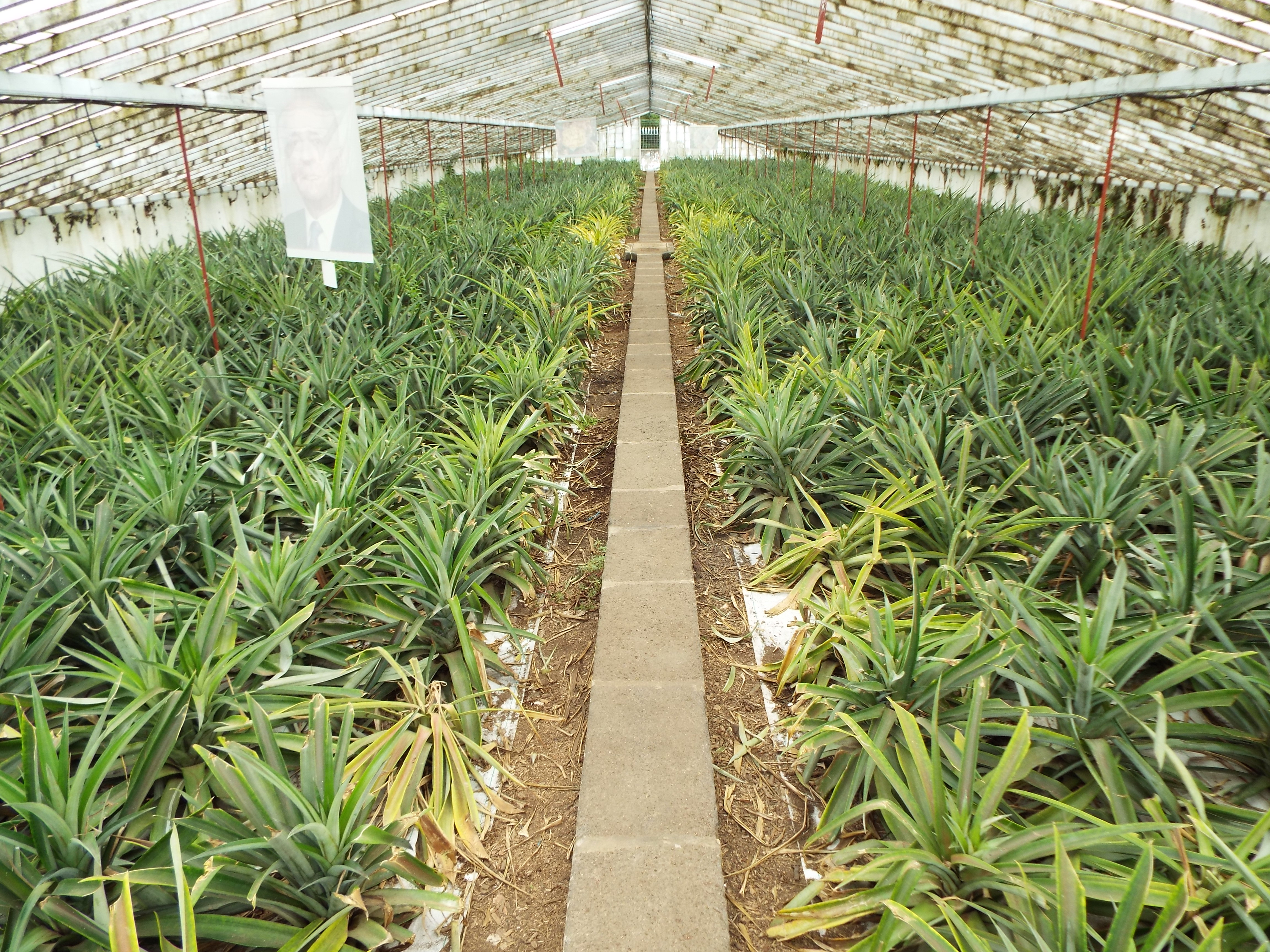
Best of all is the café where there are free samples of pineapple liqueur and a dollop of jam on a teeny slice of toast. And there are lots of other pineapple-y delicacies to buy, including decadent cocktails and delicious ice-cream. Also, this is a great place to shop for foodie souvenirs.
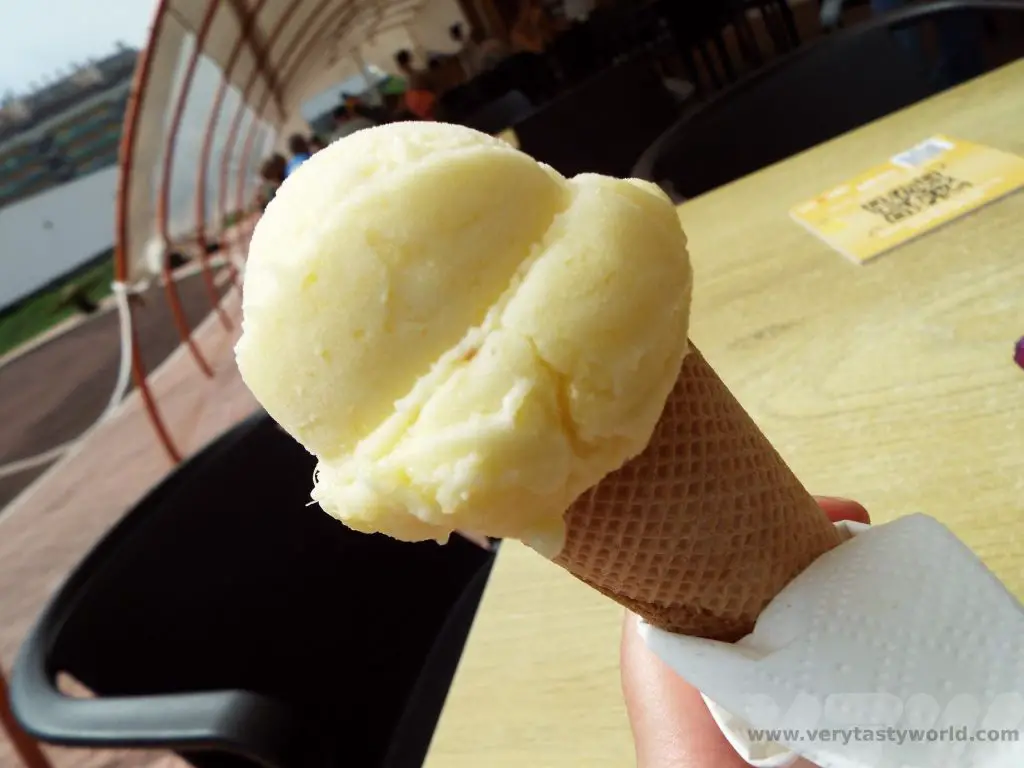
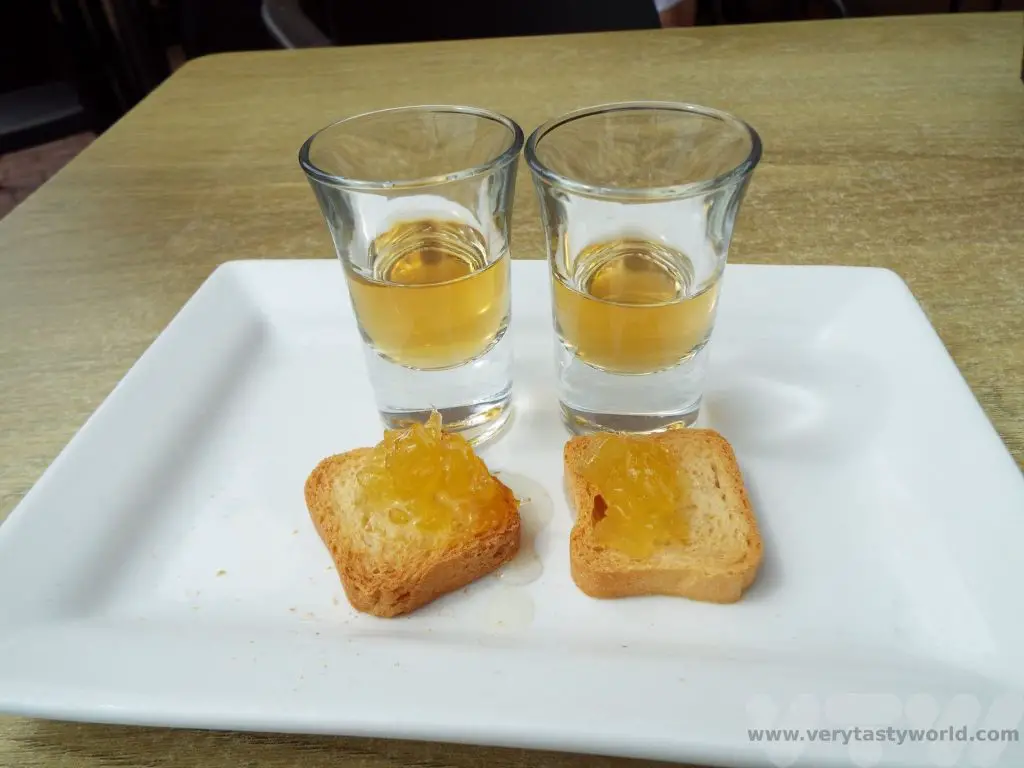
Bathing at the Bathing Complex on the Shoreline
On the way back to the city, if the weather’s nice you can spend the afternoon relaxing at the Ponta Delgada Bathing Complex. It has saltwater swimming pools as well as a terrace right on the ocean shore, so you can look out to sea as you swim. Don’t forget your bathing gear!
Sao Miguel Itinerary Day 6 – Explore Ponta Delgada’s Museums and Gardens
Ponta Delgada has some interesting museums and churches to visit. These are great, particularly if the weather is a bit on the damp side.
Museu Carlos Machado – Museum of the Azores

This is eclectic museum has three elements: Natural History, Memory of the Convent and Sacred Art.
The Natural History museum documents the history and the geography of the islands, as well as the fauna and flora. It has some interesting exhibits and amusingly disturbing taxidermy!

There are also paintings by local artist Domingos Rebelo, who was known as the Picasso of the Azores.
Adjacent to the museum is a former convent where it’s possible to view the building and its artefacts.

The Jesuit College Church is connected with the Museo and inside its impressive building is a highly decorated altar which is a fantastic example of gloriously elaborate Baroque religious architecture. It also houses exhibits of religious art from the 17th and 18th centuries.

Jardim Botânico José do Canto
This is another lovely botanical garden that has a more traditional feel as well as a wide variety of plants and trees from all over the world. It has a seriously impressive fig tree.

Cheese Is Good
Don’t forget to go shopping for some foodie souvenirs. The Azores produce around 50% of Portugal’s cheese, so we definitely recommend bringing some back home with you. Two of the shops in Ponta Delgada: King of Cheese and Prince of Cheese are (rightly) not at all modest about the quality of their product!
You can sample the wares in both shops. The staff can vacuum pack your cheesy choices so that you can take them home. We bought large wedges of utterly delicious cheeses with us and they survived the journey very well.
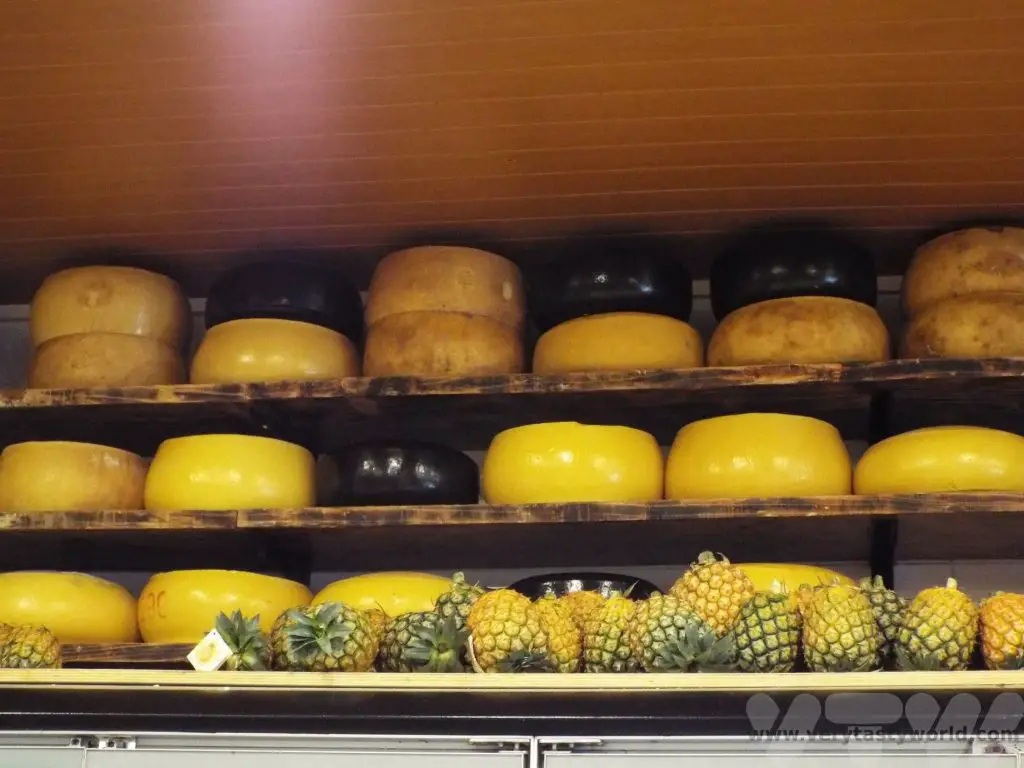
We have a post about the food of the Azores, which has some recommendations for places to dine as well as local specialties to try.
Other Things to Do in The Azores
If you are planning to stay longer there are lots of other places to visit. Here are some suggestions:
On Sao Miguel
The Gruta do Carvão – Just on the outskirts of Ponta Delgada is the Gruta do Carvão, a lava tunnel formed between 5000 and 12000 years ago. You have to be accompanied by a guide so it is worth booking ahead in the busy season.
Lagoa de Fogo – another caldera in the mountains with a beautiful lake.
Go Walking – There are a large number of trails for walking in delightful scenery all around the island. You may need to hire a car to reach these. Here are the Sao Miguel official trails.
Visit the charming Vila Franca do Campo Islet by boat or even kayak. This little islet is a nature reserve, another volcanic island. But here the circular crater is open up to the sea, so it has a natural bathing pool which is protected from the strong waves of the Atlantic and is a lovely place to swim.

Other Islands
The other Azores have a lot to offer the visitor and if you have time, you can visit these. Each island has different characteristics. The quickest way is by flying on the inter-island airline AzoresAirlines. Alternatively there are inter-island ferries. We recommend planning and booking your transport and accommodation early.
Related Posts You May Enjoy

Thanks so much for reading. We hope you enjoyed this article. If you’d like to keep up to date with new posts and recipes, please subscribe to our newsletter or follow us on social media – X, Facebook or Instagram. We always love hearing from you and would be delighted to read your thoughts about this article.

Rivers and Rainforests – A Guyana Itinerary
Guyana is one of the most densely forested countries in the world. Located in the northeast of South America, over 90% of its landmass is covered in lush rainforest. One of the things we most wanted to do on our recent visit was to explore the rivers and rainforests of this fascinating country. Here is our Guyana itinerary.
In order to make this journey we found a local tour operator, Adventure Guianas, who were able to book the accommodation for us and arrange the transfers between locations. Guyana receives very few visitors. Only around 5000 people visit purely for tourism each year. Indeed, outside Lethem and Georgetown we didn’t see any other visitors at all.
Where is Guyana?
Guyana is a small country which borders Venezuela, Brazil and Suriname. It was the only British colony in South America and hence the only country in this continent which has English as its main language. The country gained independence in 1966. Guyana is a word derived from the indigenous language and means ‘The Land of Many Waters,’ a description that couldn’t be more appropriate.

In his book, 92 Days: Travels in Guiana and Brazil, Evelyn Waugh travelled to the interior of Guyana in 1932, around 92 years before we made the journey. He didn’t seem to have a very good time at all. Waugh was a British novelist who had just been through a divorce and had decided to travel to pretty much the most remote area he could think of. So he probably wasn’t in a very good mood.
Waugh found it difficult adjusting to slow travel (in an era of much slower travel) through a challenging landscape and didn’t seem to understand the cultural differences. It was fascinating to read about his visit, embarrassingly patronising colonial language aside, and to see some of the places he described. Apparently it inspired the conclusion to his novel, A Handful of Dust.
What To Expect When Travelling Through The Rainforests of Guyana
There is a lot of travelling between locations but the scenery is spectacular and there are always wildlife viewing opportunities along the way. We were also interested in learning about the local culture, especially the indigenous people of the region. We were delighted that we were able to stay in lodges run by local communities.
Get ready for some early mornings. When we were out on excursions to look for wildlife, we’d be out very early in the morning, when the animals and birds were most active. We’d then have an afternoon siesta, when the sun was at its hottest and the wildlife was also avoiding the heat of the day. In the late afternoon/early evening, as the sun started to go down, we’d be out again, exploring the rainforest and the rivers.
The weather is hot and humid all year round. The country has wet and dry seasons, but the temperature is around 25-30C every day.
Guyana is close to the equator, so sunrise and sunset are around 6am and 6pm respectively, with a small variation (about half an hour) depending on the time of year. In the rainforest there is an insect which is called the 6 O’clock Bee, a cicada which buzzes like a chainsaw in the morning and evening, bang on time every day.
Many of the lodges we stayed in either didn’t have electricity or had solar electricity which stopped when it was dark or ran out when the battery had drained down. There was no aircon at all, but most lodges were able to supply a fan to help us keep cool… until the electricity ran out! Power banks are useful if you want to charge any electronic equipment when there is no electricity.
Some lodges had wi-fi, some didn’t. Some only had internet access in communal areas. Whenever we couldn’t get online, it was a good opportunity to switch off the phone and get away from the modern world for a while. We did take a small tablet device with us so that we could read books or watch some films offline while we were resting during the middle of the day.
Showers were always cold water but this wasn’t a problem as it provided a lovely relief from the heat. No toiletries were provided, just a bar of soap..
Creature Comforts?
There will be critturs in your room. We found it delightful that birds and bats were flying into and around our room or that frogs were hopping around the bathroom. It felt as though we were part of the natural environment.
Keep your bags zipped up so that nothing can crawl inside them when you are not looking. And you need to be aware of bat droppings – we recommend keeping your bags under the bed or underneath a shelf to avoid them being covered in yucky poo pellets in the morning. Also, beware of where you tread with bare feet.
Shake out your boots before putting them on! You never know when a scorpion has snuck inside. Our boots were generally empty each day, although Mitch did find a teeny frog in one of her boots on one occasion. It probably wasn’t harmful but a shake-out avoided it getting crushed by her foot.
You’ll need to sleep under a mosquito net. Insect repellent is also essential. We still got bitten to shreds as the nasty little insects took advantage of even the smallest patch of unsprayed skin. We are clearly delicious to the local mosquitoes! So we also made sure we had had our Yellow Fever vaccinations and we took anti-malarial pills throughout the trip. Check vaccination requirements with your healthcare provider.
We advise packing light because we there is a lot of travelling and we didn’t want to lug heavy bags everywhere. Most of the lodges are able to do laundry, some include it in the cost of the stay, others will charge a small fee.
A Two Week Guyana Itinerary
Our trip to Guyana started in its capital Georgetown, on the Atlantic coast. Most of the country’s population live along the coast. Around 90% of the people live on 10% of the landmass. Of the people living in the rainforests in the interior of the country, the majority are indigenous Amerindians.
Our Guyana itinerary largely took us to the interior of this amazing country. This is a full-on journey which took two weeks to complete.

Days 1-2: From the Coast To The Savannah
After spending a day in Georgetown, we flew to the border town of Lethem. The airport has a dirt runway and a teeny terminal. The aircraft is very small, less than 20 passengers. So your luggage will get weighed and so will you! There is ostensibly a 9kg hold luggage limit. We knew about this so packed as lightly as we could. Our bags were slightly over the limit and weren’t charged excess baggage but it’s worth knowing that there can be a charge. It’s a few dollars per extra kilogram.
Most tourists fly to Lethem – the journey takes around an hour – but it is possible to catch a bus from Georgetown. Travelling by road takes around 12 hours and this time does depend on the limitations of the ferry across the Essequibo river.
Lethem is a strange little town, located right on the border with Brazil, separated by the Takutu River which delineates the border. The lovely driver who greeted us at the airport described it as ‘small but nice.’ It has a suprising number of large retail outlets selling all sorts of consumer goods which are generally more expensive in Brazil. So it receives carloads of visitors who cross the border just to buy things. And many Guyanese cross to Brazil to pick up goods that are cheaper on that side of the border.
We didn’t spend much time in Lethem. Our itinerary was to take us across the savannahs and through the rainforest, staying at various lodges along the way. It was a circular route, anti-clockwise, starting and ending in Lethem and much of our journey was by river.

Day 3: The Savannah To The Rainforest: Lethem To Yupukari
On leaving Lethem, our first port of call was the Yupukari Amerindian village, home of the Macushi and Wapishana groups. It took a couple of hours to reach there on a largely dirt road. We stayed in Caiman House, a lodge run by the villagers, who work within the business on a rotational basis, so that each member of the village gets employment from tourism. It was a lovely place to stay – we had a large room within a small complex which included a sitting area and library.


We spent some time walking around the village and were introduced to the staff and children frequenting the local library.
In the evening we enjoyed a boat trip along the Rupununi river, spotting birds.





At nightfall, we met up with a caiman monitoring team. Caiman are members of the alligator family and the team run a project surveying and monitoring these creatures in the river. This project is funded entirely through tourism.


We observed the capture of a caiman, a male, number 836, who was caught and measured. He was fairly big at 1.66m long. Once all the data had been recorded he was released and he slunk back into the murky waters of the river.
Day 4: Yupukari to Rock View
The next morning we were up before sunrise in order to go out into the Savannah to see if we could find giant anteaters.
The grassy plains of the Savannah offer an ideal environment for termites. You can see their impressive mounds dotted like fluffy grey bushes throughout the landscape. And where there are termites there are anteaters. These extraordinary and slightly bizarre-looking creatures amble through across the Savannah in order to enjoy snacking on the insects.


After around half an hour criss-crossing the various trails, a local spotter found one, sauntering across the grassland, feeding at termite mounds and trees.

We then left Yupukari and hit the road for a couple of hours before reaching the foothills of the Pakaraima Mountains. Rock View Lodge is run by an Englishman and his family.

We enjoyed some walks in the area as well as trying local food, especially a demonstration of how to roast cashew nuts.
The family were very hospitable. We were invited to tea and biscuits at tea-time and to enjoy a rum and lime aperitif, with delicious cashews, before dinner. They were also keen to make sure that our transfer the following day could be adjusted because the planned river journey on the Rapununi was not going to be possible due to ultra-low water levels.
Day 5: Rock View To Rewa Amerindian Village
Sadly, we missed the river journey and had to drive to the landing. We were impressed at how all our hosts communicated with each other and went out of their way to ensure that the transfer went as smoothly as possible. The landscape transitioned from bone-dry Savannah to the lush rainforest. When we arrived at Rewa we were picked up to be taken to our next lodge.

Located at the confluence of the Rapununi and Rewa rivers, this is another Amerindian village community which has set up an eco-lodge. We stayed in benabs with traditional roofs woven from dried palm leaves. There is a communal dining area and it has a bar.

We thoroughly enjoyed visiting the village with our Macushi guide to see how the local people live and work. Many of the modern buildings have been constructed by the government and include schools and community buildings. It was also great to see an IT centre which the villagers can use.


Many local people still live in traditional homes and practice the farming and foraging methods of their ancestors.


We were particularly keen to learn about Amerindian farming, food and cookery.

The staple food cassava is processed to form farine (a coarse flour) and beiju (cassava bread) as well as cassareep (a sticky liquid which provides lots of flavour in cooking, including in Guyana’s pepperpot dish). These woven matapi contain grated cassava. The cassava flesh will dry out to make farine and the juice will be retained to make cassareep. Fruit and vegetables are also important in the Amerindian diet. And, of course, the river supplies bountiful fish.
Sports play a big part of village life and the local teams regularly play matches against other villages. We watched the men practice hardball cricket and the women playing volleyball. And there was plenty of wildlife to see.



The only disappointment about this lodge was that we didn’t realise that they had a giant waterlily pond close by until it was too late to visit. We had wanted to see the Victoria Amazonica with its enormous leaves and sadly didn’t have time.
Day 6 – 8: Rewa to Piraiba Lodge. Days on the Essequibo River
Another early start, we were picked up by the Adventure Guianas team who had left their base location at 2am to reach Rewa.

This was our longest river journey. We spent five hours travelling downstream right into the heart of the rainforest in the middle of nowhere. The Rapununi met the Rewa and then flowed into the mighty Essequibo.
Part of the reason for the length of our journey was that the water level was incredibly low, exposing the rounded boulders of the river’s bed. Our boat was piloted by two Amerindian guides who knew the river intimately – the deep parts and the shallow sections, sending us from one side of the river to the other, negotiating rapids (think of a theme park ride with piranha!) and also kindly pointing out interesting birds and wildlife.

At times we had to get out of the boat and clamber over the rocks while our pilots carried the boat to deeper waters. It was a magical journey along a pristine river within a vast forest and we loved every moment.
We arrived at Piraiba Lodge, a wooden construction overlooking the river. And the only construction for miles around. The lodge is on stilts because the river levels rise significantly in the rainy season. Accommodation is basic but comfortable enough.

The hospitality at the lodge was fantastic. Many of the friendly staff are Amerindians who know the jungle and river well. Our local guide Lawrence looked after us beautifully, taking us on treks through the jungle and guiding us along the river.
We spent three nights here. Our mornings and evenings were out on the river looking for wildlife and we even tried our hands at fishing. Caiman live on the river nearby, gliding nonchalantly and slightly menacingly across the water. Some are up to 12 feet long. We made sure we checked for caiman if we ventured onto the beach.

Guyana is rightly a top destination for birding and we saw a huge variety of species.



Sadly, we didn’t see river otters but had an exciting moment when our host caught an electric eel… while we were sitting in a metal boat. These fish can discharge about 700 volts of electricity, so we really didn’t want to come into contact with it! Fortunately, Lawrence managed to pilot the boat to a sandbank and released the eel using a wooden implement. It swam away quite happily and nobody received an electric shock.
The forest comes alive at dusk. In the evenings the howler monkeys howl. Initially we thought the sound was the whoosh of the wind. But there was no movement of swaying trees. There is a legend that these monkeys hate drinking water directly from the river because they don’t like seeing their own reflection. They prefer to drink rainwater from leaves. And because we were visiting during the dry season, they were howling for rain. We saw a Red Howler in a tree, just hanging around on a branch on one of our jungle walks.

In the deeper parts of the river the Drum Fish lurk on the river bed. They make a rhythmic sound in the evening. Apparently they have muscles that vibrate causing a resonant noise within the swim bladder. If you’re fishing and want a catch, they just won’t bite when drumming.
As with all lodges, all meals and water were fully inclusive and at Piraiba we could help ourselves to unlimited soft drinks from the freezer. We were also treated to some local rum. And, quite unexpectedly, the staff washed our dirty clothes for us – which was really helpful.
The food was great – lots of river fish, enhanced by vegetables, including some mega-hot little yellow chillies that grow on the adjacent land. Pork cooked in cassareep, the sweet reduced casssava juice, was sticky and sumptuous. And our hosts caught a red paku in the shallower waters one day and this was roasted for dinner that evening.
Day 9: Atta Lodge and the Iwokrama Canopy Walkway
After our stay at Piraiba, we boarded the boat again and travelled further downstream for a couple of hours to Fairview Amerindian village. It was another lovely journey, especially as we traversed the rapids.
We said goodbye to the marvellous Essequibo and started the journey inland.
The next stop was the Atta Lodge where, once again, we received a friendly welcome. We had a lovely room and electricity throughout the night. Joy! There are a couple of Black Curassows living nearby that strut inquisitively across the lawn showing off their delightful curly crests.

The lodge is located around a kilometre from the Iwokrama Canopy Walkway. This is a fantastic initiative, developed and constructed by local people, where you can climb up to a treetop canopy suspension walkway, 35m above the ground.

The walk isn’t too onerous – a climb up the hillside followed by some steps which take you up to the treetops. Then you can walk across suspension bridges to the trees and be amongst the birds.

We visited in the evening and again in the early morning, in order to see the birds of the region when they were at their most active.




After leaving Atta we made our way to the next lodge but stopped off on the road to see a very, very special bird. The Cock of the Rock is one of the most striking birds we have ever encountered – a brilliant orange colour with a distinctive head crest and fluffy feathers.
A short walk of around one kilometre took us through the jungle until we reached the rock of the Cock of the Rock. Mrs Cock of the Rock was in the nest looking after Cock of the Rock junior. She viewed us with a small degree of suspicion.


We walked a little further to see whether the male would make an appearance. Our guide used a phone app to imitate his call and, sure enough, curiosity got the better of him and he appeared, posing proudly to show off his magnificent plumage.

Day 10: Surama Eco Lodge
Then we journeyed on to Surama Eco Lodge. Another lodge set in the village of the Macushi people, we were given a tour of the area by a local guide and also enjoyed a walk through the rainforest.
Surama’s accommodation was a bit more basic. Although the room was lovely and large, there was no electricity during the daytime and a generator ran for just four hours in the evening, between 6pm and 10pm. However, the wide windows of the benab took advantage of the breeze blowing through.

We also had a number of visitors to our room, including house wrens that had built a nest in the rafters of the roof and were flitting in and out of the eaves. And a cute little frog in the shower room.


The village comprised traditional homes which were located around a shared communal area. There were two schools, a computer centre, a church, a social club and a sports stadium. We learned about life in Surama – how the residents form a council to decide about village matters.




The totem pole at the village entrance represents the indigenous peoples and depicts humans at the bottom and creatures of the rainforest in a vertical design. This includes an eagle, fish, snakes and a jaguar.

Surama Eco-lodge was very accommodating in terms of cooking local food for us. We’ve discovered over the years that it’s often okay to ask your hosts if they would kindly prepare a local breakfast and every time, they’ve been more than happy to do so. On this occasion, it was difficult to supply breakfast but they provided us with a splendid feast for lunch instead:
Pork cooked in sticky cassareep, farine and callaloo (a leafy plant cooked a bit like spinach) with garlic. It was accompanied by cassava bread, which is more like a biscuit, but perfect for absorbing all those delicious meaty cassareep juices.


Day 11 Back to Lethem
Then we returned to Lethem, a couple of hours’ drive away on a bumpy, dusty road. We popped over to Brazil in the evening, crossing at the Takutu River bridge.

This was the easiest border crossing we had ever undertaken. No need even to show passports (although we carried them with us as the border guards may do spot checks). We had a brief look around Bon Fim, which was pleasant enough but unremarkable.
There are a lot of ranchers in the area, both in Guyana and Brazil, and rodeos are held in both countries. The rodeo is hugely popular – it’s a real family event with funfair rides and music concerts in addition to the main attraction. Accommodation at both locations will be absolutely packed out when the rodeo is in town, so it’s worth considering when rodeos are taking place and booking accommodation early if possible. Many people were buying hammocks so they could sleep outside.
Day 12 Kunaku Mountains
Our final day in this area was a day trip across the savannah to the Kunaku mountains, located a short half-hour drive from Lethem. The Kunaku are considered sacred by the Macushi and Wapishana people who live nearby.

We enjoyed a hike up and down the mountain with a local guide and then relaxed by the river. There was a BBQ area and we enjoyed a delicious roasted Tambaqui fish, a delicacy of the Amazon system, accompanied by local vegetables and, of course, farine.

Then we had a leisurely walk along the river to see the Kumu Falls followed by a relaxing snooze in a hammock with a cold beer to hand.

Day 13 Back to Georgetown
The following day was a travel day as we flew back to Georgetown.
Day 14 Flight to the Kaieteur Falls
The highlight in a trip full of highlights was our flight to the Kaieteur Falls, the world’s largest single-drop waterfall. We have a post about this most spectacular Kaieteur Falls visit.

And that concluded our Guyana itinerary. Although though the term ‘off the beaten track’ does tend to get overused these days, it’s a very appropriate description of Guyana. This amazing country has so much to offer visitors, particularly nature enthusiasts. The infrastructure is still a little basic but the welcome is warm – we often received hugs from our hosts as a greeting or farewell. We can’t recommend Guyana highly enough – it’s a country just waiting to be discovered.
Related Posts You May Enjoy

- Rivers and Rainforests – A Guyana Itinerary
- Best Time To Visit Machu Picchu 2024 Update
- A 2 Week Patagonia Itinerary
- Day of the Dead in Campeche
- A Galapagos Land Based Itinerary
- RECIPE: How to Make Costa Rica’s Gallo Pinto
- A Tasty Puebla Food Tour
- Costa Rica Wildlife Sanctuary – Caño Negro
- Visit Torres del Paine National Park in Patagonia
Kobe Beef in Kobe – Is It Worth It?
One of the very best things about travelling is tasting the local food. And one local food we had particularly wanted to try on our travels was Kobe beef. But this beef, reputedly amongst the best in the world, is not only known for its deliciousness, it’s also famous for its extremely hefty price tag. We were keen to try this most exclusive of meats when we visited this region in Japan. So is eating Kobe beef in Kobe worth the hype? (With apologies to vegetarians.)
Where is Kobe?
Kobe is located in the Kansai region of Japan (the same region as Kyoto and Osaka) in the southern central area of the main island Honshu, and it is the capital of the Hyōgo Prefecture. It is a port, and one of the cities that opened up to the world in 1868, after Japan’s long period of isolation, and just before the Meiji restoration. It is a lively and cosmopolitan city with plenty of things to see and do.

What Is Kobe Beef?
Kobe beef is one of the world’s most luxurious meats. It’s characterised by the high level of fat content, marbled through the flesh, which means that the meat has both flavour and a sublime melt-in-the-mouth texture.
Like many foods of distinct origin, there are a number of very strict rules to ensure that only cattle bred in a specific region and to the highest standards can bear the name Kobe beef.
The Kobe Beef Marketing and Distribution Promotion Association was established in 1983 with the aim of defining and promoting Kobe beef as a trademark. They were hugely successful – the Kobe beef brand is known worldwide.
The beef is graded using a letter and number system. The letter (A to C) relates to the ratio of meat/fat to the carcass weight of the cow (i.e. the yield) and the numbers (1-5) represent different elements, notably marbling, colour, fat, firmness and texture, 5 being the greatest amount of fat and therefore the tastiest. Remember, fat means flavour! So, A5 beef is the best quality – and the most expensive – that you can get.
Why Is Kobe Beef So Expensive?
The cattle are raised in a way that to give them a stress-free life – the more relaxed the cow, the more tender the meat. It’s a slow process and they are fed a top-quality diet. They are raised naturally over a period of two to three years, which takes time. The cows often have names and usually have a pasture to graze in. Sometimes they are given a brush massage to increase circulation. There are even stories about them drinking beer, but this is a myth.
And, given the success of the branding, you are also paying for the name.
Where to Eat Kobe Beef in Kobe?
We figured that if we were visiting Kobe we really should try Kobe beef while we were there. There are a number of official restaurants in the area close to Sannomiya station. You will see promoters with leaflets wandering the streets and offering deals on meals at specific restaurants.
The Kobe Beef Association has a guide to official restaurants.
We decided to have lunch at Kobe Beef Yazawa Hankyu Sannomiya ten (and not just because Spider-man was clinging precariously to the wall).
The menu was eye-wateringly expensive. Most restaurants in Japan prefer cash to credit cards but the Kobe beef restaurants will happily take cards. We had prepared for a splurge, so closed our eyes, ordered and figured we’d worry about the credit card afterwards – well, within reason!
So What Does Kobe Beef Taste Like?
We wanted to try a variety of dishes, so as to taste the different ways the Kobe beef could be prepared.
You buy the beef by weight and the restaurant has a set of helpful models which indicate quite how much steak you get in each portion. The answer is… that you don’t get much. And 120g of top-grade beef can cost from 9000 to over 29000 Yen ($50-$140) depending on the cut of meat.

The restaurant offered a set menu and we ordered a couple of extra dishes. The beef ‘sushi’ comprised slices of seared raw beef draped lovingly across seasoned sushi rice with just a dab of condiment.

Then a plate of sliced wagyu, decorated somewhat over-fancifully with a dressing and garnishes.

The set menu comprised beef served steak teppanyaki (cooked on an iron griddle) style accompanied by a number of small dishes – including a beef stew with rice and salad and, of course, ubiquitous miso soup.

We were surprised at the western flavours of the beef stew – carrots and broccoli lying atop some braised beef in a rich gravy just didn’t feel Japanese at all. But the beef had been slow-cooked and was so soft you could cut it with a spoon.
The teppanyaki grilled steaks were served more simply. They had been cooked medium rare. We normally like to eat our steak rare but with Kobe beef you need the fat marbled throughout the flesh to melt into lusciousness, so medium rare is the minimum amount of cooking.


Although the dish was plated with sauces, we wanted to taste the meat without any sauce. Soy sauce or salt are flavour enhancers, and wasabi was served as well. Garlic is a popular accompaniment.
How To Keep Costs Lower
We figured that eating Kobe beef in Kobe would at least cut down on transportation/export costs, so we looked for local restaurants.
If you want to go for the all-out Kobe experience, lunch menus are usually much cheaper than dinner. Some restaurants may even include a service charge at dinner time, which is very unusual for Japan. Service charges and tipping are generally not part of the culture.
Also, some of the prices on the menu may not include sales tax, so bear this in mind when ordering.
An alternative Kobe beef restaurant which is a much cheaper option is the Gyu Tan restaurant. This is beef tongue – but from Kobe cattle. It doesn’t have the melt-in-the-mouth lusciousness of steak because the tongue does not contain fat, but it is a lot cheaper and a very tasty meal in itself. Although as soon as we entered the restaurant, the staff were very keen to make sure that we knew we weren’t going to get a steak. It was fine, we had planned to visit this restaurant anyway.

A gyu tan rice bowl accompanied with a delicious consommé was a reasonable price. The tongue is soft and full of delicate flavour.

Alternatives To Kobe Beef in Japan
With Kobe beef you are paying for the name and the fame. But while Kobe beef is the most famous, other delicious varieties of beef are produced in Japan. Matsusaka Ushi from Mie prefecture and Omi beef from the Shiga prefecture are also highly prized.
In the central region, the Japanese Alps, the lovely mountain town of Takayama is a centre for Hida beef. Hida is derived from kuroge wagyu – black cattle. But the meat still has a high level of fat marbling.


It’s very delicious indeed and a lot cheaper, although it is not a cheap eat, we would still class it as a posh meal. The restaurant Maruaki Hida Restaurant in the centre of town, which is attached to a butchers, offered a BBQ. You are presented with a plate of raw beef and veggies and you cook them on the grill.
The only essential condiment was salt – a sprinkling of salt crystals on top of the meat before cooking. Our friendly server showed us how to do this. Salt is a flavour enhancer – it opens your tastebuds and really maximises the flavour of the meat. We found that the unpretentious atmosphere and grilling the meat ourselves (with help if we had wanted it) was much more to our taste and the meat was flavourful without all the fancy garnishes and sauces.
Other Foodie Fun in Kobe
Steamed Pork Buns in Chinatown
Kobe has a large Chinatown. It is here that you can visit Rosyoki and scoff their stunningly good pork buns which are at the opposite end of the pricing spectrum. You will easily find Rosyoki – there’s usually a long, but relatively fast-moving, queue outside.

Their steamed pork buns are a delight – light and fluffy with a juicy pork and flavoursome spring onion filling.


At just 100 Yen for a bun – and we suggest getting a minimum of three – you can help offset any busted budgets from a Kobe beef splurge.
As you enter the restaurant you can see the buns being made on a grand scale. It’s a swift service – order your required number and then pay.

There are seats inside but they are likely to be occupied. However, the restaurant is located in a nice square which has some areas to sit, so it’s okay to munch outside. (Normally in Japan people don’t eat while walking around or standing in the street, but it was fine here.)

Sake Brewing in the Nada District
Kobe is also famous as a centre for sake brewing. Sake is rice wine brewed by fermenting polished rice. A combination of great quality rice, clean local water and a good climate makes the area ideal for brewing this delicately refined alcoholic drink.

There are a number of breweries located in the Nada district. The Hakutsuru Sake Brewery has an adjoining museum which displays exhibitions that show the sake brewing process.



Sake samples are available so that you can taste the different grades of sake. And of course there’s a shop where you can indulge in some bottles of the local brew.
You can also buy a tub of sake ice-cream. This was definitely worth investigating – and was delicious.
Kobe Herb Garden
Kobe has an extensive herb garden located in the Chuo Ward on the slopes of Mount Rokko. You can take the rope-way up the mountainside and walk through the gardens. The slopes are pretty steep, so it’s best to take the cable car all the way to the farthest station at the top and then walk downhill to the bottom rope-way station.

A visit makes for a pleasant afternoon and you can learn about the different uses of Japanese herbs and vegetables that are used for medicinal and culinary purposes.


So, Is Kobe Beef Worth It?
Honestly? While eating Kobe beef was undoubtedly an experience and a delicious one at that, it is extremely expensive. Part of the problem lies with the marketing – your expectations are inevitably incredibly high.
And, although we very much enjoyed our meal, it wasn’t the sublime gastronomic joy we were hoping for, especially given the cost. If you are looking for a good quality meal that is also good value (although that doesn’t mean cheap), Hida beef would be our preference.
And, as Kobe’s pork buns prove, sometimes you don’t need a large, showy establishment with all the high-end posh-restauranty trimmings to enjoy down-to-earth, simple food that is both cheap and utterly delicious.
Related Posts You May Enjoy

- Is Kanazawa Worth Visiting?

- RECIPE: How to Make Sushi Ginger – Gari

- Kobe Beef in Kobe – Is It Worth It?

- Recipe: Simmered Shiitake Mushrooms

- How to Use Public Transport in Japan

- RECIPE Oyakodon Donburi

- Planning a Trip to Japan

- The Makanai: Cooking for the Maiko House

- Setsubun Food – Bean Throwing Day


- Heart and Seoul – Four Days in Seoul
- An Essential 2 day Gyeongju Itinerary
- A Korean Table Setting – Eating Out in Korea
- How To Get From Seoul To Gyeongju by Train
- A One Day Hanoi Itinerary
- Mekong Meanderings

Thanks so much for reading. We hope you enjoyed this article. If you’d like to keep up to date with new posts and recipes, please subscribe to our newsletter or follow us on social media – X, Facebook or Instagram. We always love hearing from you and would be delighted to read your thoughts about this article.
World’s Best Breakfasts -Breakfast of Champions!
Some years ago we were excitedly choosing all sorts of delicacies at the breakfast buffet at our hotel in Yerevan, Armenia, when another guest glanced at our plates, shrivelled their noses very patronisingly and bellowed, “Ugh! Salad? For breakfast?” It’s widely considered to be the most important meal of the day but so many people seem to be set in their ways when it comes to eating a hearty breakfast. And many hotels seem to cook the same type of food for their guests: Western visitors are often offered bacon, sausage and eggs with breads and pastries, and Eastern visitors can usually select rice or noodle dishes. All these foods are familiar to the tourist but they often don’t reflect the traditional breakfasts of the country they are visiting. Here are some of the world’s best breakfasts.
Maybe people don’t feel so adventurous first thing in the morning, and that’s fair enough, but the thing is, we’re British and can have bacon and eggs any time we like. (Although, to be honest, we haven’t cooked a fry-up for years as it’s quite a lot of effort.) We’d much rather eat a typical breakfast from the country that we are visiting, especially if they are using local ingredients.
An Abundance of Diverse Dishes
Some countries have a typical breakfast that is simple, others have a variety of foods that make up the morning meal.
Japan
Japan is well known for its fabulous cuisine and also offers one of the world’s best breakfasts. A Japanese brekkie often comprises grilled fish, vegetables and pickles, maybe with tofu, dumpling and an omelette.

These are accompanied with a bowl of rice, into which you could crack a raw egg mixed with shoyu (soy sauce) – the egg sort of cooks in the heat of the rice – or that famous smelly fermented soybean concoction, natto, maybe with some sliced negi (similar to spring onion). Just grab a slice of nori (dried seaweed), place it over the rice, then using a pincer movement with your chopsticks grab a portion of rice with the nori. Scrumptious. (It’s worth noting that if you are at a breakfast buffet in Japan the eggs on offer may well be raw – be careful when cracking them.)

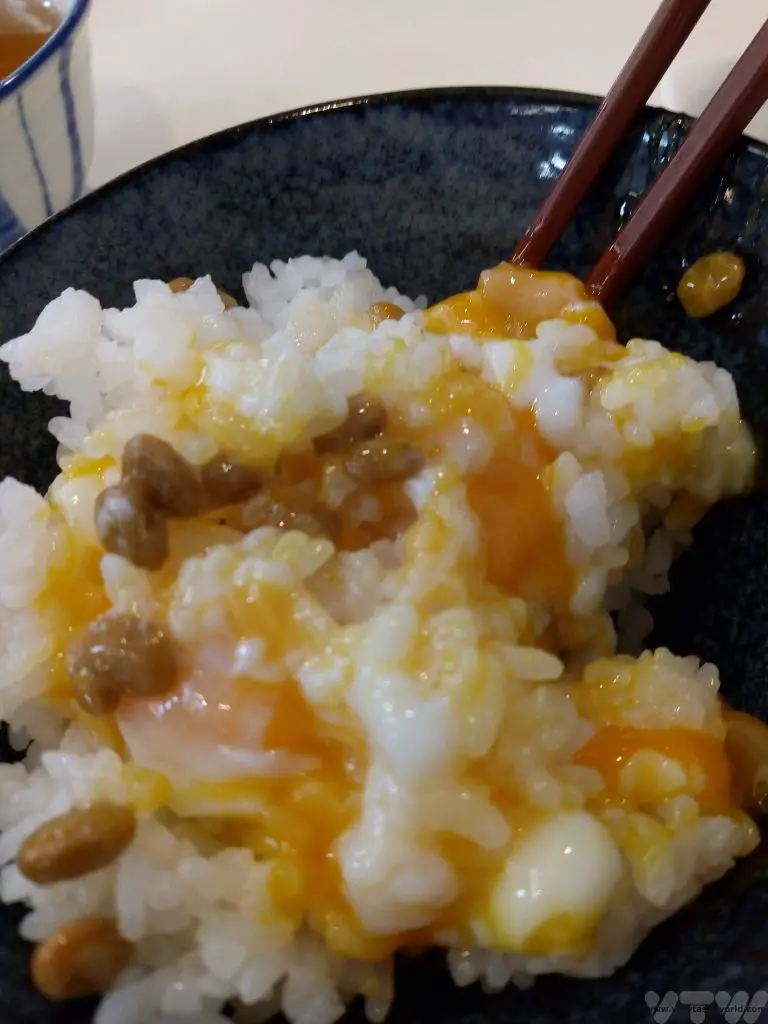
Japanese breakfasts very often include an umeboshi plum – a sour, salty wake-up call, which is reputed to be particularly good for relieving the effects of hangovers. We have a recipe for home-made umeboshi, so that you can always have some to hand!
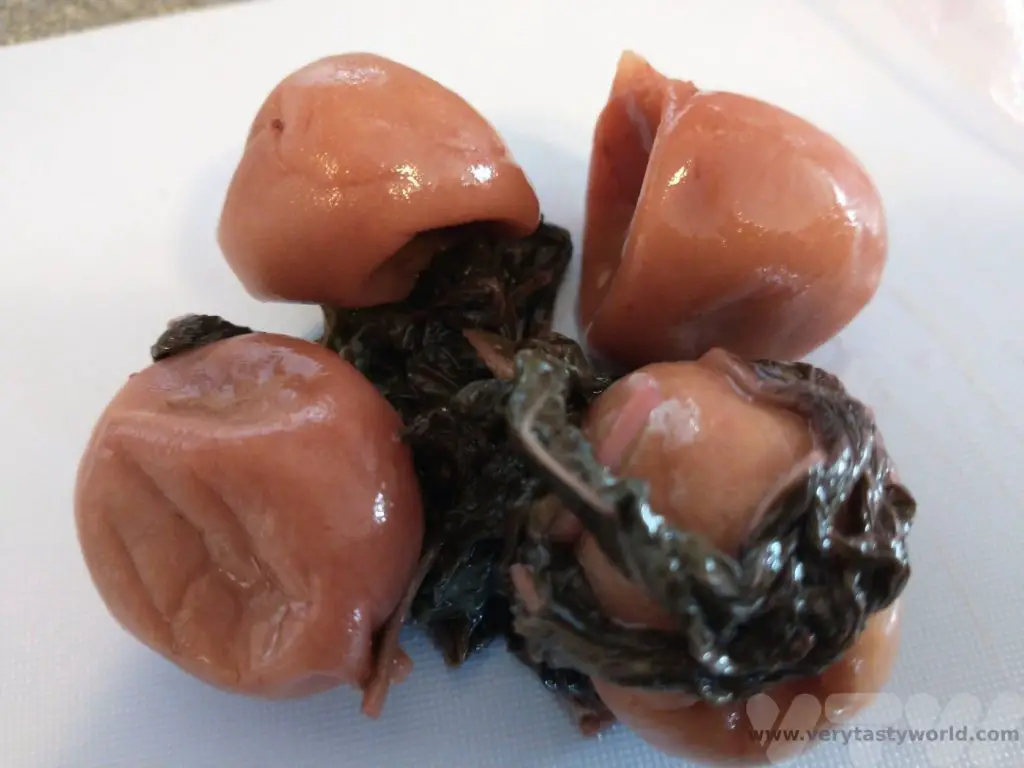
India
A dosa for breakfast in South India is an absolute joy. This is a pancake traditionally made from rice and dal (lentils) which are ground to form a batter and then fermented. The batter is cooked on a hot plate to form a large pancake and served with chutney – coriander, coconut and tomato are particularly popular.

In Kerala, this breakfast comprised vada, which is a doughnut made from fermented pulses and a puffy bread puri served with sambar, a delicious stew made from lentils, vegetables and spices. Multiple chutneys feature as well to provide a variety of flavours that soak into the vada and puri.

It’s Often Okay to Go Off-Menu
It’s quite common for hotels to ask their guests to pre-order breakfast. It makes sense: the hotel staff know what to order in beforehand and this can help minimise food waste. There is usually a form with tick boxes and you can choose from a variety of typical breakfast offerings. But if you do want to eat like a local, we’ve learned that many hotel restaurants are really happy to cook you a regional breakfast.
Uganda
It all started in Uganda when we breakfasted at a lodge with a local guide. We were eating standard fare but our curiosity was piqued when something entirely different was brought out for him. On asking, we learned that it was a rolex – a chapati with a layer of omelette on top, then rolled into a spiral cylinder, perfect for munching on. So the next day we asked the lodge staff if it would be possible for us to have a rolex for brekkie and they were happy to oblige. It’s great – tasty and filling – a good start to the day.

Nepal
In Nepal we were given a standard pre-order form to complete (eggs, bacon, sausage, toast…) to pre-order breakfast for the following morning. We politely asked whether it was possible to have a local breakfast instead. We didn’t specify any dish – just asked for local food. They were delighted. The following morning we were served a marsala omelette accompanied by a joyous curry and roti with home-made yoghurt. It was delicious.

Madagascar
Madagascar is famous for its amazing landscapes and unique flora and fauna and isn’t really known at all for its cuisine. But its breakfasts are great – really hearty and filling. If you want to try a local breakfast, it is best to request it the night before because it takes some time to cook. Rice is the staple in Madagascar, so a typical breakfast includes vary sosoa, or rice porridge. Sometimes it is served with zebu (a kind of cattle) steak for a very rich and decadent breakfast.
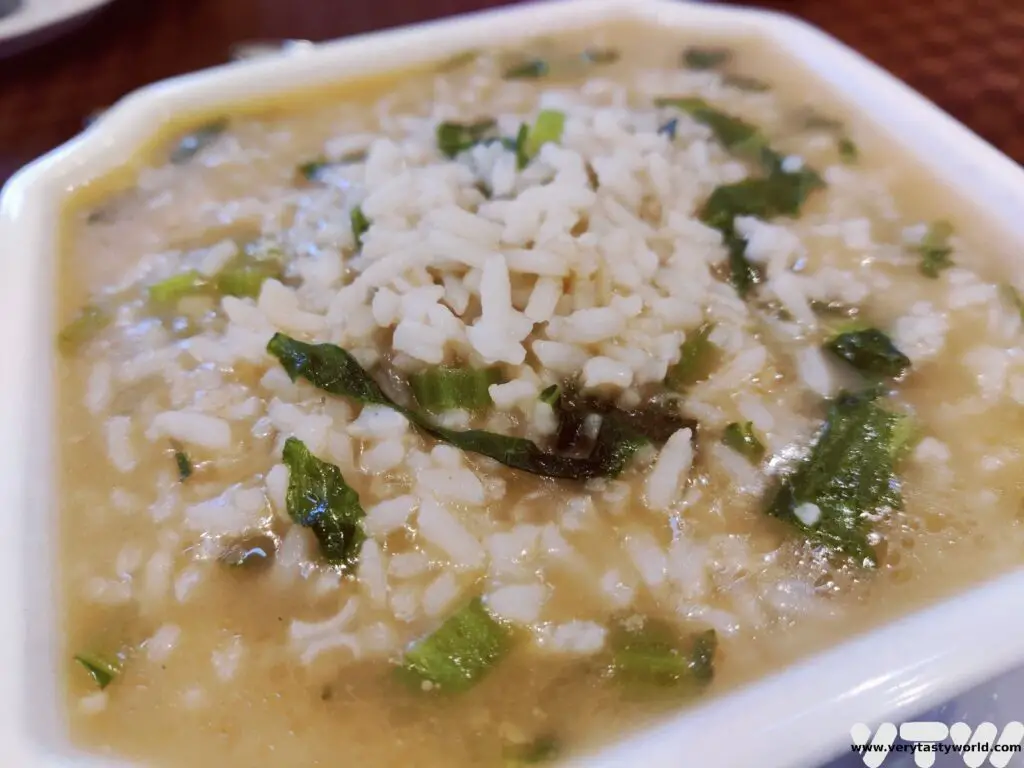
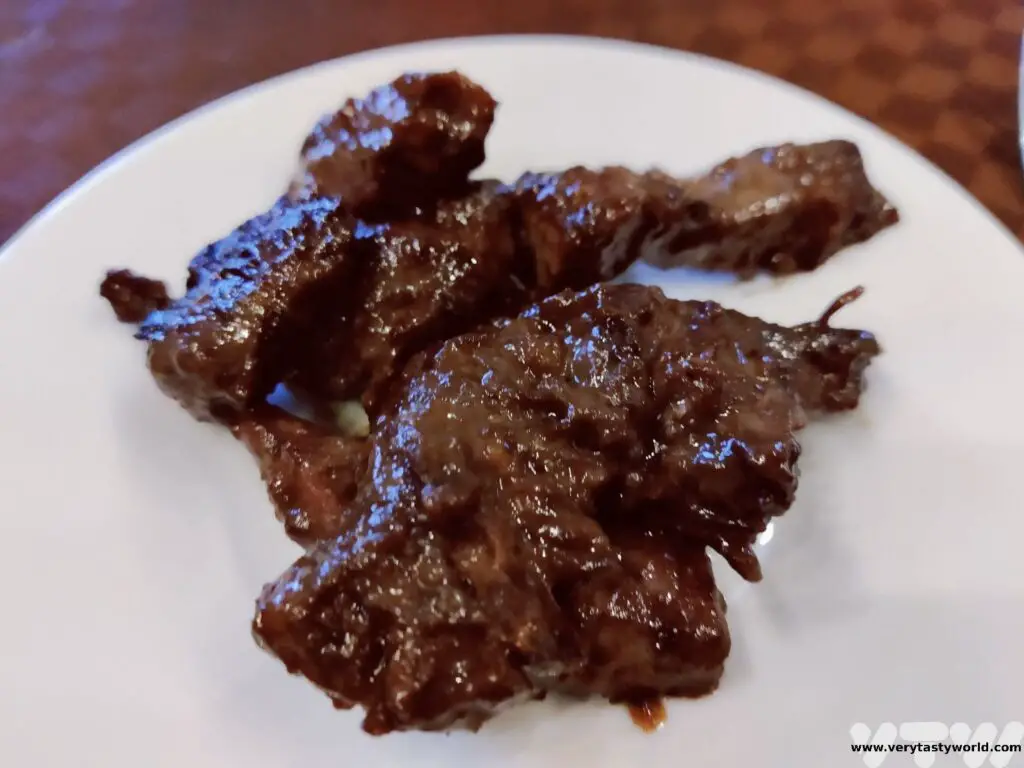
Mofo baoline are fried doughballs. They are very fluffy and filling and will really set you up for the day.
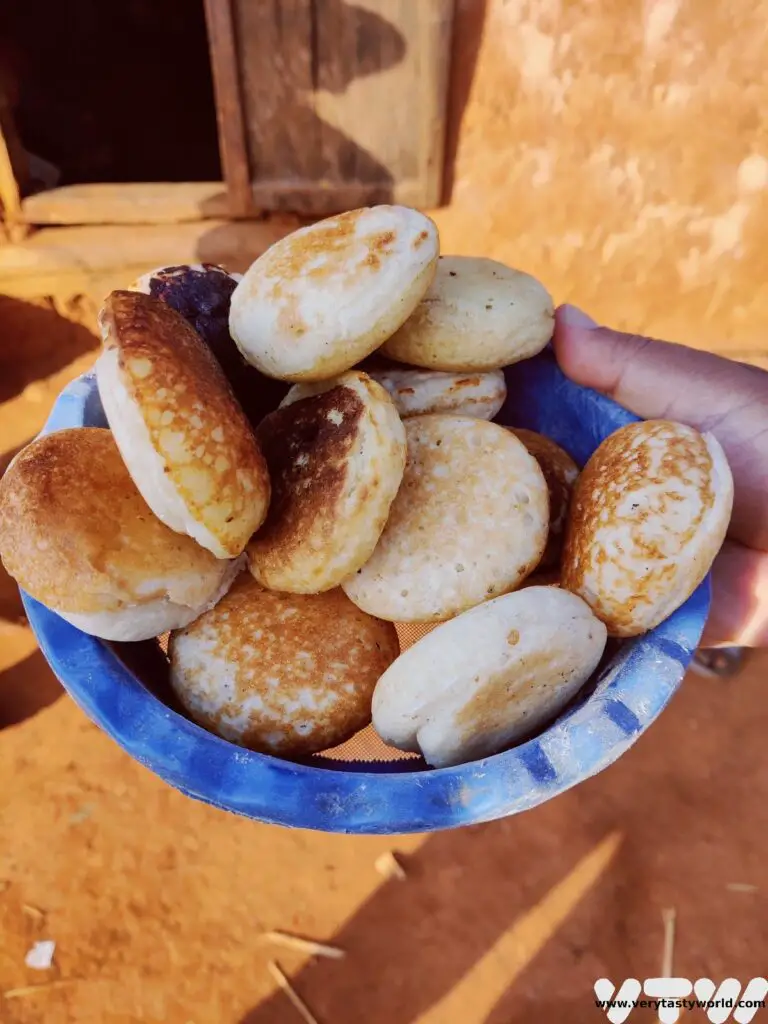
Breakfast, Lunch, Dinner and Breakfast Again
Many countries offer breakfasts that aren’t necessarily only eaten in the morning. When the food is this good, why restrict the dish to the morning?
Costa Rica
One of the world’s best breakfasts is gallo pinto from Costa Rica. It’s so popular it is often eaten for lunch and dinner as well. Which is just as well because it tastes great and is also really healthy. It comprises rice and beans and is usually accompanied by a fried egg at breakfast. Other accompaniments to start the morning include sausage, fried potatoes and some salad. It’s really easy to make and we have a recipe for Gallo Pinto.
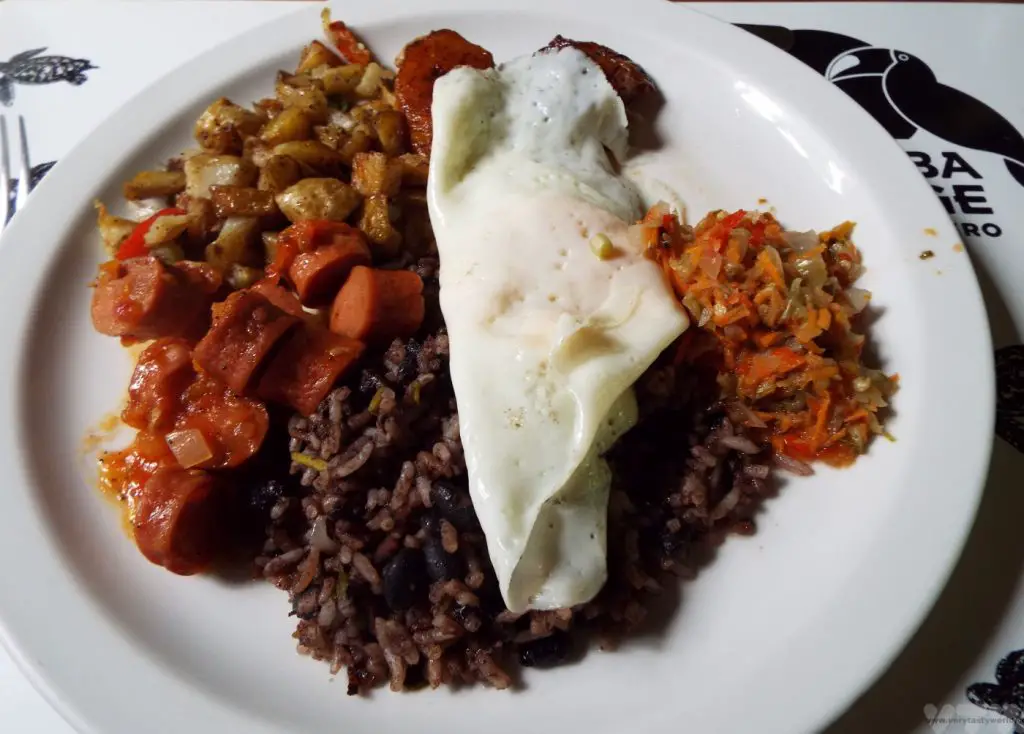
Vietnam
In Vietnam breakfast usually took a buffet form but often there were chefs on-hand to cook some food to order. We were always offered Pho – a tangle of noodles, freshly cooked and served in a yummy broth, topped with meat and vegetables. You pick up a side plate and add herbs, chilli, limes and other delicious items so that you can create your own personalised taste sensation. The liquid of the broth also ensured that we were thoroughly hydrated for the day ahead.
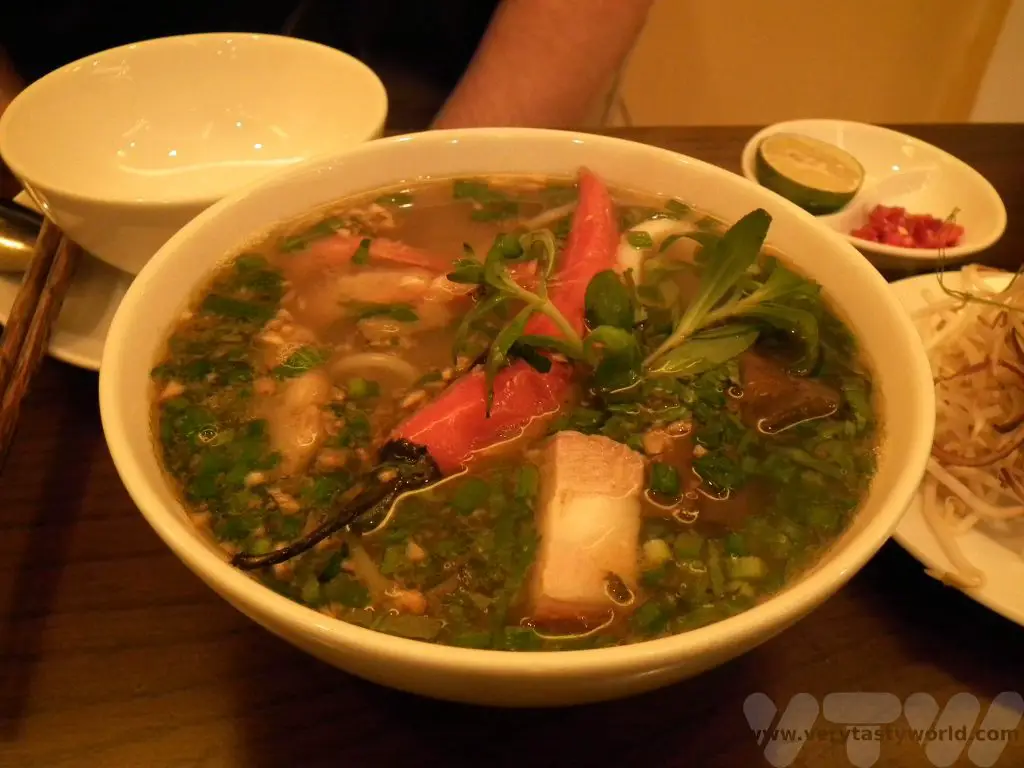
Mexico
We’ve said it before and we’ll say it again: with Mexican cuisine more is always more. There are so many dishes on offer, we didn’t have the same breakfast twice throughout our trip. Tacos with all the trimmings were just as fantastic to eat at breakfast as they were at lunch or dinner (or even for a mid-excursion snack). You can never have too many tacos.

Chuilaquiles are basically tortillas (often leftovers) which form a carb base. Then they are covered in red or green salsa and other ingredients such as shredded chicken, cheese or refried beans.


Tortilla with mole (pronounced molay) makes for a sophisticated breakfast. Mole is famous as the savoury sauce which contains chocolate but it’s so much more than chocolate sauce. It’s actually a very complex sauce, which contains a vast number of ingredients and takes a long time to make. Hotels in Mexico will often provide a sweet, glossy mole but the best ones can be found at the local market.
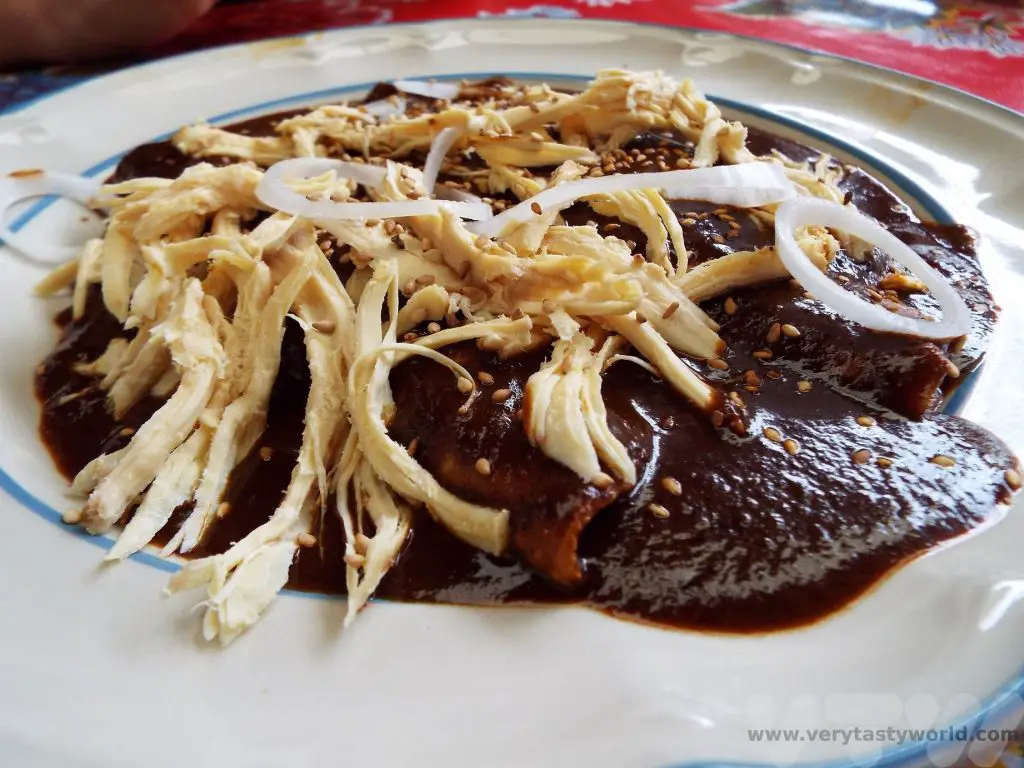
Huevas chiopanecas (below left) are eggs with red sauce and pork tamales (corn dough steamed inside a husk). And huevos coletos (below right) are fried eggs over tortillas with beans and pork sausage, which sounds western enough, until it’s adorned with spicy red sauce.


These dishes are also the sort of food that will be eaten through the day. And quite right too – they are all delicious, so you wouldn’t want to restrict yourself to just the first meal of the day.
South Korea
Like in Mexico, Korean people eat a wide variety of dishes in the morning and many of these aren’t solely for breakfast. Stew, known as jigae, accompanied by rice and side dishes, known as banchan, are popular.


Kimchi also features, as it does with pretty much every Korean meal. It is a spicy fermented cabbage dish and is so popular that most Korean people have two refrigerators – a normal one and a kimchi one. We make our own – you can find our kimchi recipe here.
World’s Best Breakfasts: Minimal Preparation, Maximum Flavour
And there are some brekkies that are surprisingly simple and make full use of great ingredients.
Spain
Andalucia is known as the breadbasket of Spain, and is a region that has more than its fair share of delicious produce. Alongside wonderfully fresh fruits and vegetables, it is the region of Iberico ham, sourced from the black pigs that forage for acorns in the mountains. And in nearby La Mancha, Manchego cheese is a hard cheese made from sheep milk which has a strong, nutty flavour. Sometimes simplicity is the key to a fantastic breakfast.
Pan con tomate is a thick slice of toasted bread, rubbed with olive oil and sometimes garlic, topped with a salsa of crushed ripe tomatoes and just a sprinkling of salt. such a simple dish but it is so delicious. It’s proof that quality ingredients speak for themselves.


Germany
A German breakfast is clever because it really needs minimal preparation in the morning. the perfect way to start the day is to get up and eat.
Key to its deliciousness is the bread. There are over 3000 types of bread in Germany, both breakfast and evening breads. There are so many varieties of tasty Brot (breads) and Brötchen (rolls) for brekkie – white breads, rye breads, whole-grain, wheat-rye and many, many more. There are so many variations, sometimes they are seeded or nutty, all are hearty, filling and a perfect vessel for sweet or savoury delights.
So what can you put on your bread: a variety of meats, cheeses and smoked fish or, if you have a sweet tooth, jams and honey. Honeycomb, dripping with sweetness, slathered over a slice of buttered bread, is a thing of joy. And how can you not love the fact that every September 25 Germans celebrate Butterbrot Day – a day of bread and butter?

Scandinavia
A Norwegian breakfast is savoury. Local seafood is amazing so fish features heavily in the first meal of the day. This may be smoked salmon or pickled herring in a variety of marinades. Bread with pålegg – a spread – is common.
Norway also offers some unusual cheese – brown cheese, called Brunost. This is one of the strangest cheeses we’ve tried because it uses what is normally considered to be the waste product from cheese-making – the whey. Whey boiled with cream results in caramelisation which gives the cheese its distinctive brown colour. A slice of cheese atop a slice of bread is an important part of a typical breakfast.
And you are always guaranteed a great cup of coffee – or three – when visiting Scandinavia. Coffee is an essential part of breakfast.

World’s Best Breakfasts – Back At Home
And, of course, whenever we are staying away from home in the UK, we’ll always have an honest-to-goodness fry-up. Sausage, bacon, egg (usually fried, poached or scrambled), black pudding, mushroom, tomato, beans and sometime a hash brown are the usual components.
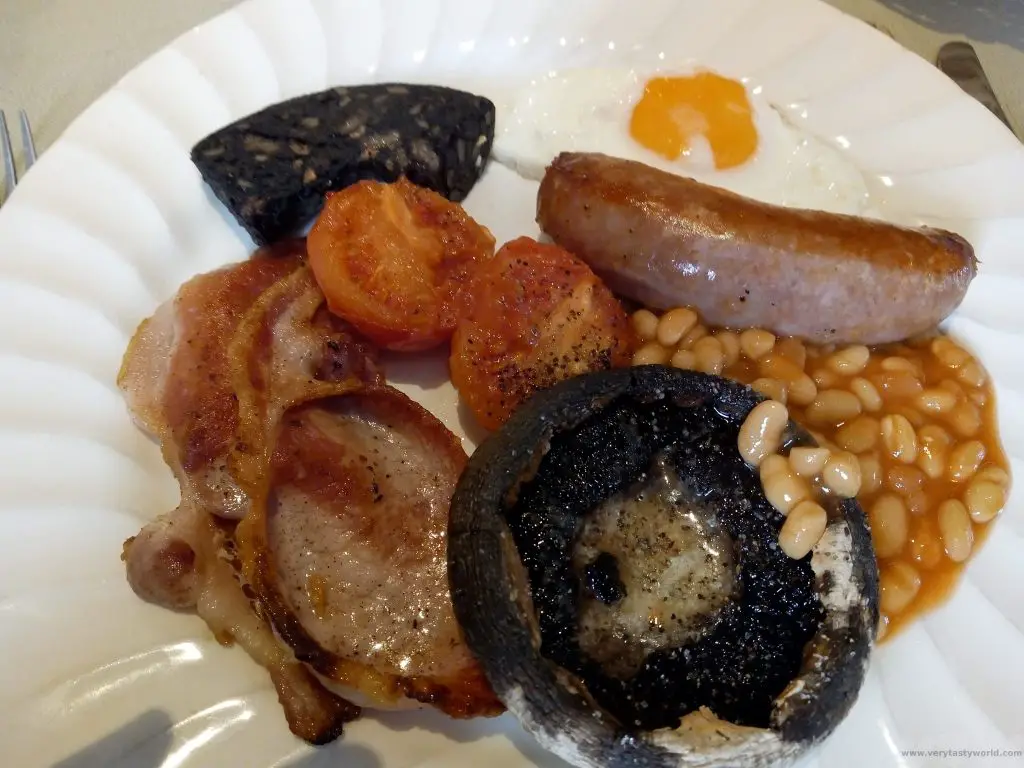
We recently discovered that the best possible place for a full English breakfast that we’ve ever eaten is actually in our home town. While many top breakfast establishments boast locally sourced food (which is, of course, delicious) some go one step further to cure their own bacon and make their own sausages and black pudding. And that’s just the start: The hash brown (never the most fabulous component of a British breakfast) is a home-made bubble and squeak, a glorious blend of fried potato and cabbage. The beans have never seen a tin – they are home-made baked beans in a rich tomato sauce. There is even rich and tangy brown sauce to accompany the feast.
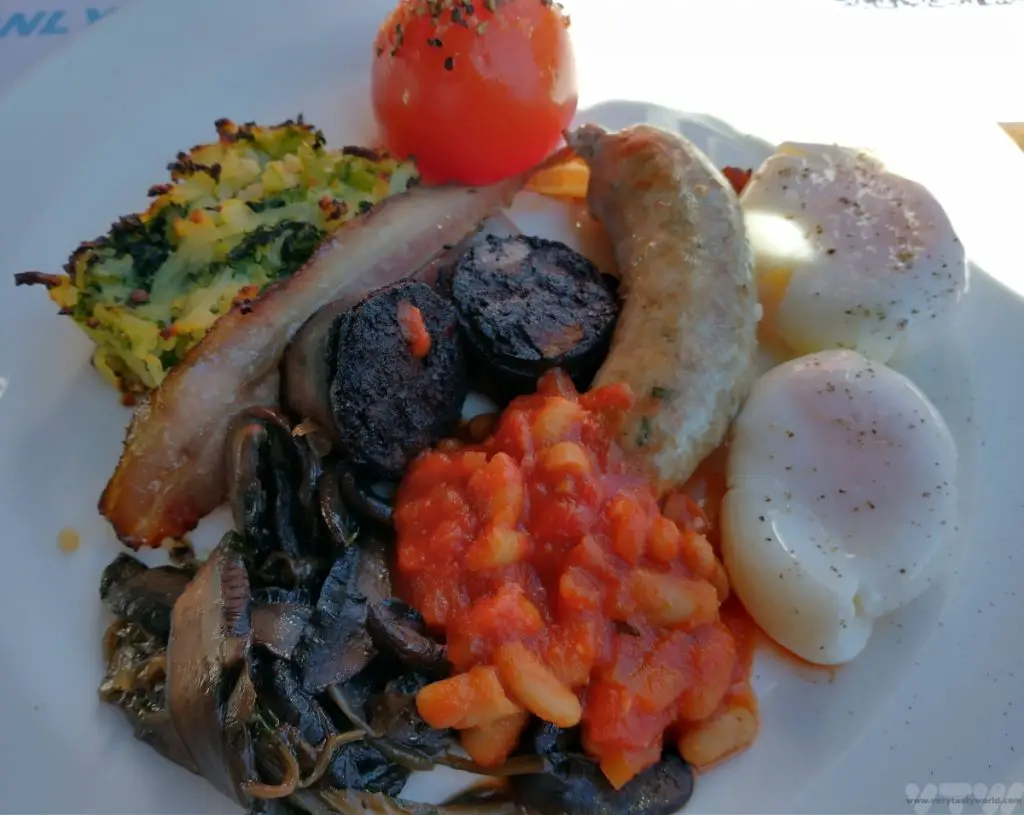
These are our favourite breakfasts from around the world. Do you have a favourite? Let us know!
Related Posts You May Enjoy

- RECIPE: How to Make Sushi Ginger – Gari
- RECIPE: How To Make Elderflower Champagne
- RECIPE Oyakodon Donburi
- Zero Waste Recipes Before Your Holiday
- RECIPE: Vegetable Biryani Tamil Nadu Style
- RECIPE: Vegan Wild Garlic Pesto
- Recipe: Venetian Pasta Sauce
- RECIPE: Biryani Raita Recipe
- RECIPE: How to Make Costa Rica’s Gallo Pinto

- Heart and Seoul – Four Days in Seoul
- An Essential 2 day Gyeongju Itinerary
- A Korean Table Setting – Eating Out in Korea
- How To Get From Seoul To Gyeongju by Train
- A One Day Hanoi Itinerary
- Mekong Meanderings

- RECIPE: Vegetable Biryani Tamil Nadu Style

- RECIPE: Biryani Raita Recipe

- The Leh to Manali Highway
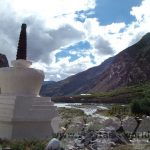
- Places to Visit in Munnar, Kerala
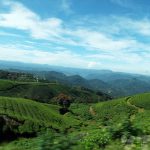
- Kumarakom Houseboats on the Kerala Backwaters
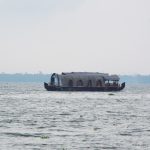
- The Golden Temple Amritsar, India
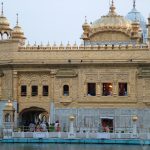

Thanks so much for reading. We hope you enjoyed this article. If you’d like to keep up to date with new posts and recipes, please subscribe to our newsletter or follow us on social media – X, Facebook or Instagram. We always love hearing from you and would be delighted to read your thoughts about this article.
Skeleton Coast Self Drive in Namibia
Namibia is a perfect country for a fly-drive holiday. The roads are wide and, outside the towns and cities, virtually empty, which makes for really easy driving. You can drive for thousands of kilometres across spectacular scenery, encounter amazing wildlife and even take yourself on safari. The country’s Atlantic coastline, known as the Skeleton Coast, is wild and desolate. Here is our guide to a Skeleton Coast self drive itinerary – what you need to know and what to expect.
Please note that this post contains affiliate links. If you click through and decide to make a purchase we will make a small commission, at no extra cost to you, which will help towards the costs of running this site.
We particularly wanted to explore the Skeleton Coast, where the Namib Desert meets the South Atlantic. It is a place that is truly wild and lives up to its name – where the skeletons of animals and shipwrecks are scattered across the desolate sandy beaches. The coastline is incredibly long and large parts of it totally inaccessible.
Swakopmund
Swakopmund is located on the wild Atlantic coast in the very west of Namibia. It is the major city on the Skeleton Coast and its name means ‘mouth of the Swakop’, a reference to the river that flows out to sea. Swakopmund was founded in 1892 by Captain Curt von François as a German colonial city. Originally a trade port it has since become a tourist destination. It still retains much of its colonial architecture although many of the street names have changed since Namibia’s independence in 1990.
It is very much a resort town and there are plenty of activities to enjoy. It is also the gateway to exploring the Skeleton Coast.
How to Get to Swakopmund and the Skeleton Coast
The city is located around 350km west of Namibia’s capital Windhoek. Public transport options are available if you just plan to visit Swakopmund but if you want to explore the Skeleton Coast, it is better to rent a car. A 4-wheel drive isn’t needed as Namibia’s roads are well-made, easy to navigate and are usually clear of traffic. Some of the roads are constructed from gravel but they are broad and well maintained. And the scenery along the route is guaranteed to be wonderful.
Activities in Swakopmund
We recommend spending a couple of days in Swakopmund. The city has some museums and an art gallery and there are a plethora of activities, from nature tours to adrenaline-fueled adventures, such as hot-air ballooning or even skydiving. Swakopmund has a long and extensive beach but, while it is theoretically possible to go swimming in the sea, it’s not really a place for a traditional beach holiday. The Atlantic is cold and the currents can be strong and potentially dangerous and you should never swim unless there is a lifeguard on the beach.

We had driven to Swakopmund from Windhoek via the amazing red sand dunes of Sossusvlei and spent a couple of days in town, taking part in all sorts of adventuresome activities.
There are loads of tour operators in town that offer activities and you can make bookings with them directly. Some activities, such as the hot-air ballooning need some notice, for others you may be able to book on the day. If there is an activity you particularly want to try we recommend booking in advance.
Kayaking on Walvis Bay
One of the best things to do is to visit nearby Walvis Bay and see the seal colony. Walvis Bay is a natural harbour located a short 45 minute drive straight down the coastline to the south of Swakopmund. It’s also possible to rent a kayak and paddle amongst the friendly seals.
The sea is calmer in the morning, so it’s worth making an early start. You drive to a pickup point and are then driven to Pelican point in a 4WD.
It was a touch foggy when we visited – this often happens when the warm air from the desert clashes with the cool temperatures of the coast – but it gave the bay an ethereal feel.
Bring swimwear, water, sunscreen and a hat – you might get lucky with the sunshine! It’s also worth bringing a towel and change of clothes in case you get wet.
Up to 50,000 Cape fur seals, also known as African fur seals, live in the area. They can be incredibly curious and it is lovely to be able to kayak amongst them. They are happy to swim alongside the kayak.

If you don’t wish to go kayaking there are boat trips to Walvis Bay from Swakopmund.
Exciting Activities In and Around Swakopmund
There are a plethora of companies that offer a range of exciting activities. We indulged in a few. Most operators offer a pickup from your accommodation
We couldn’t miss the chance to go hot-air ballooning over the Namib desert. An early start at the crack of dawn, we were picked up and taken to a quiet location a few kilometers out of town. Our host assembled and inflated the balloon.

The sun was glowing gently in the sky by the time we clambered into the basket and took off. The view of the vast and lonely desert from above was sublime. We climbed high then glided low, skimming the desert just a few feet above the sands before soaring skyward again. There was nothing to hear but silence, occasionally interrupted by the whoosh of the gas burner.

We also enjoyed some other exciting activities including parasailing and quad biking.


Swakopmund For Foodies
Being right on the coastline, Swakopmund is a fantastic place to enjoy seafood. One of the best restaurants is The Tug, where we enjoyed our most decadent meal. The Tug restaurant is located on a jetty right on the coastline and, as its name suggests, was constructed around a Danie Hugo tug-boat. Naturally the restaurant specialises in seafood. And you can look out to the wild Atlantic as you dine.

We ordered a sharing dish – the seafood extravaganza, an indulgent seafood feast. It comprised rock lobsters, kabeljou and kingklip fillets, juicy prawns cooked in their shells and the softest melt-in-the-mouth calamari we had ever eaten. All washed down with a crisp white wine.
Exploring The Skeleton Coast
Having dosed up on adrenaline we then packed up our car and headed north along the remote Skeleton Coast.
This is one region that we particularly wanted to explore. It is a place that is truly wild. It was going to be a full day’s journey along an isolated road through the Skeleton Coast National Park.

Our plan was to drive up the C34 and D2302 (basically the same road) from Swakopmund, exploring the coast along the way, and arrive 350km later at Terrace Bay for an overnight stay. We would then leave the park the following morning at the Springbokwasser gate on the D3245 to drive inland and explore Damaraland and eventually Etosha.
Preparation For The Skeleton Coast Self Drive
You need to buy an entry permit. If you are simply driving through the park you can get the permit at the gate. But if you wish to stay you must get an overnight permit beforehand. If you are planning to lodge at Terrace Bay you must pre-book and get your confirmation permit which you will need to show at the office when you enter the park at the main gates. You can get one at the office in Swakopmund (located near the Woermann & Brock Arcade). Permits are also available in Windhoek.
You need to arrive at the gate before 3pm, otherwise you will not be allowed into the park.
You don’t need a 4WD to drive the C34 but you should stay on the road if you’re not driving one – or if you are driving one but don’t know how to engage the four-wheel drive.
We also recommend hiring a car with at least one spare tyre. Punctures on gravel roads can happen quite frequently and this area is very remote, so you may need to change a tyre yourself should you get a flat tyre.
Accommodation Options
There aren’t many options for accommodation in this area. The Namibia Wildlife Resorts website has details of some of the resorts available.
Torra Bay – about 100km from the gates, which offers camping facilities. It is only open at certain times of the year, so you will need to check availability.
Terrace Bay – continue for a further 60km on the D2302 to this resort on the coast which offers basic accommodation in chalets.
Shipwreck Lodge – you can drive beyond Terrace Bay for a further 82km to Mowe Bay and arrange a pickup (strict times apply) to Shipwreck Lodge. This private lodge offers more luxurious accommodation and a number of activities.
The Drive From Swakopmund to Terrace Bay
We decided to spend a night at Terrace Bay. It is a four and a half to six hour drive from Swakopmund, so we recommend leaving early.

If you are renting a 2WD, stay on the road. If you’re renting a 4WD you may be able to drive along some of the side tracks.
We passed by the smelly Cape Cross seal colony and onto the park.
The gates are excitingly ominous. You need to register on arrival.

Once we had entered the park we saw just one other car during the entire day.
We were driving a two-wheel drive car so kept to the road but our plan was to break up the drive by stopping off at various points along the way to explore the wild, windswept beaches, observing shipwrecks and other skeletons. The area is quite often misty but it enhances the enigmatic nature of the stark landscape.



Our final destination was the Terrace Bay resort, near the Uniab River Delta. It’s very remote and popular with anglers and there aren’t a huge number of things to do when you get there.

Travelling along the Skeleton Coast is more about the journey than the destination. But if you like wild, wide and desolate regions there is plenty of walking along the beach and across the dunes. It’s possible to encounter a variety of local seabirds in the area.

Facilities At Terrace Bay
The accommodation in chalets was pretty basic but perfectly adequate.

The car was filthy. We didn’t have a choice with car colour when we rented it, but white really wasn’t the best colour to travel along the coast with. (The terms of our rental stated that we needed to refuel and ensure the car was clean. It was very easy to find a local garage on our way back to Windhoek where we could get the car cleaned – but we did this the day we returned the car!)
Food at Terrace Bay was taken in a communal dining hall. Because the area is so remote, we weren’t expecting a brilliant meal. It may have been a far cry from The Tug’s seafood extravaganza that we’d enjoyed the night before, but our dinner was good old fish and chips and they were absolutely great.
There aren’t many facilities at Terrace Bay but, importantly, there is a petrol station. We recommend keeping your fuel topped up while on your trip. Throughout our trip we made of point of stopping at every petrol station we came across, to make sure we always had enough in the tank.
There is also a small shop that will sell essentials for your journey.
It is possible to explore further along the coast up to Mowe Bay and from there you could be picked up and transferred to Shipwreck Lodge (although this would have to be pre-arranged). Any further north and you would have to fly. We decided not to do this leg of the trip, so headed south and then inland towards Damaraland, stopping to admire the famous Welwitschia plant, some of which can live to be over a thousand years old, and eventually on to the Etosha National Park.
The Skeleton Coast is remote and evocative. As a destination, it isn’t for everyone, but if you like wide, open spaces and landscapes that are strangely beautiful – in a wild and desolate kind of way – a Skeleton Coast self drive trip is a worthy addition to a Namibia itinerary.
Related Posts You May Enjoy

- Skeleton Coast Self Drive in Namibia

- Malagasy Cuisine – The Food of Madagascar

- Mora Mora on the RN7 Madagascar – A Road Trip

- Tree Climbing Lions, Hippo Hordes and Safari Shenanigans in Uganda

- Tourist Attractions In Ethiopia

- Uganda Chimpanzee Trekking in Kibale


Thanks so much for reading. We hope you enjoyed this article. If you’d like to keep up to date with new posts and recipes, please subscribe to our newsletter or follow us on social media – X, Facebook or Instagram. We always love hearing from you and would be delighted to read your thoughts about this article.
